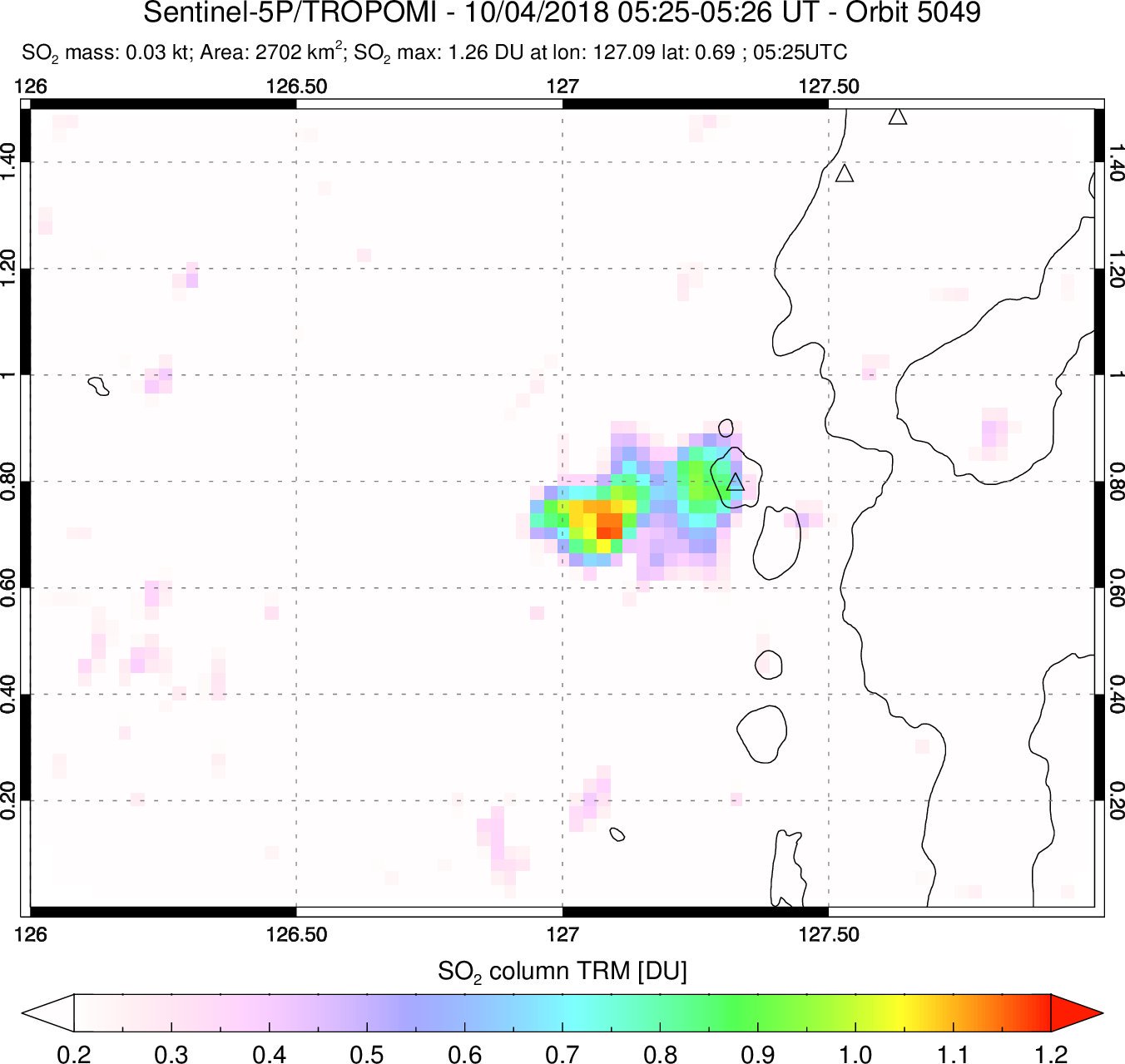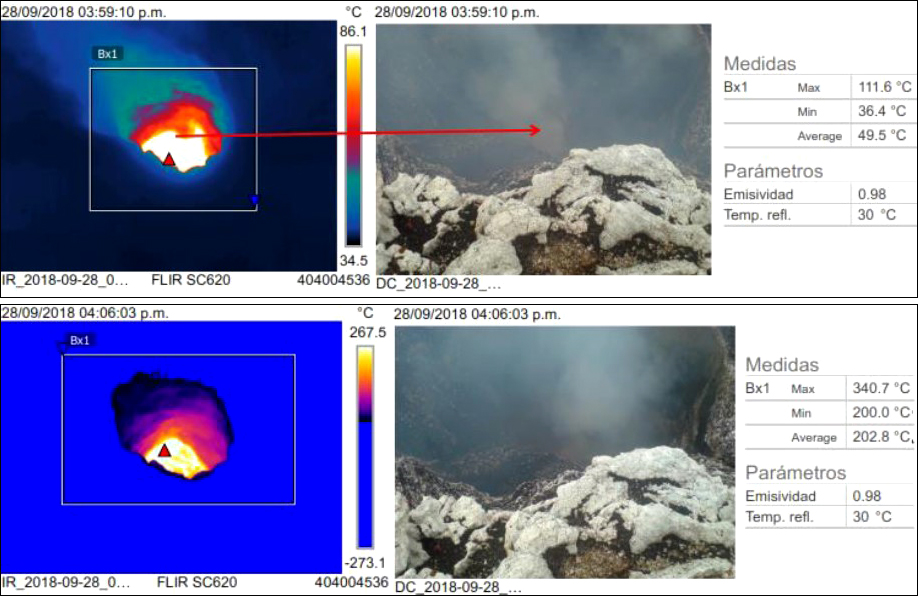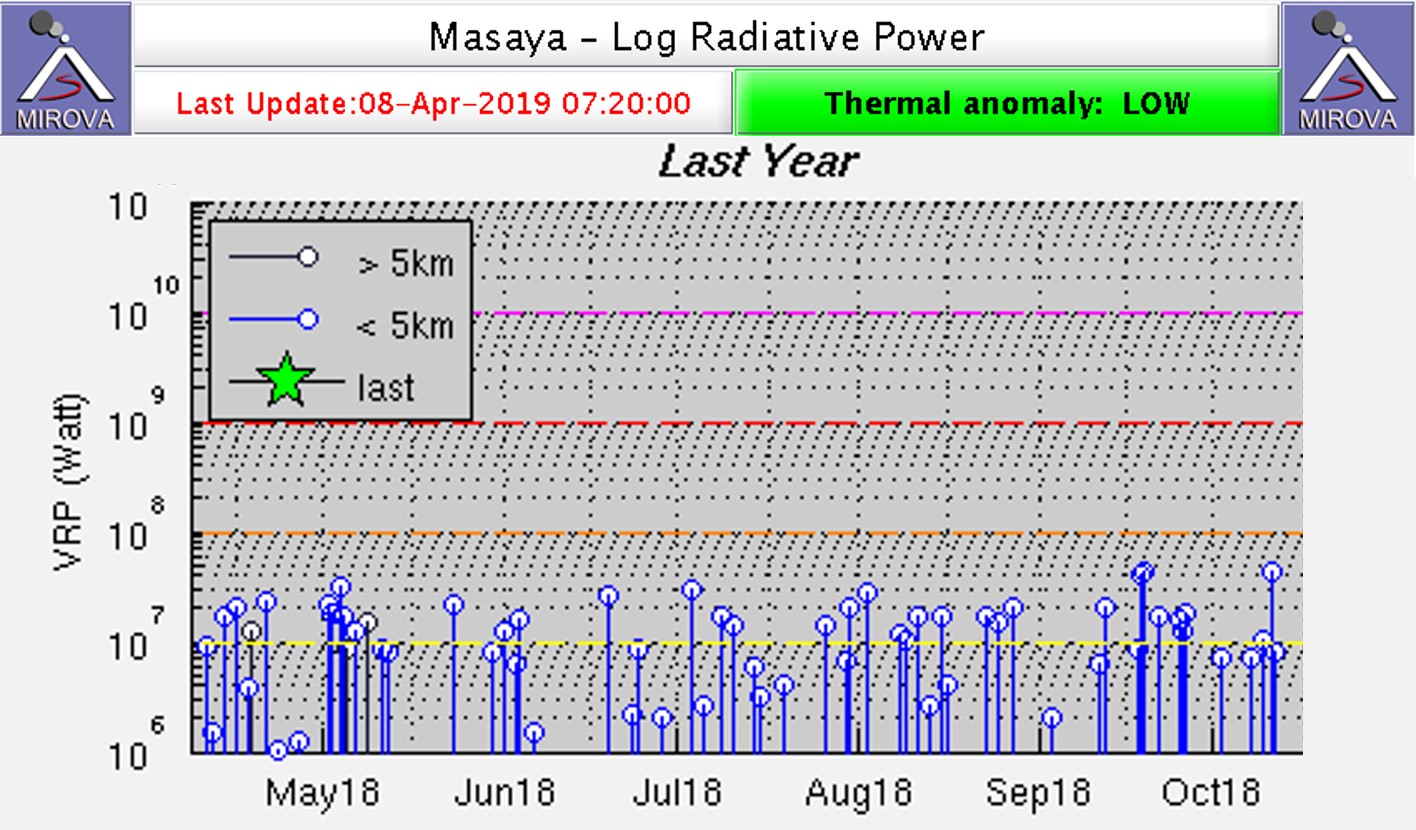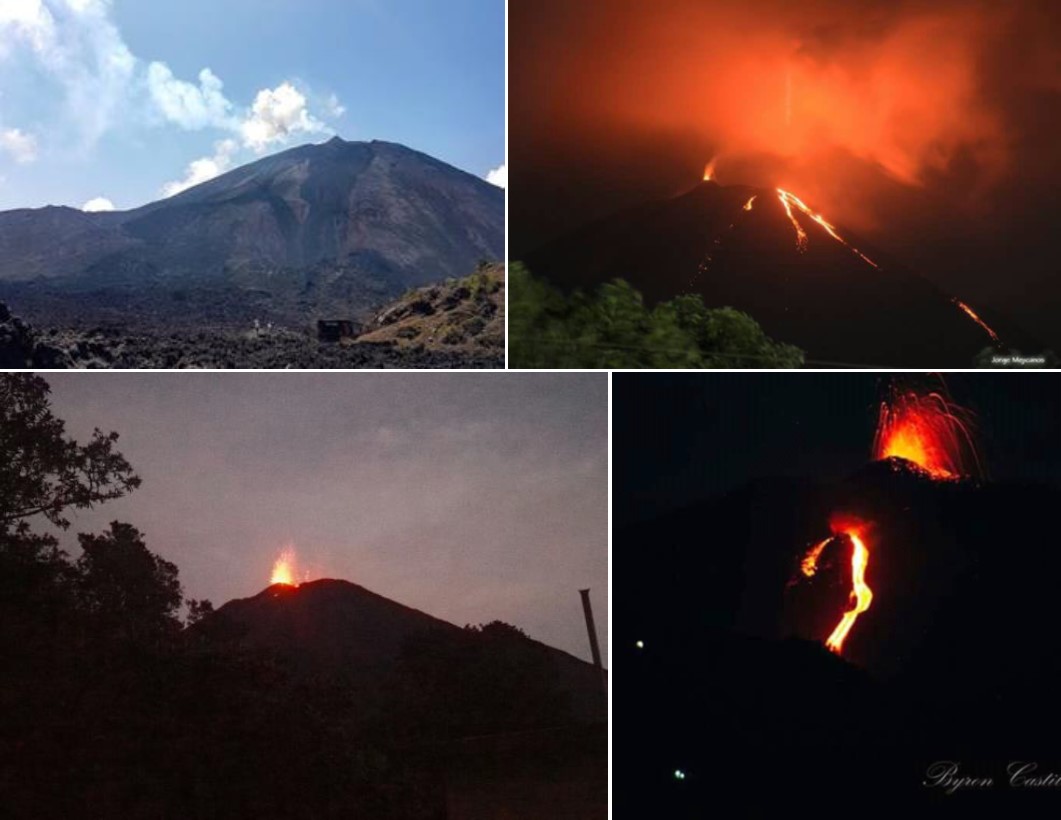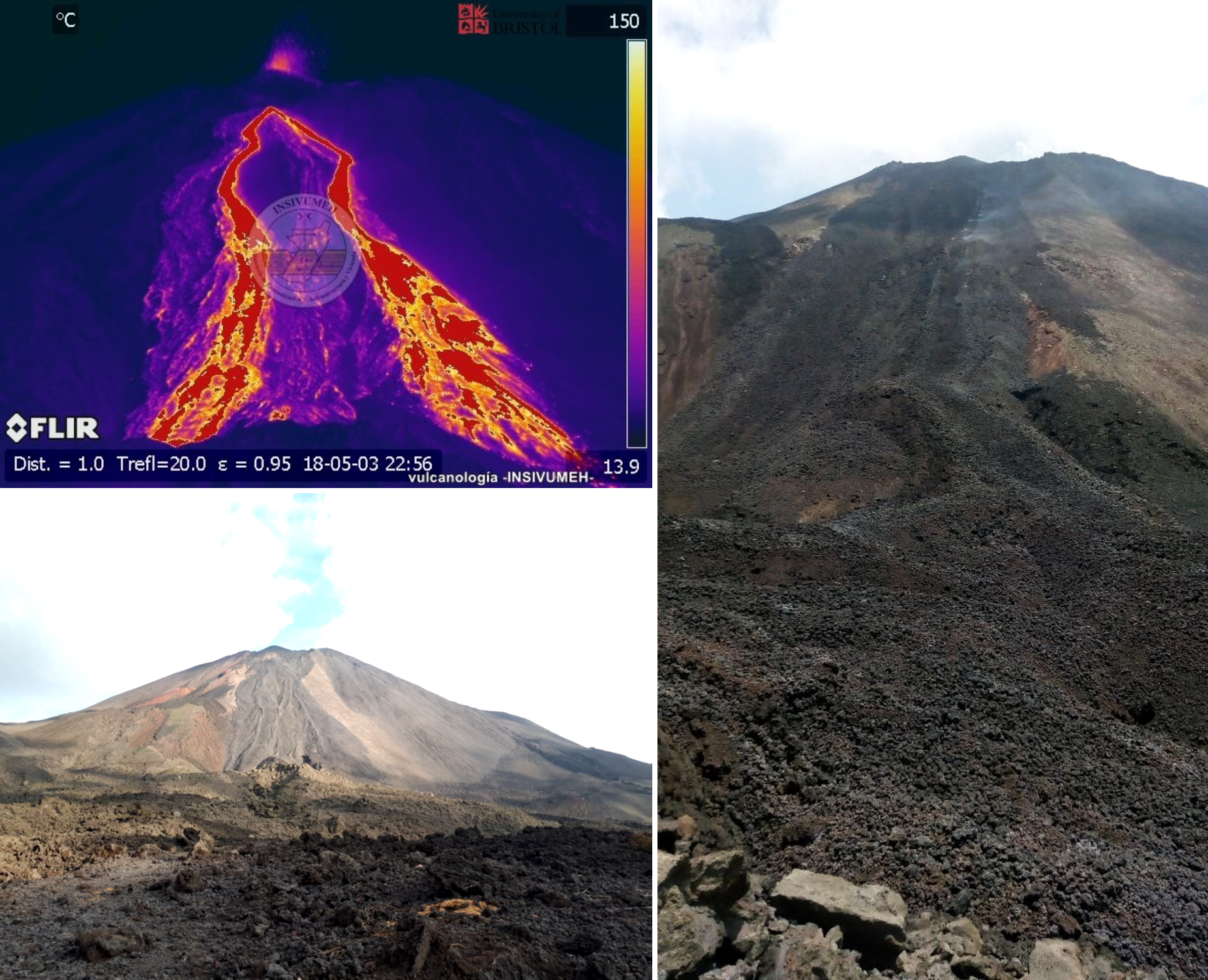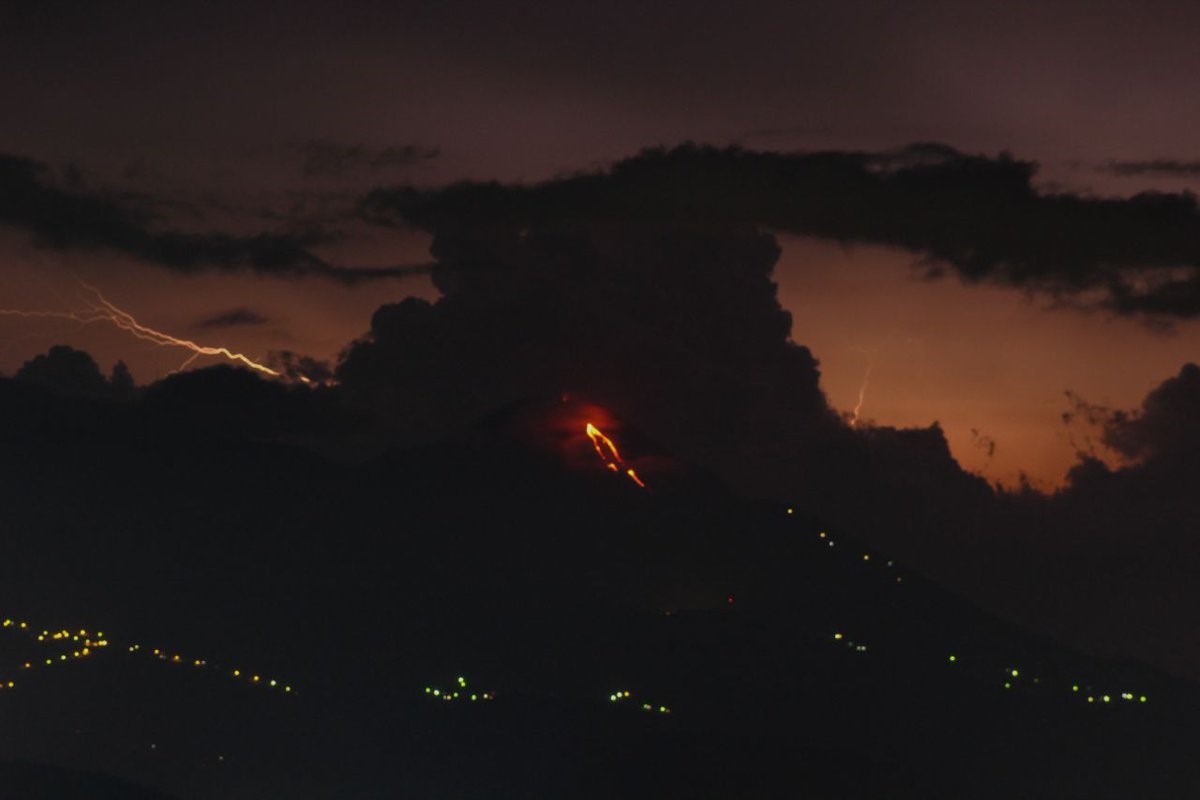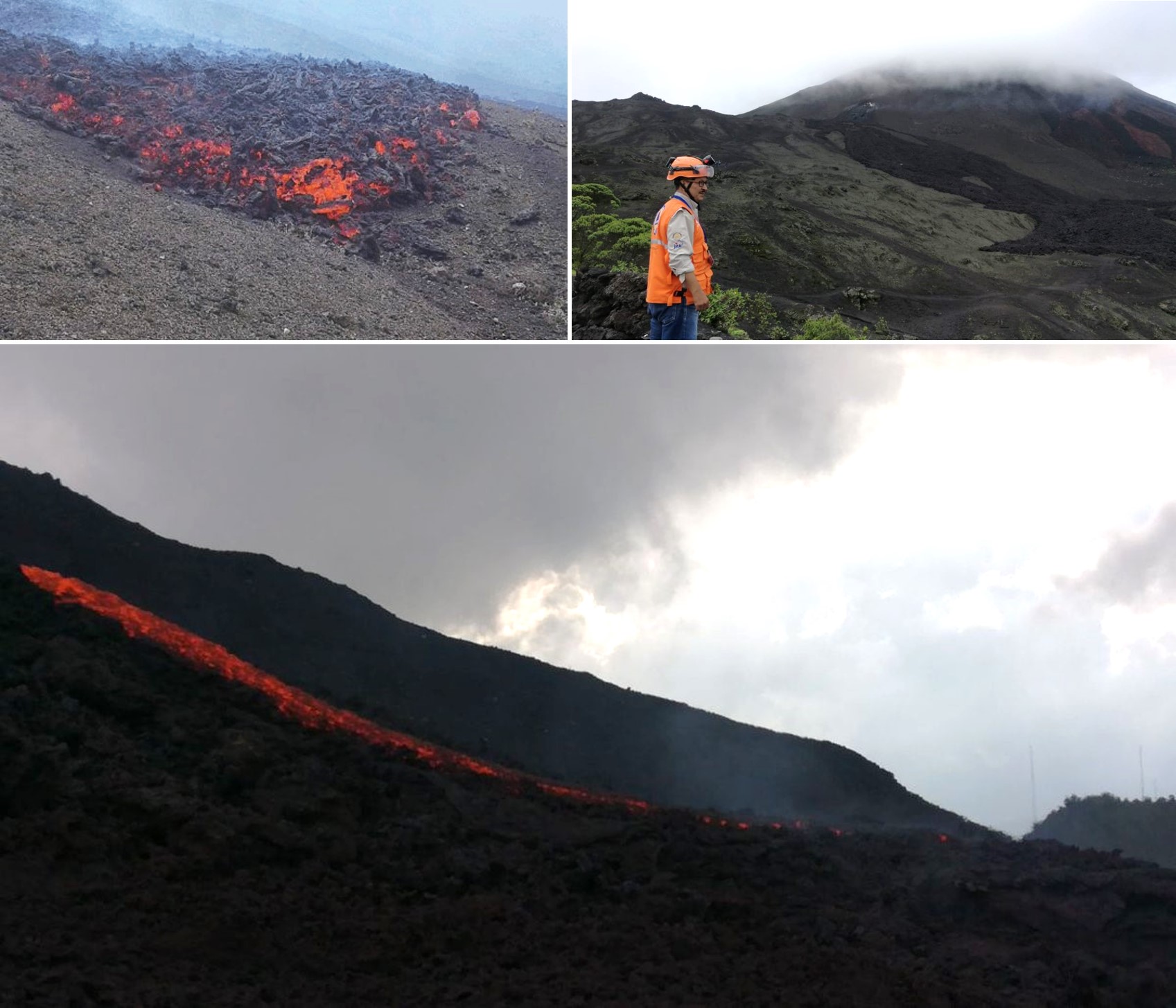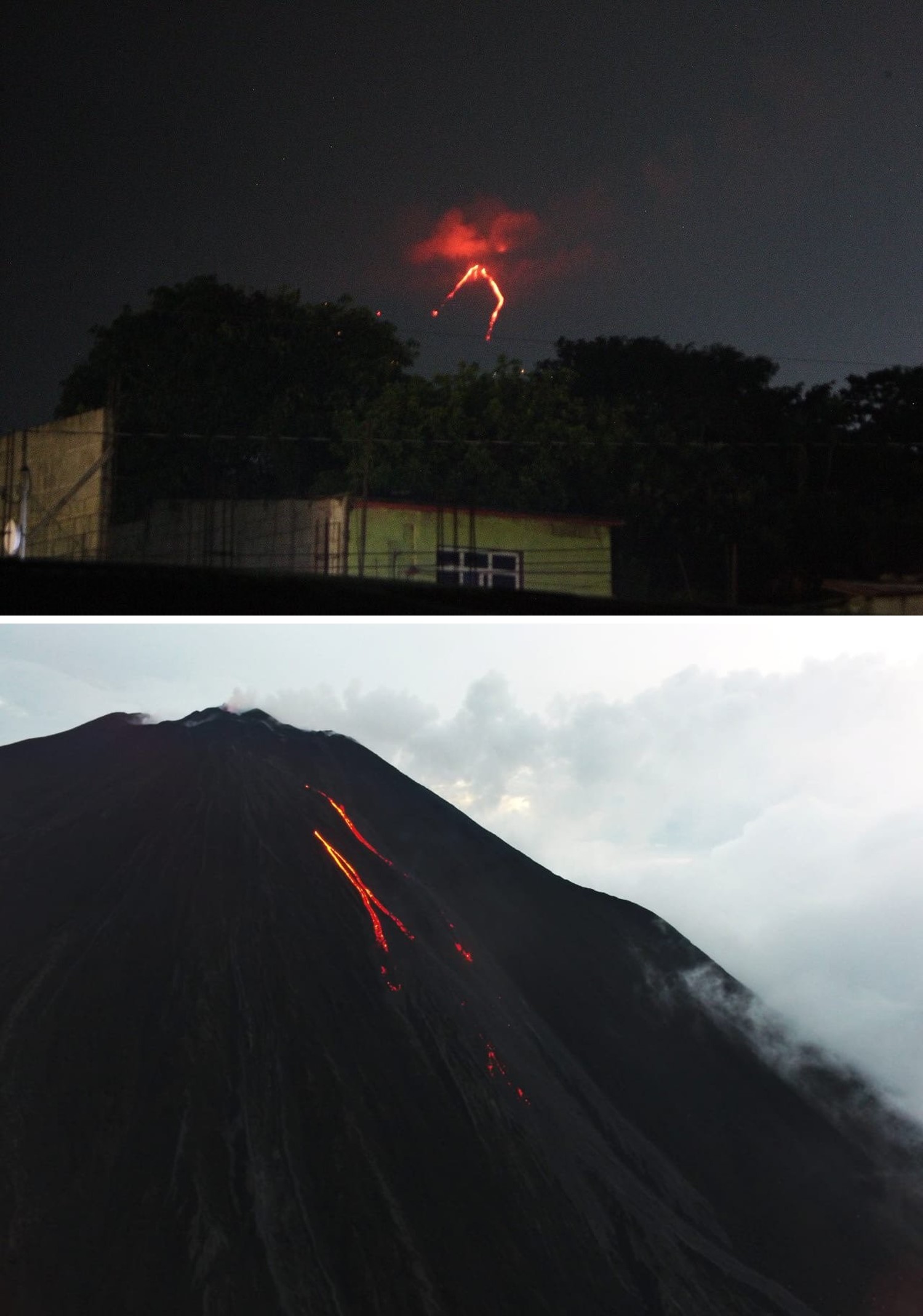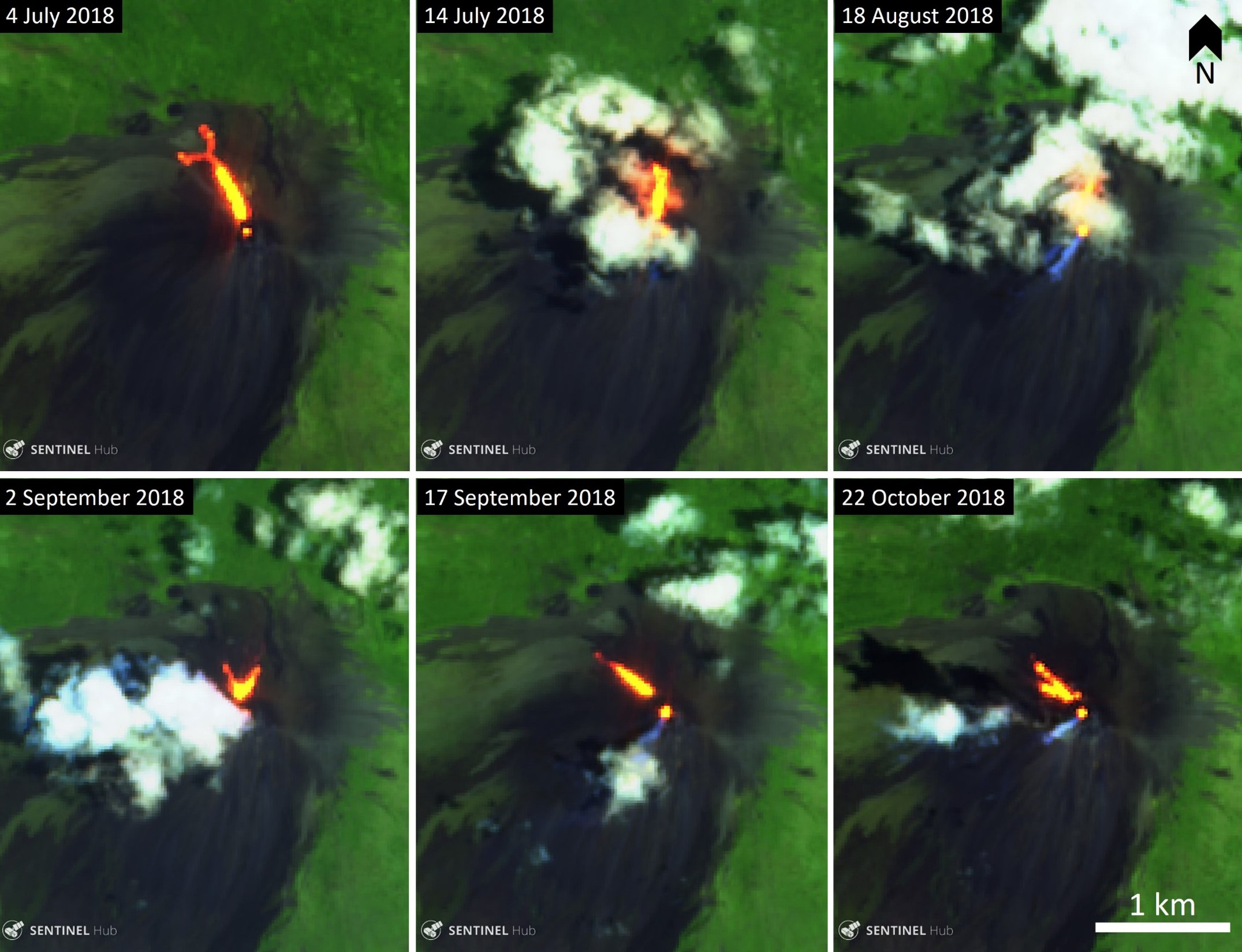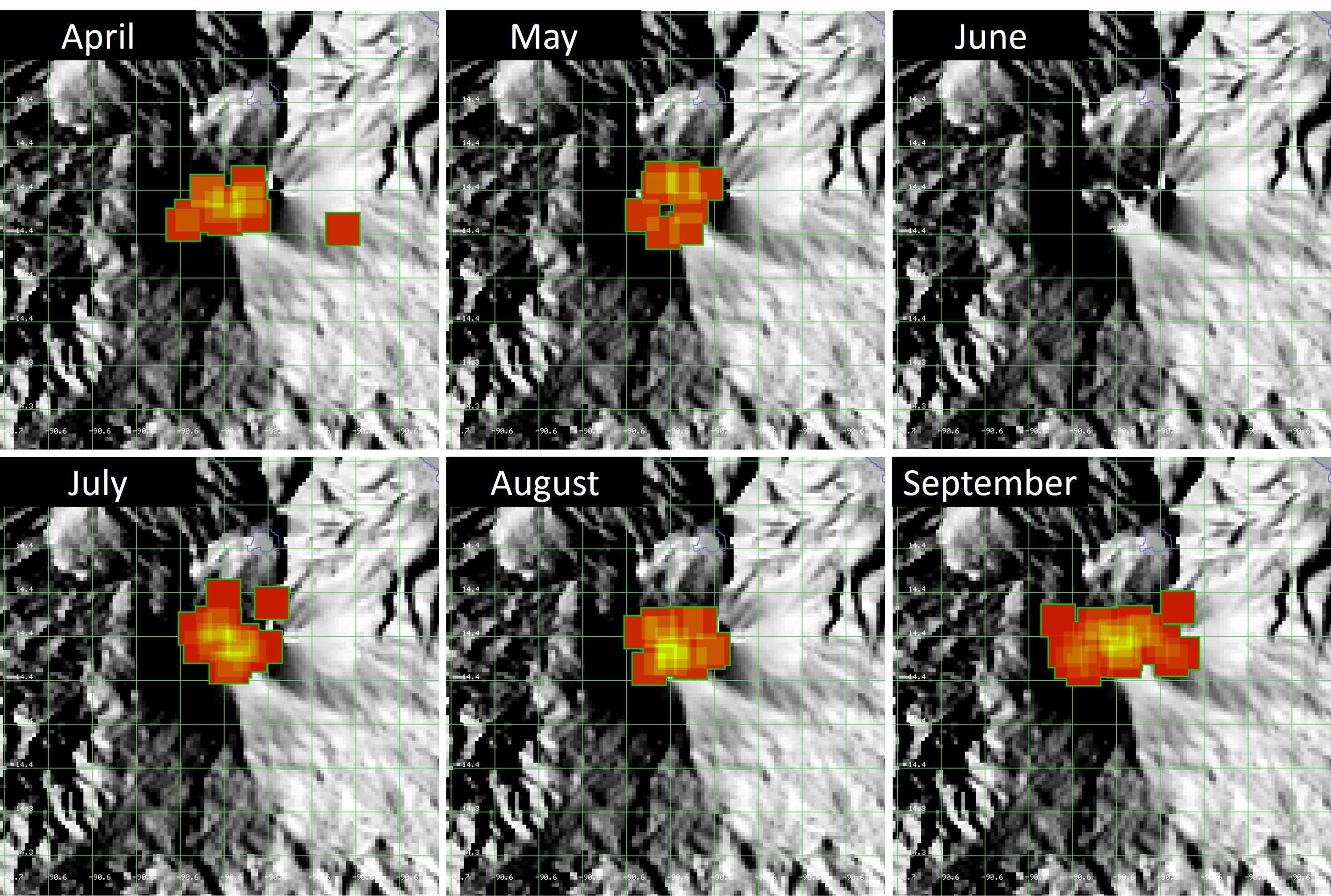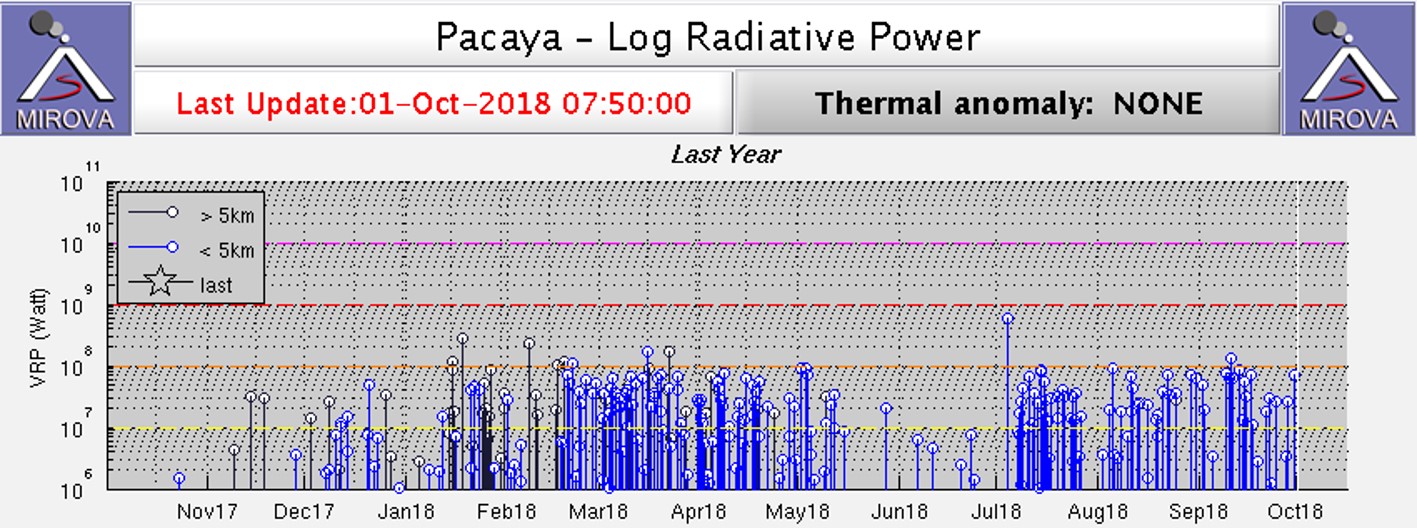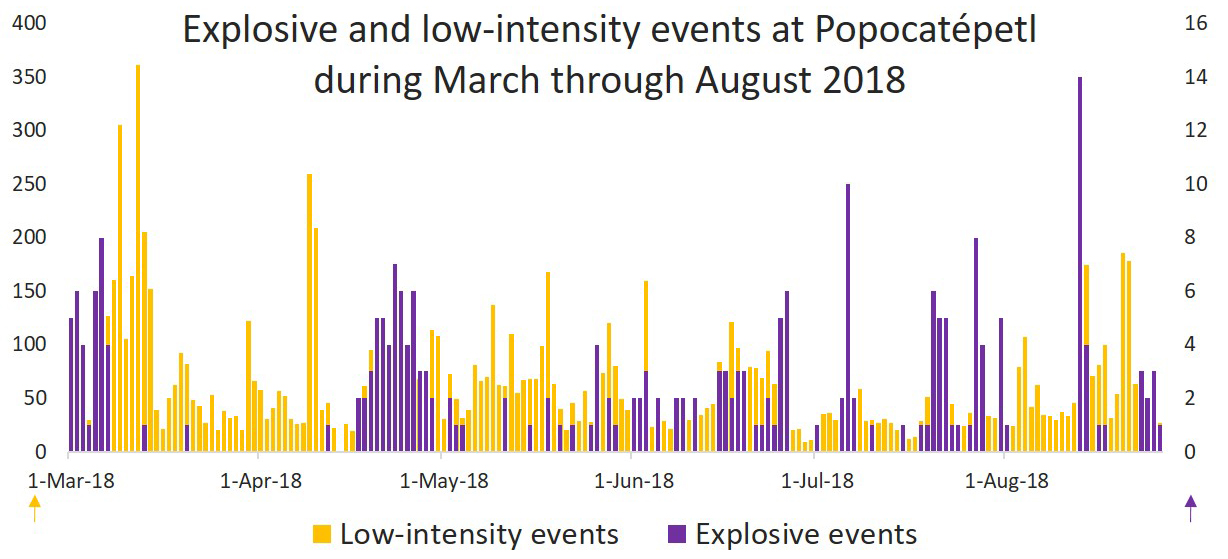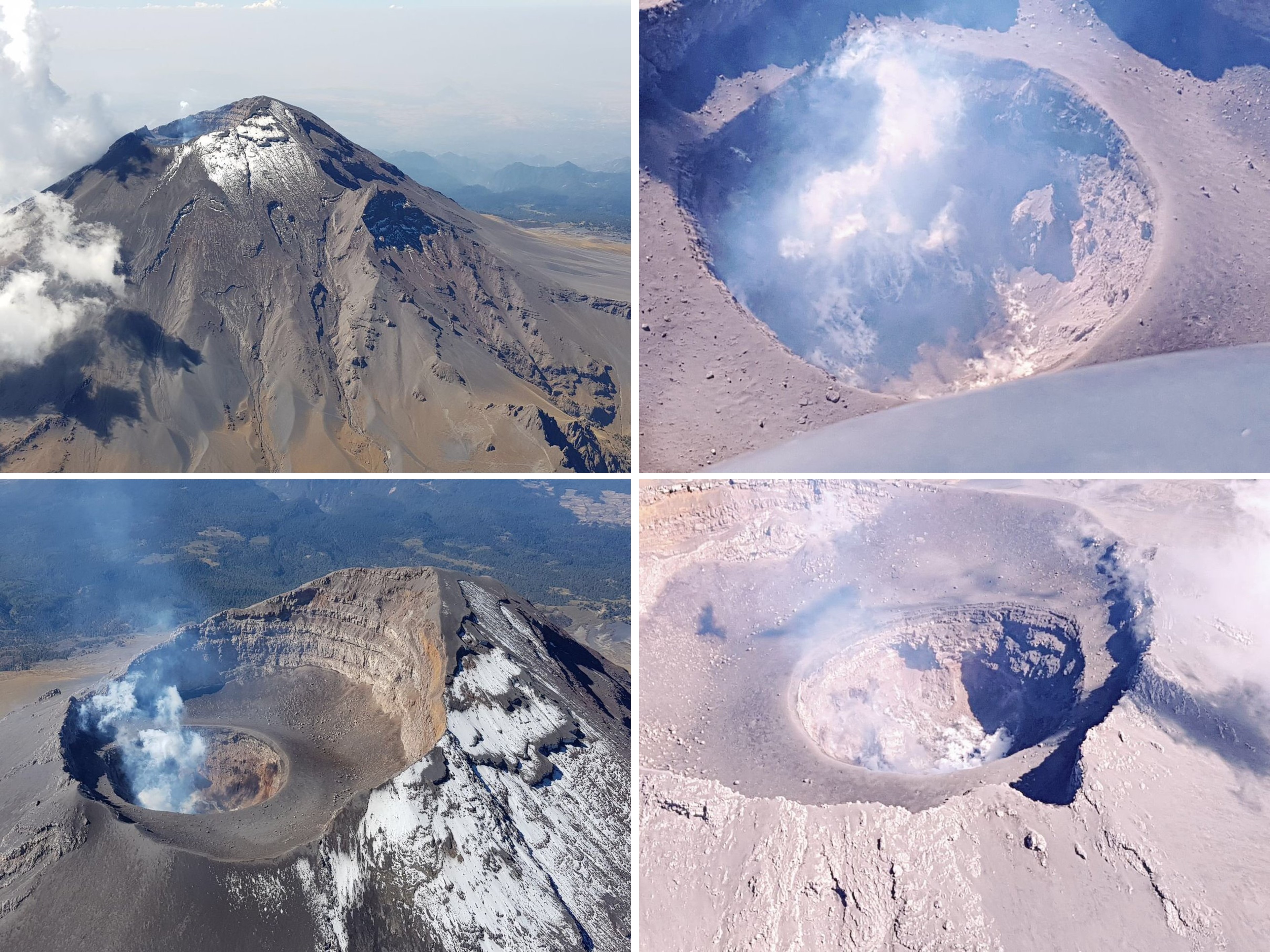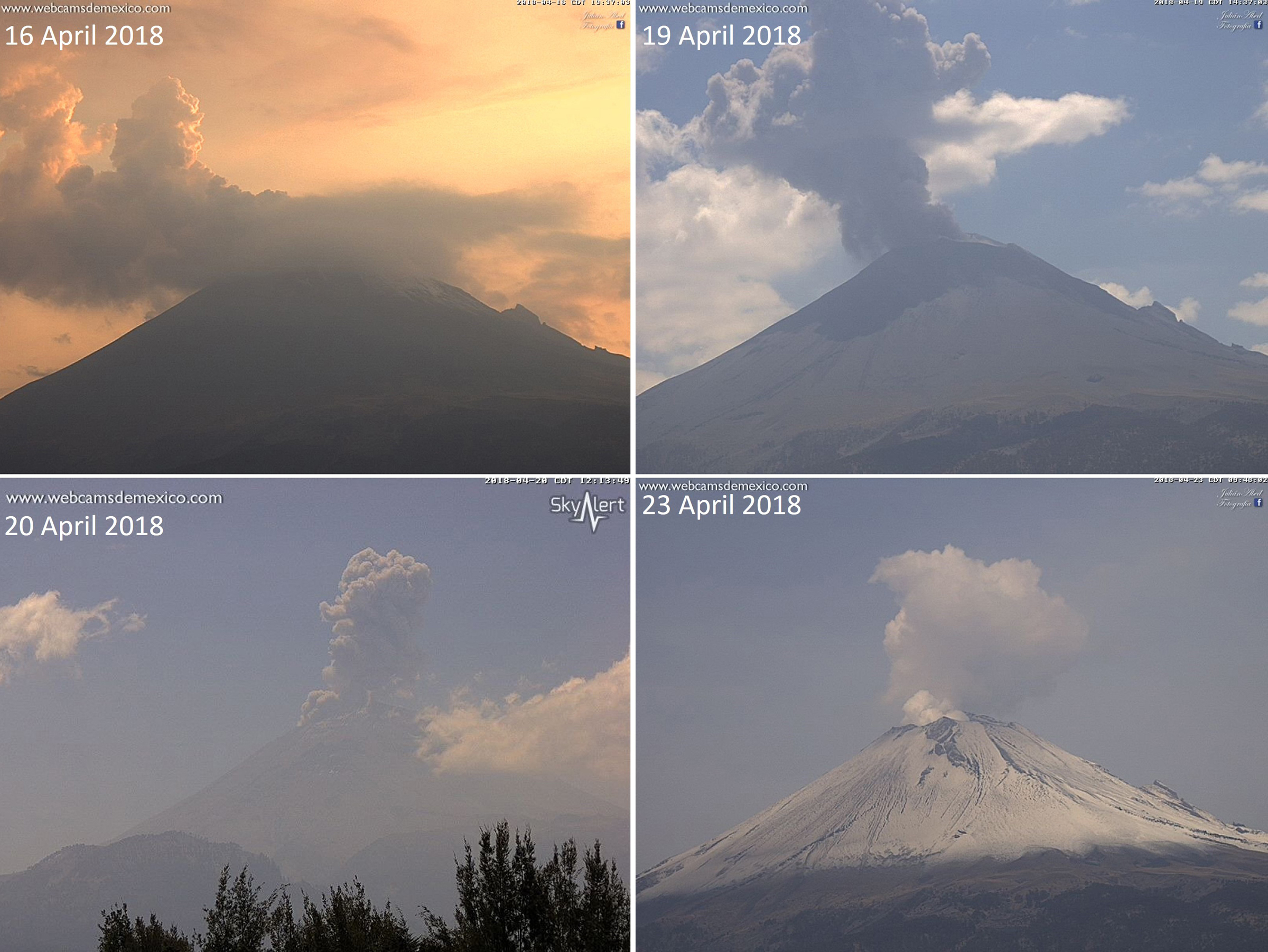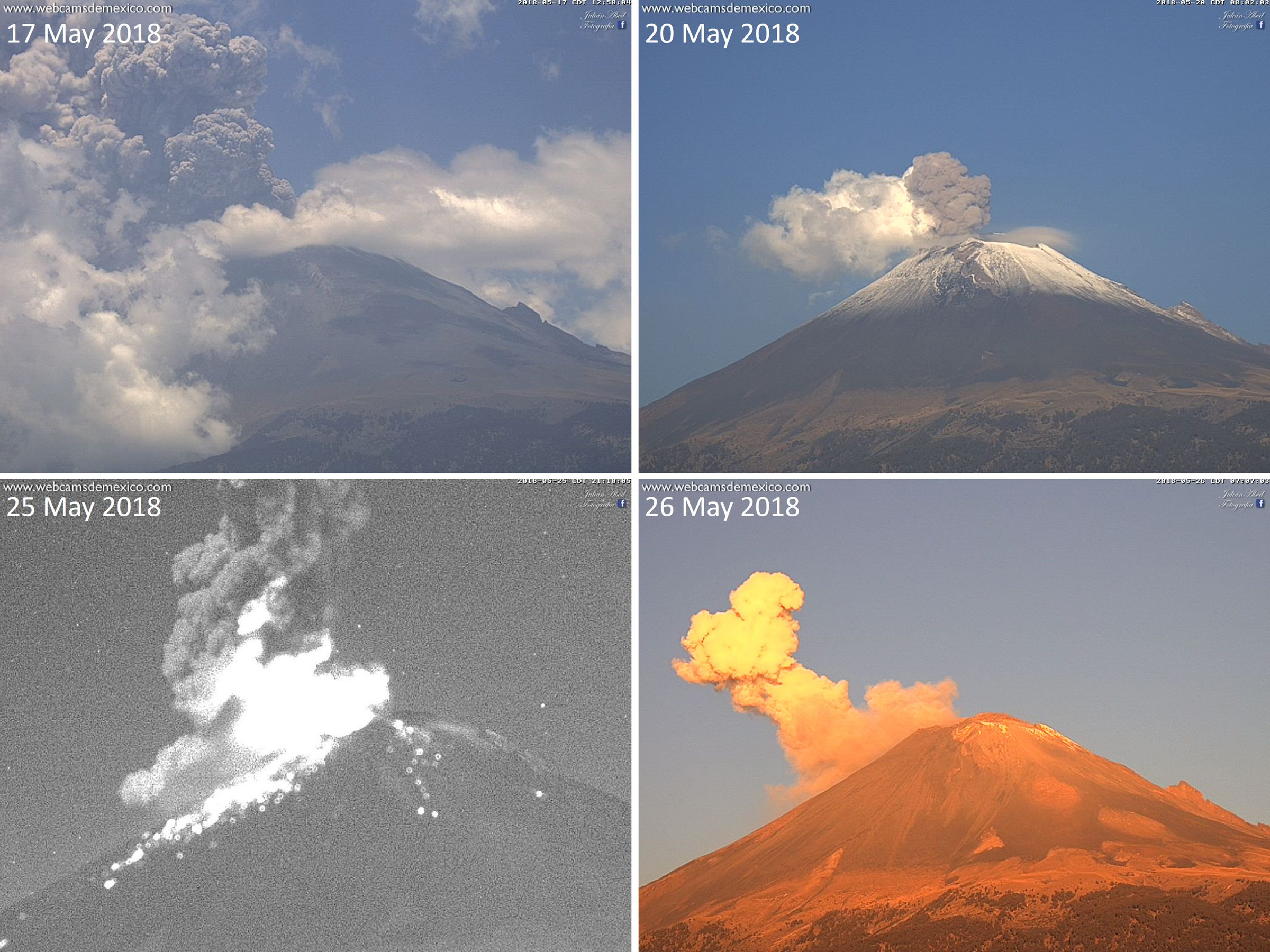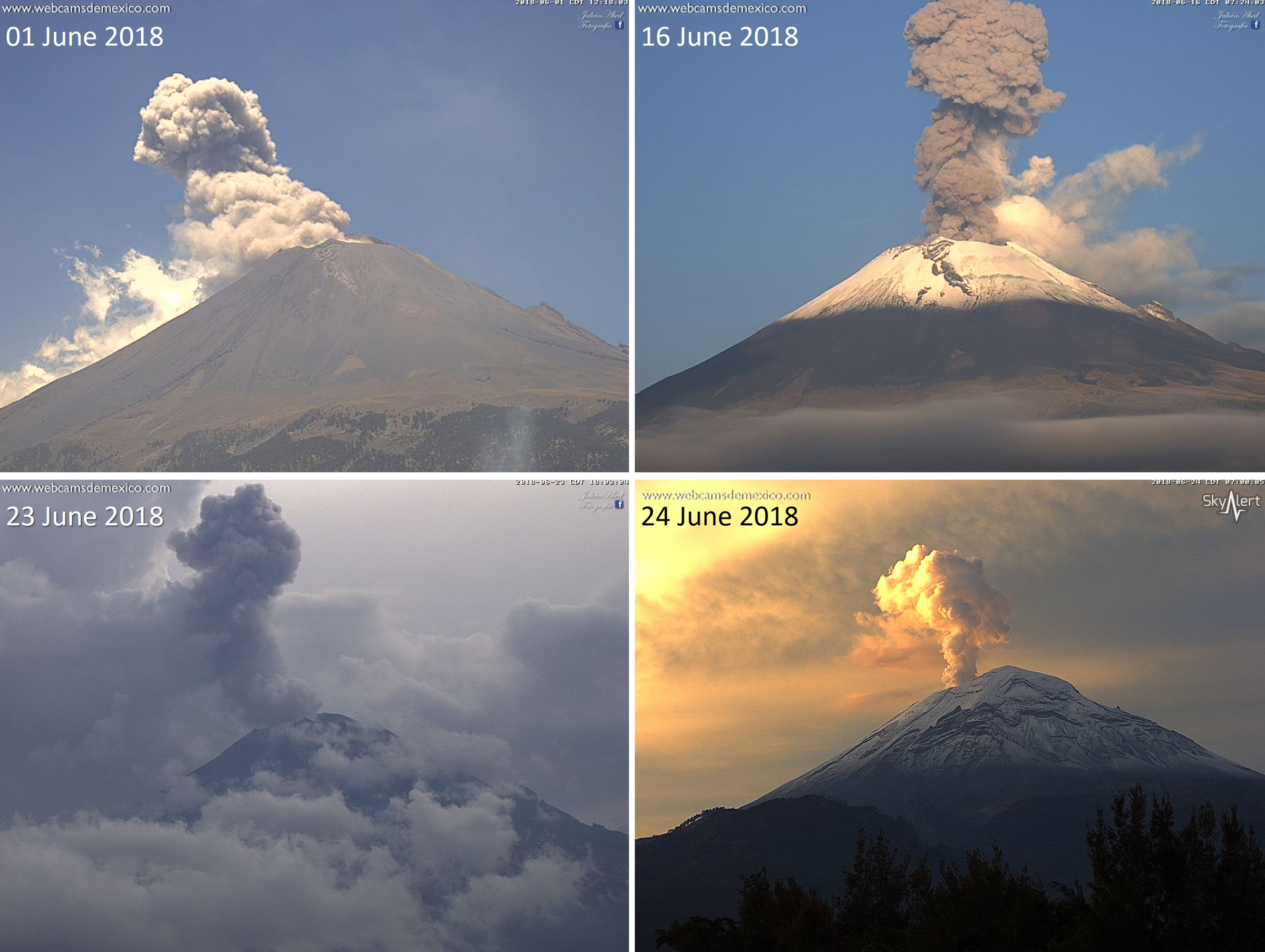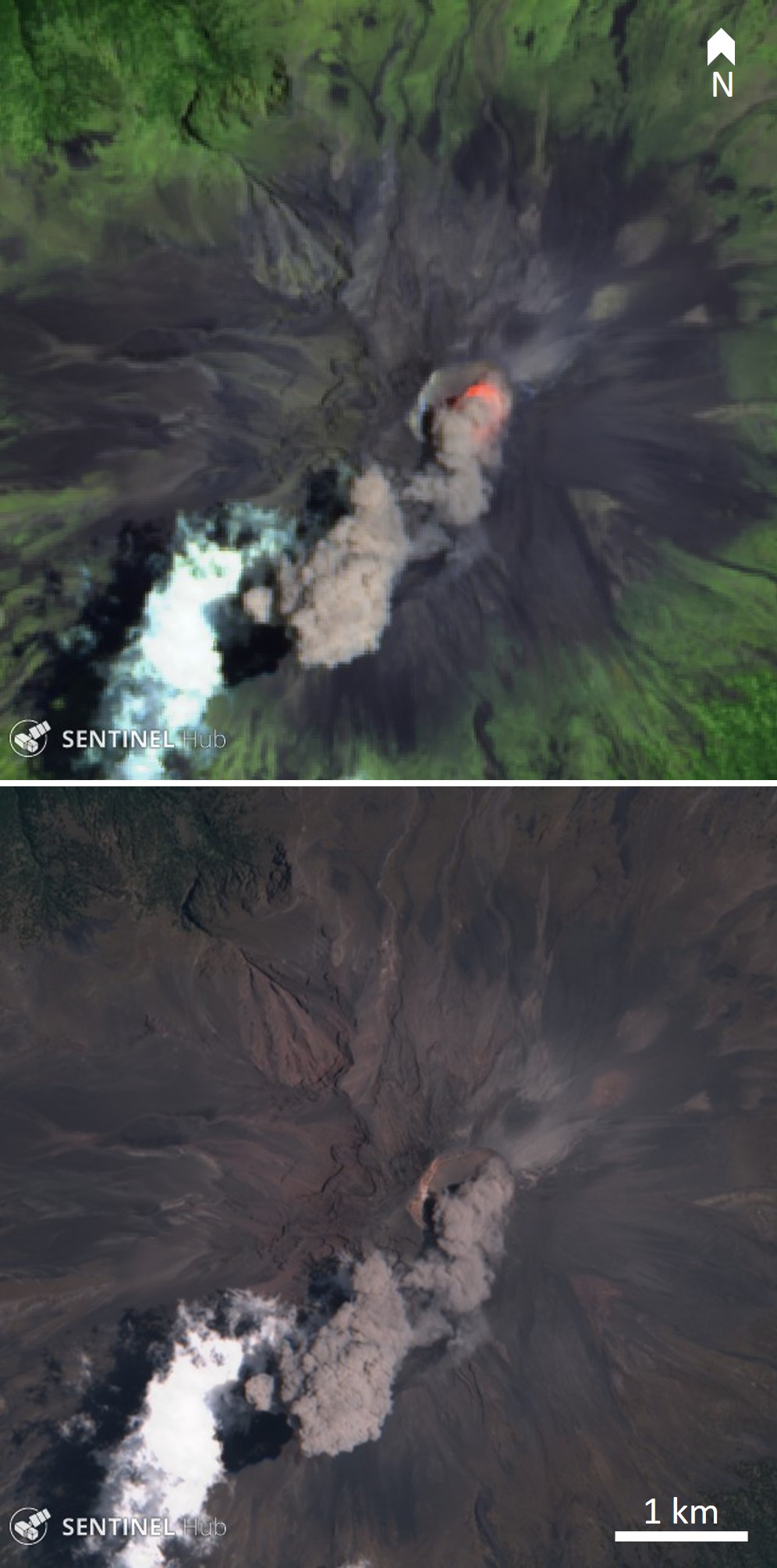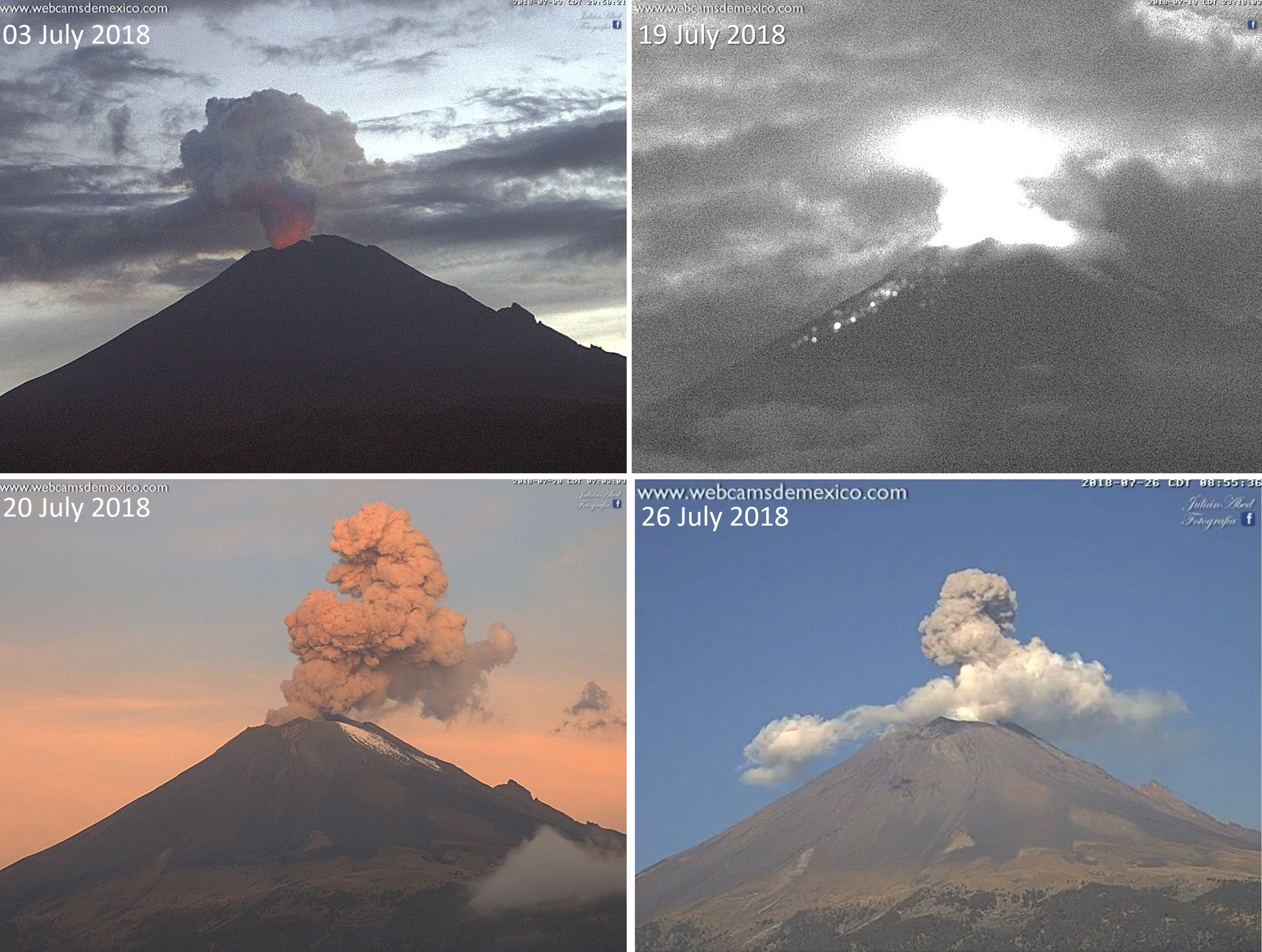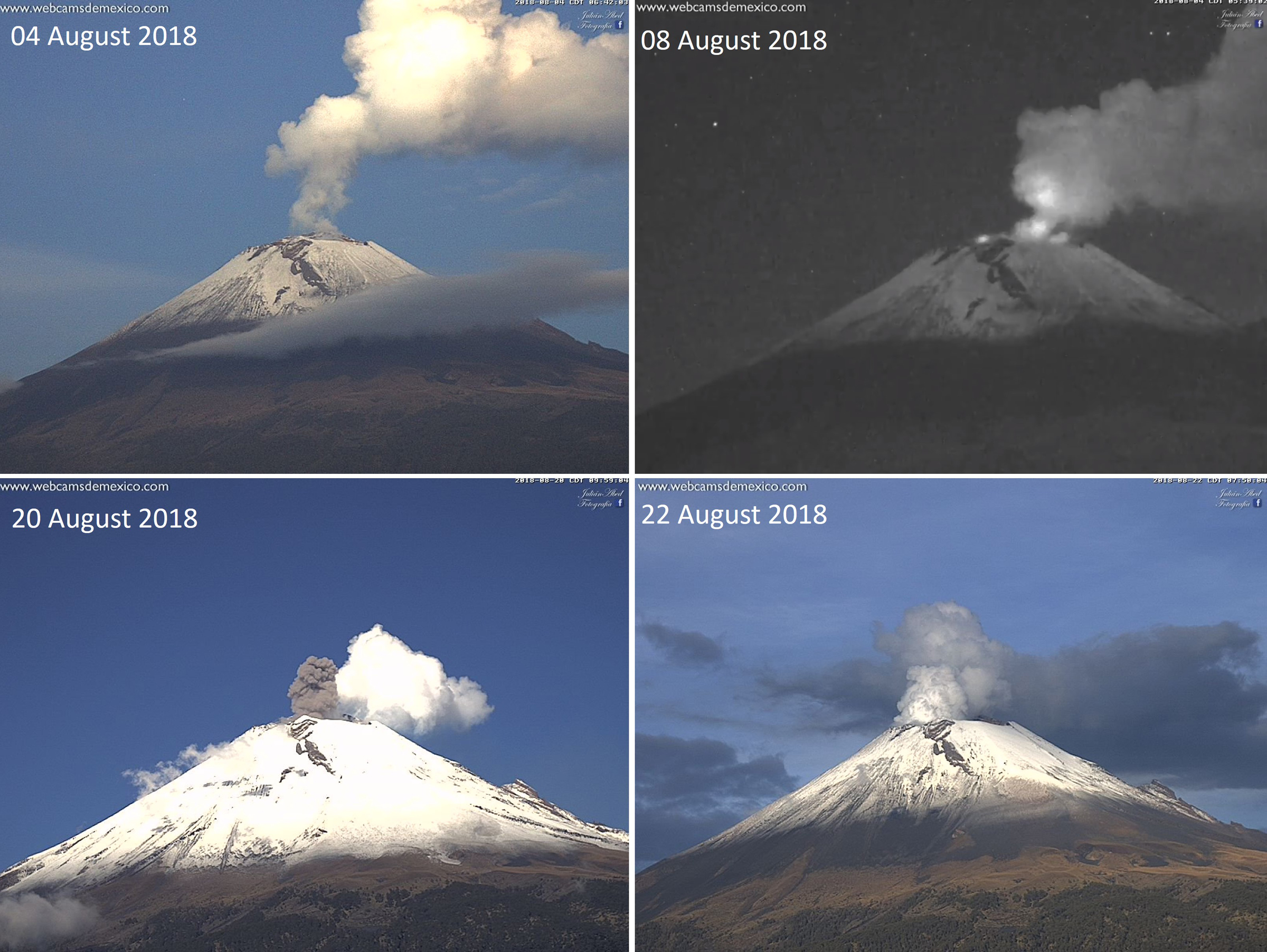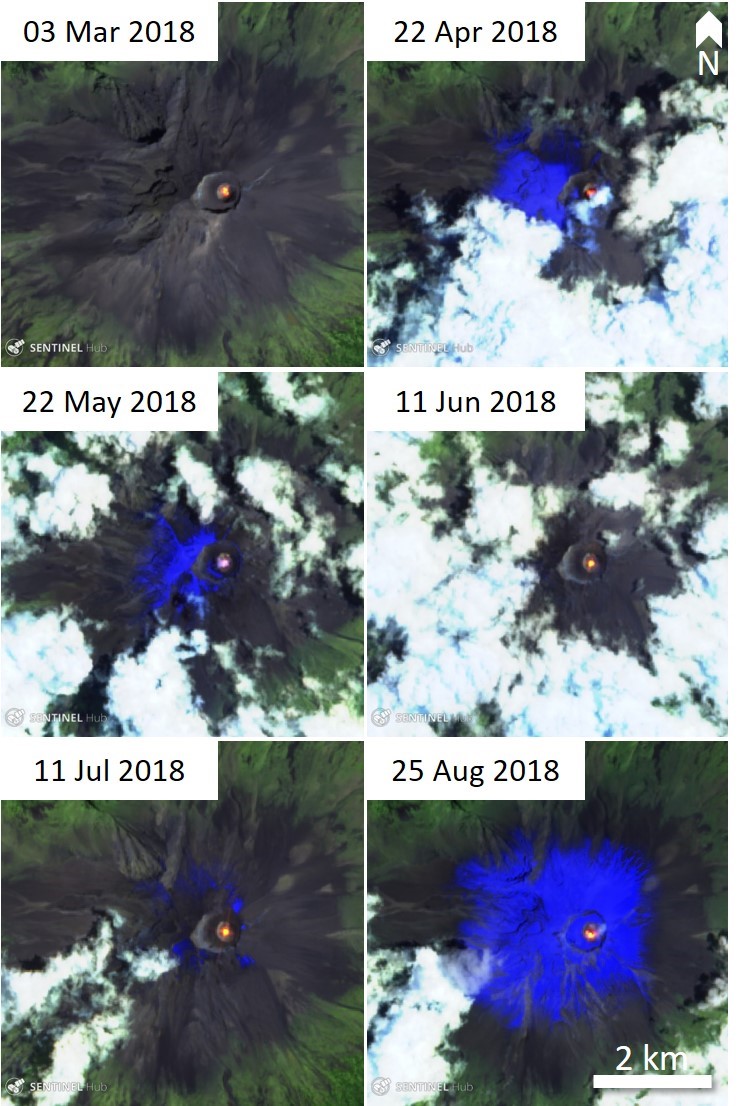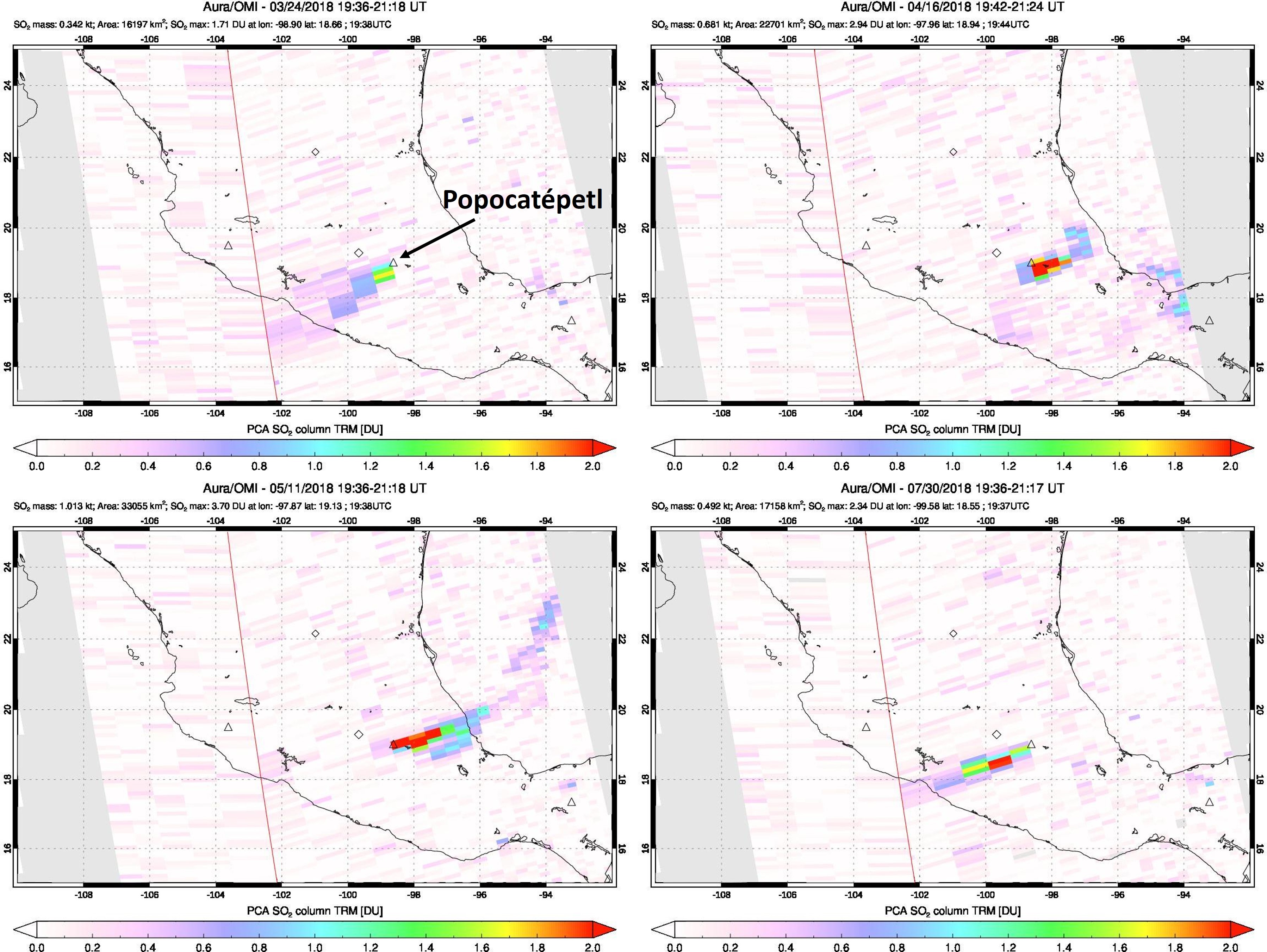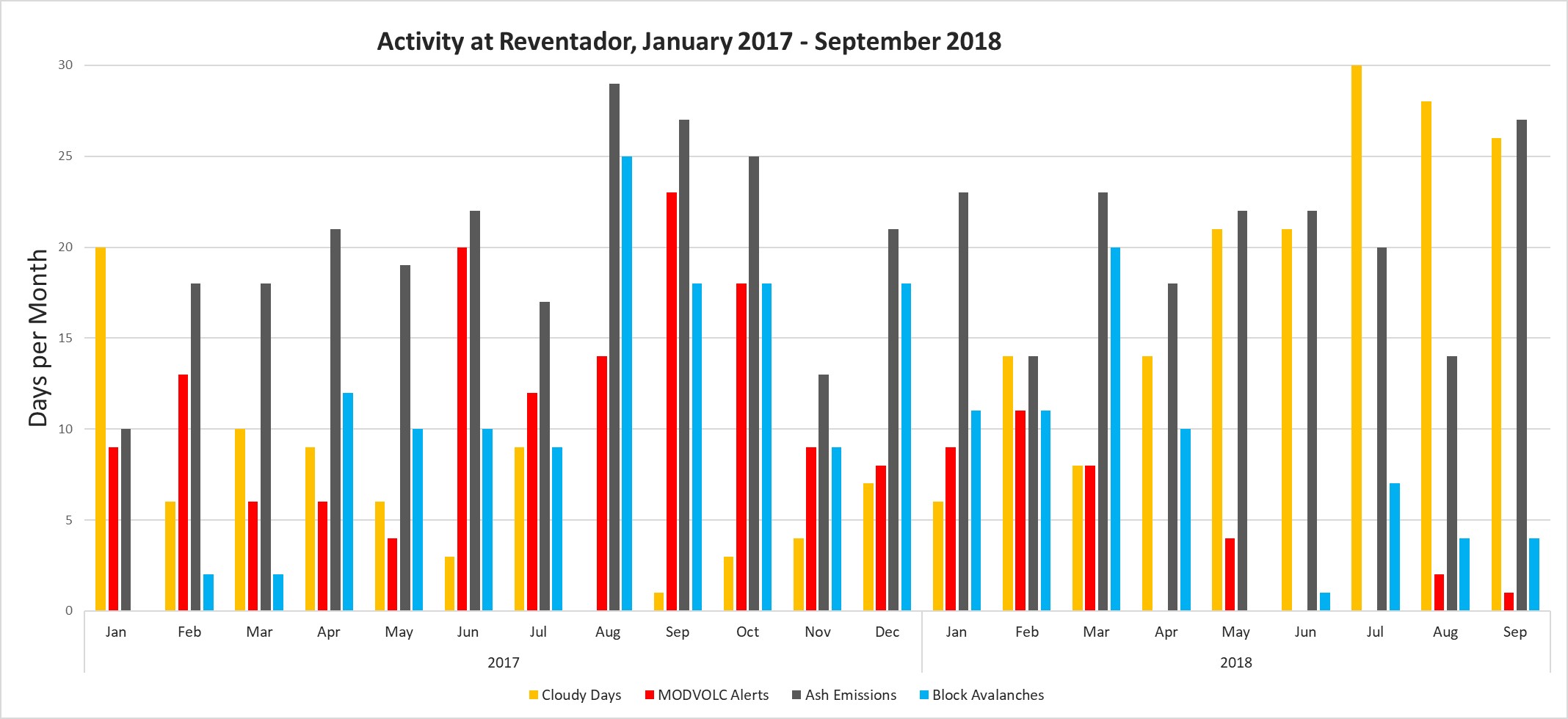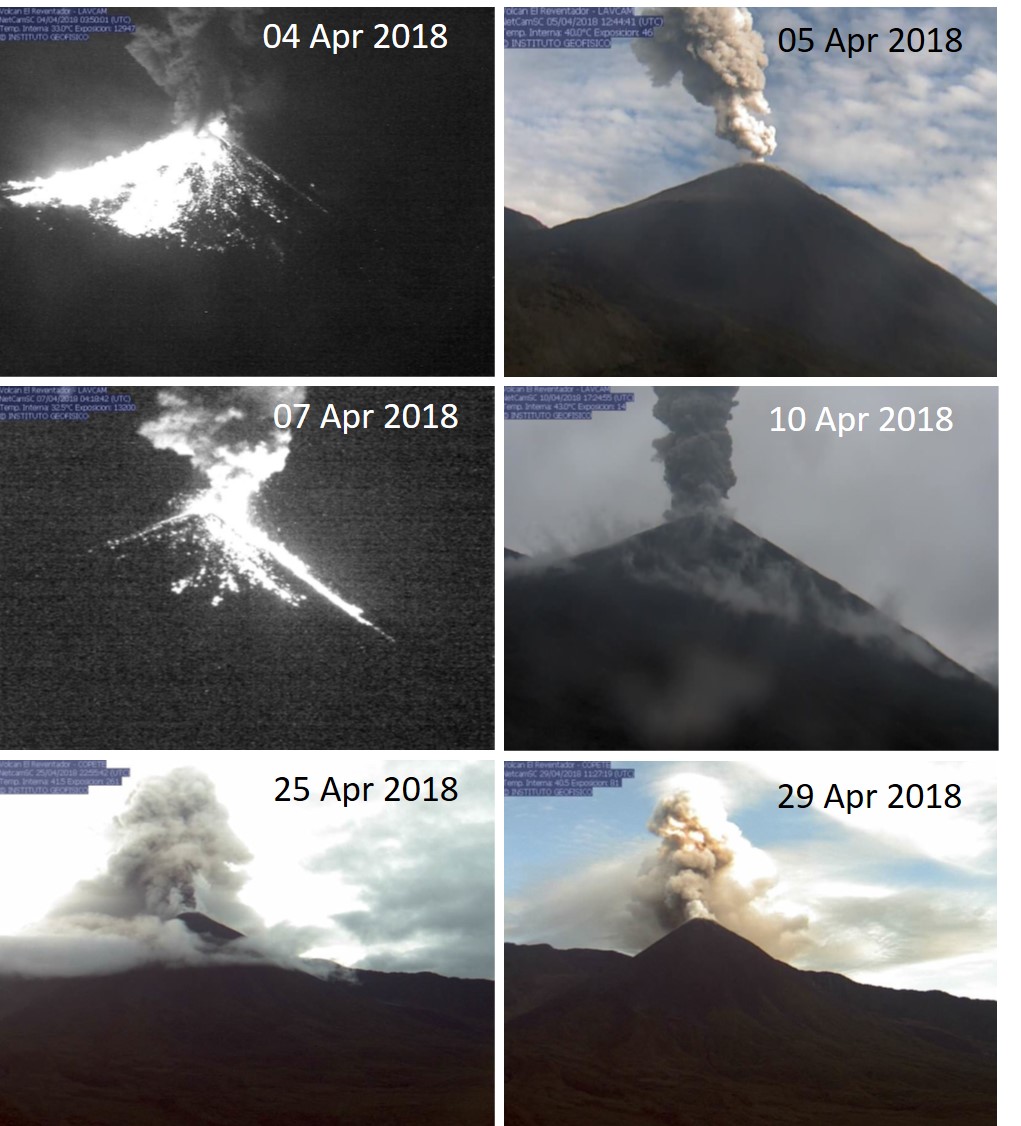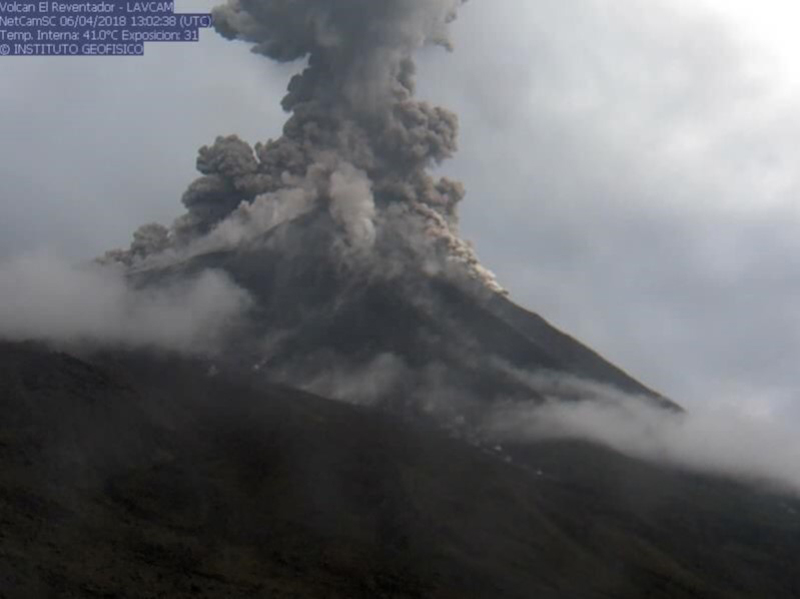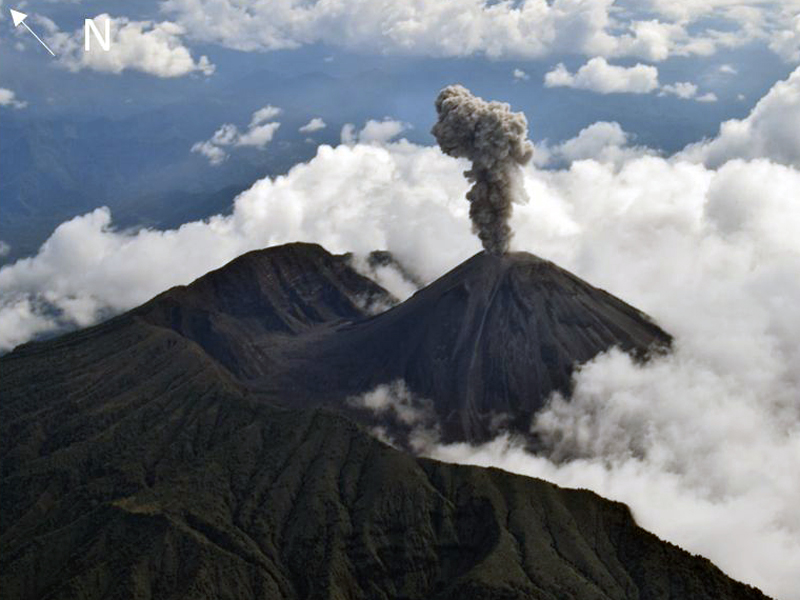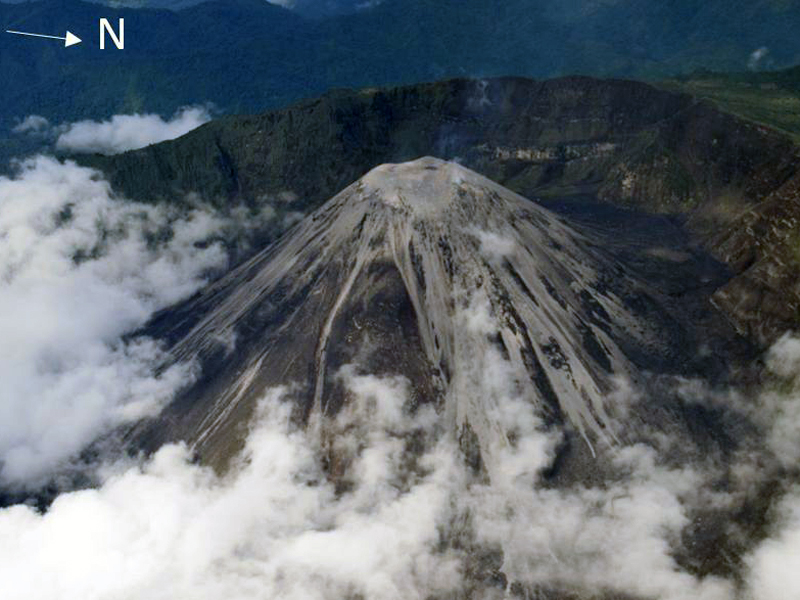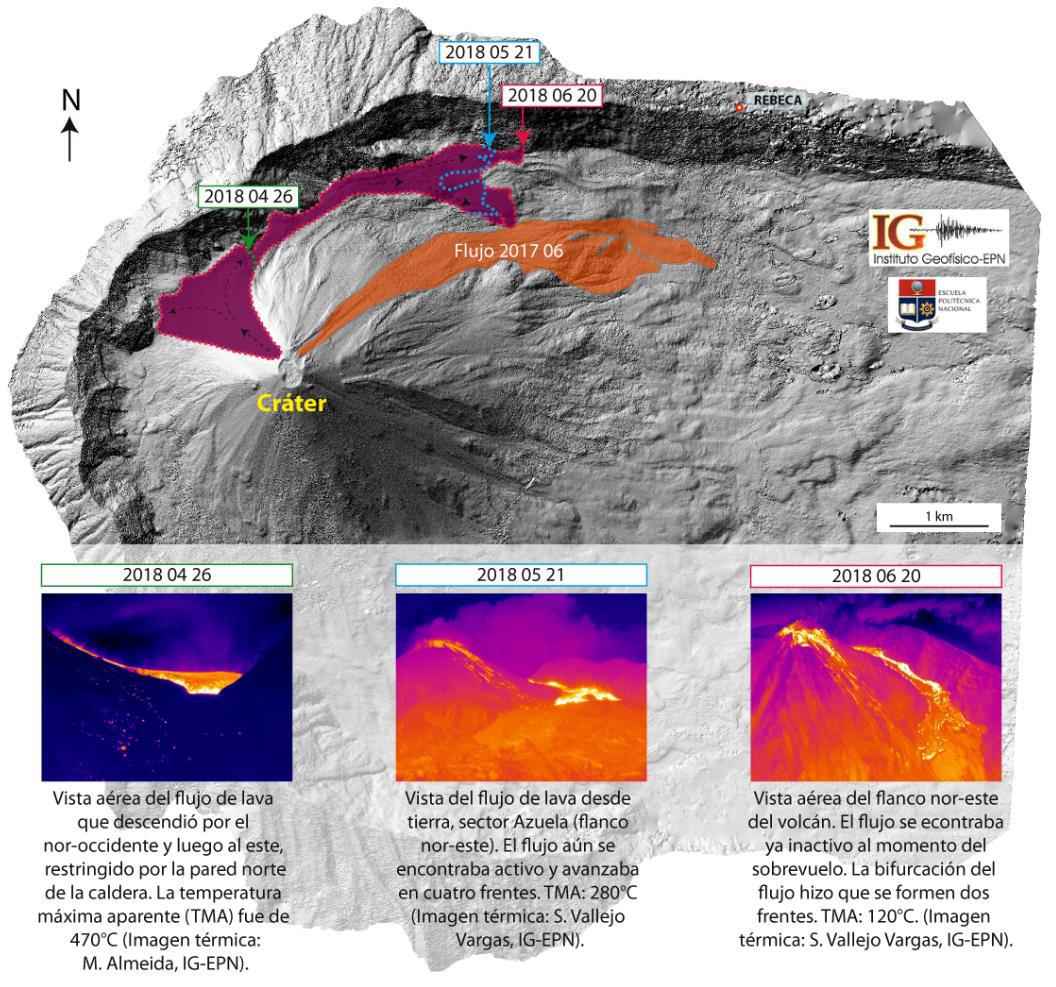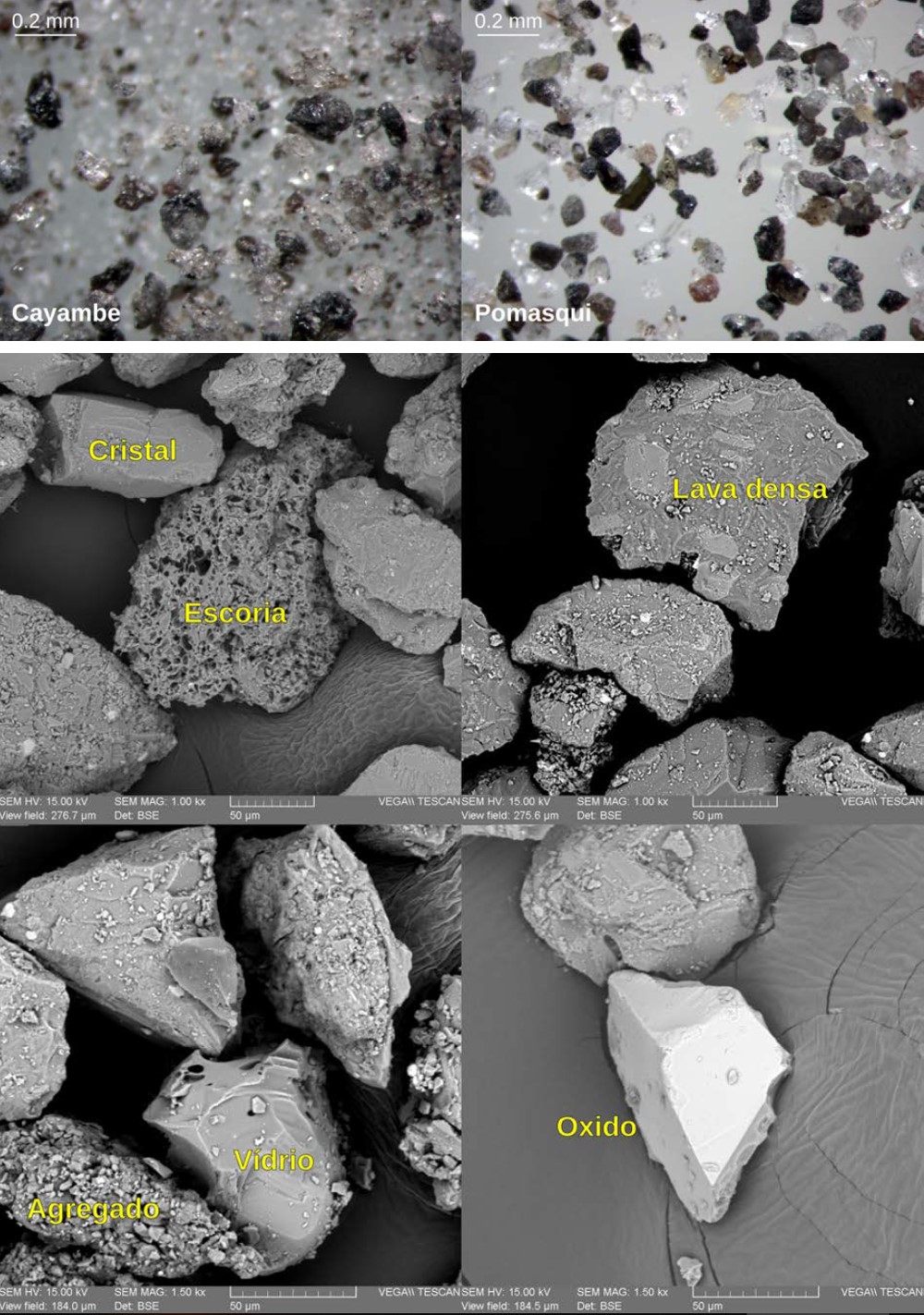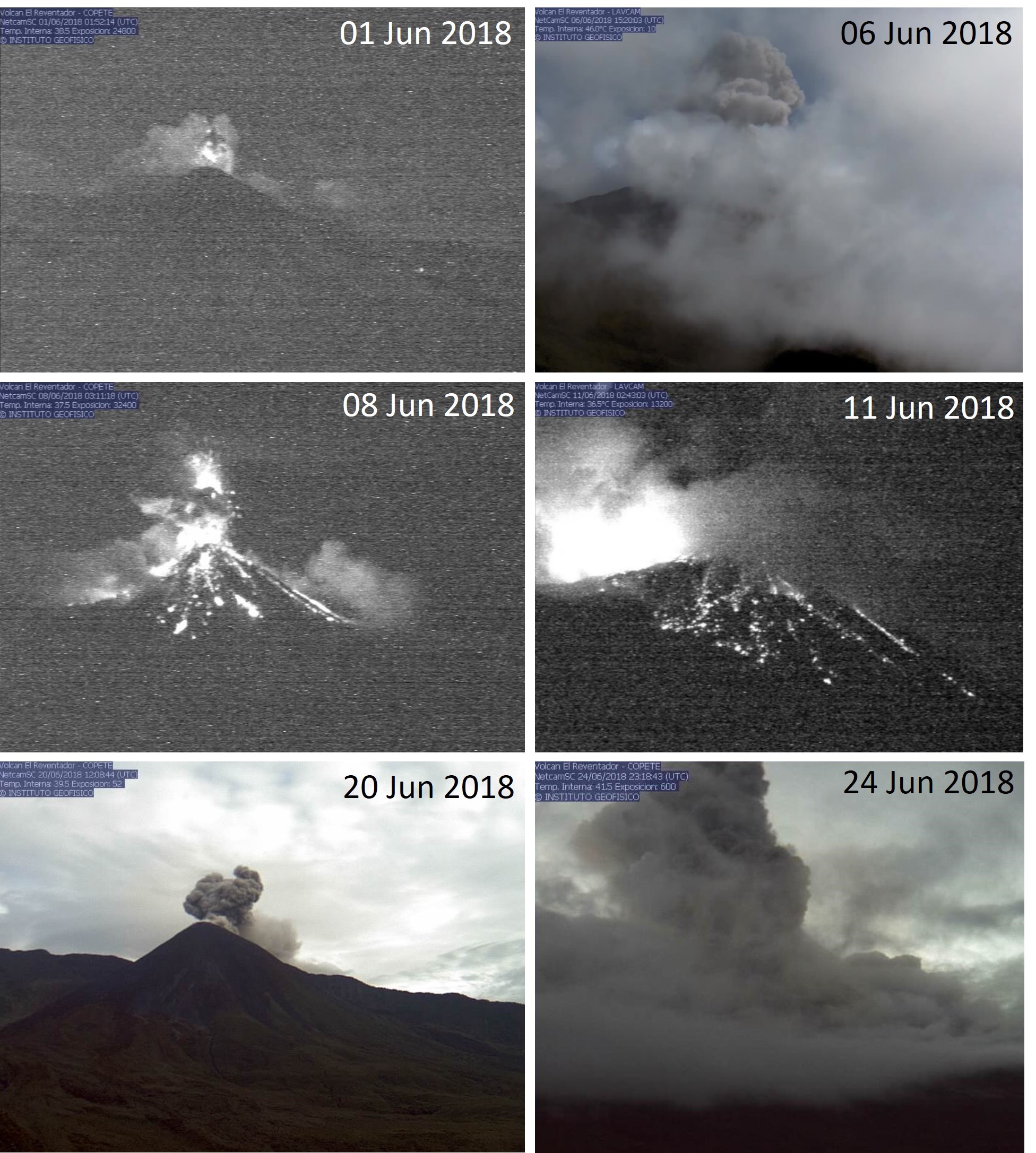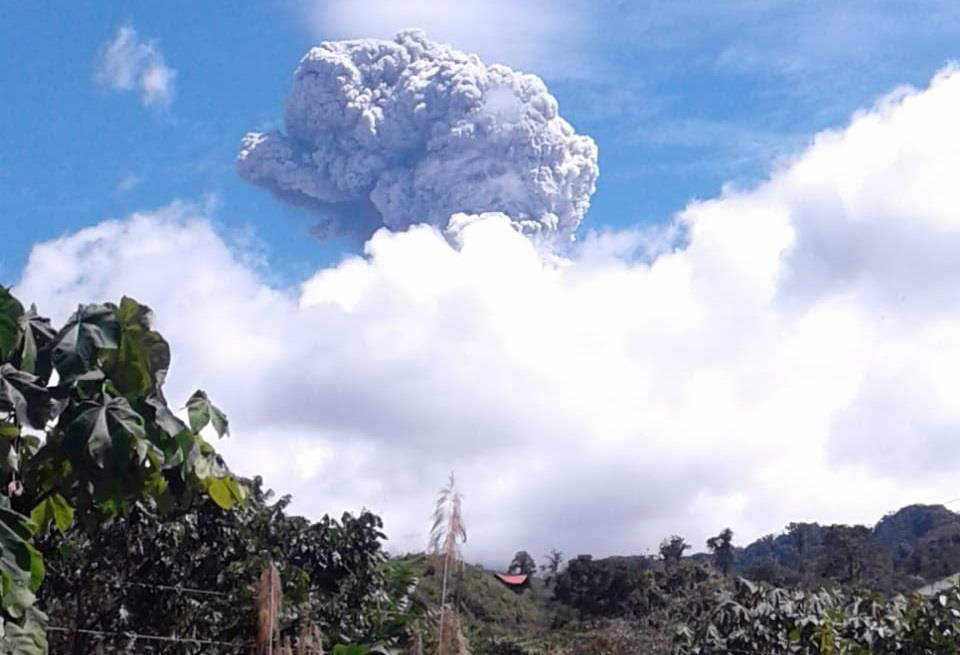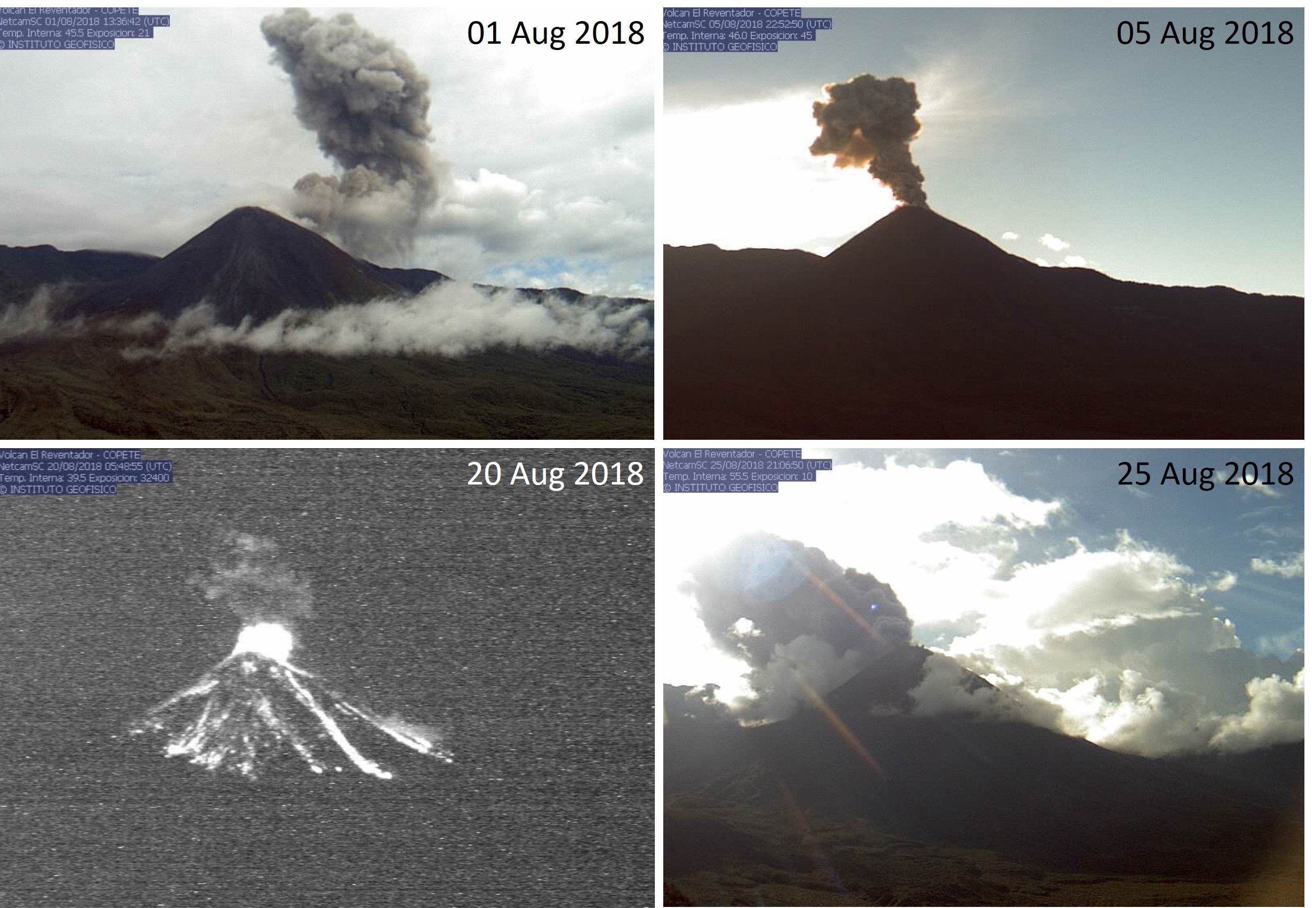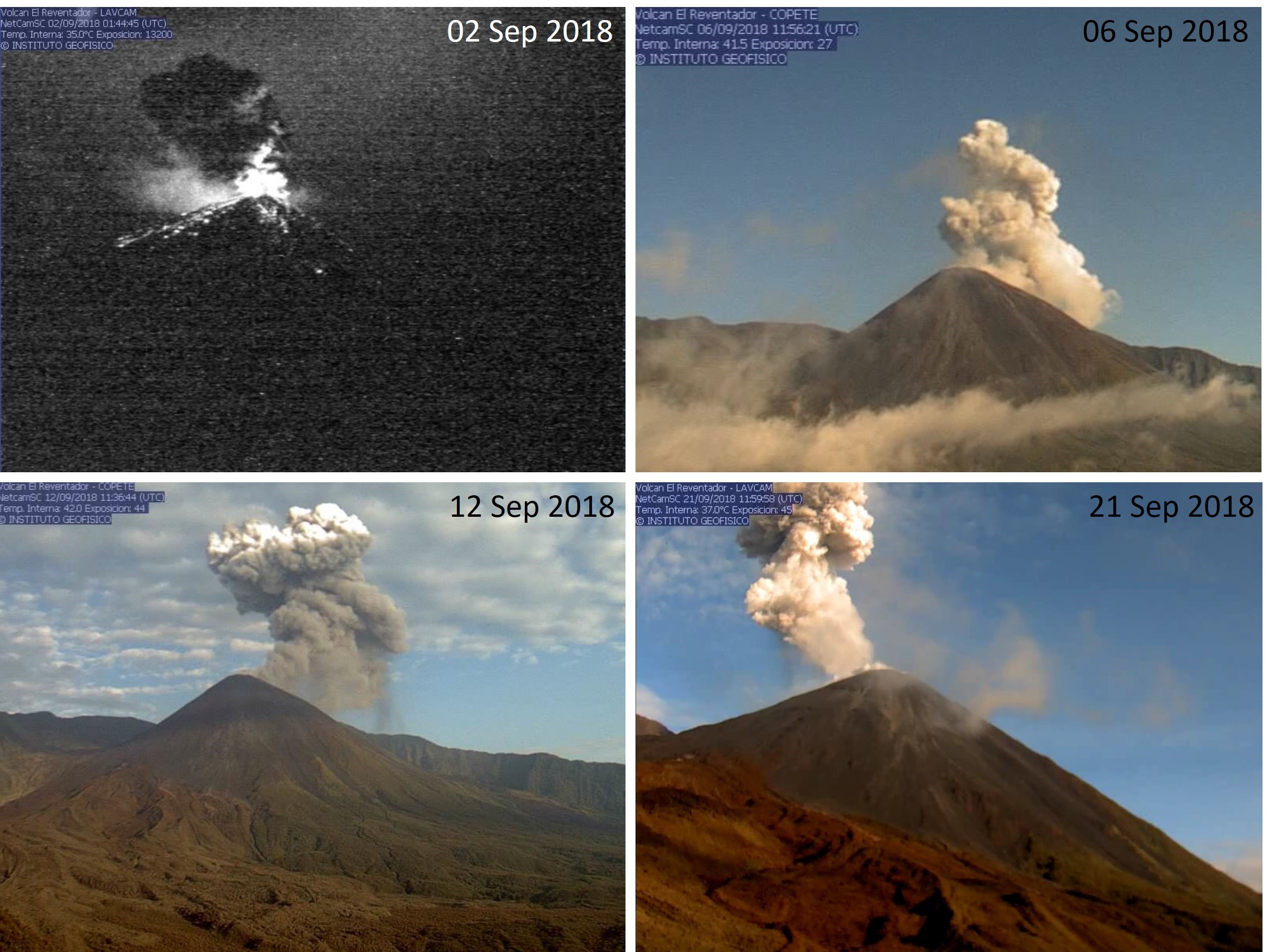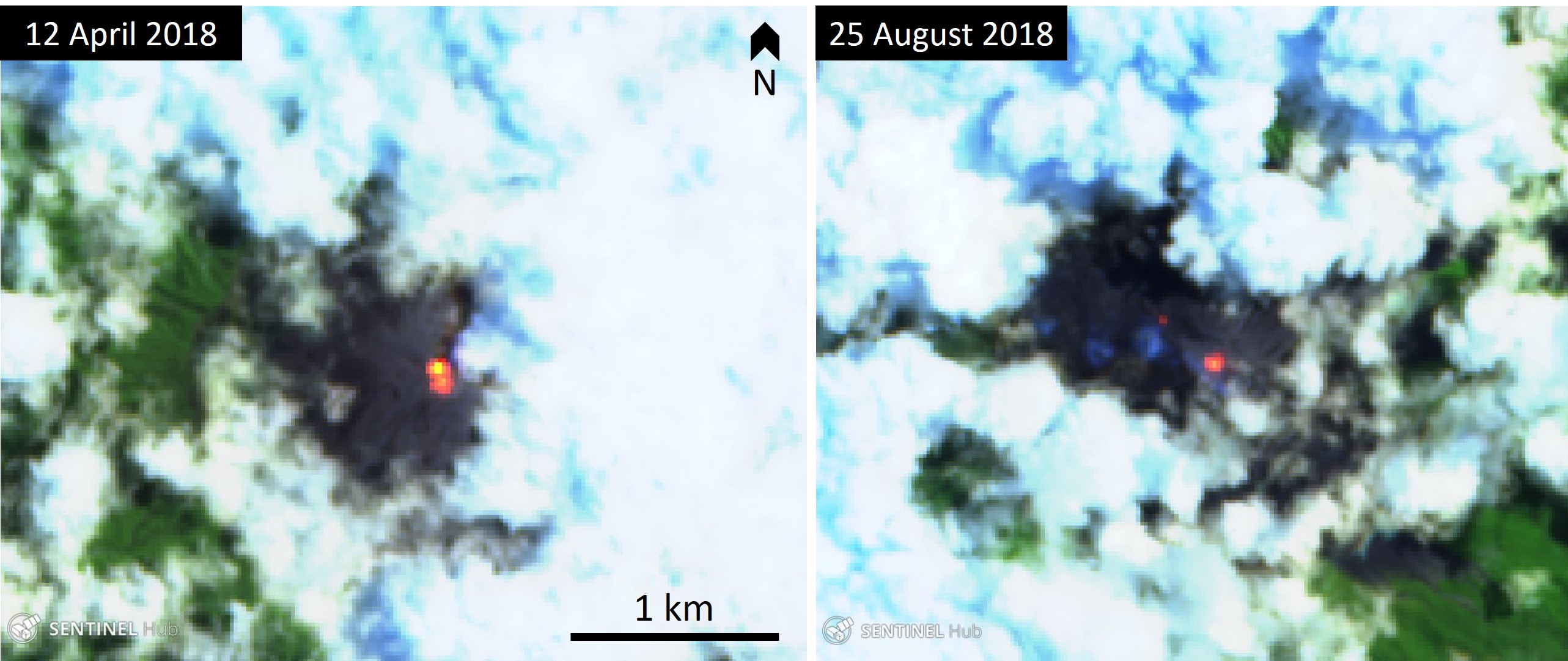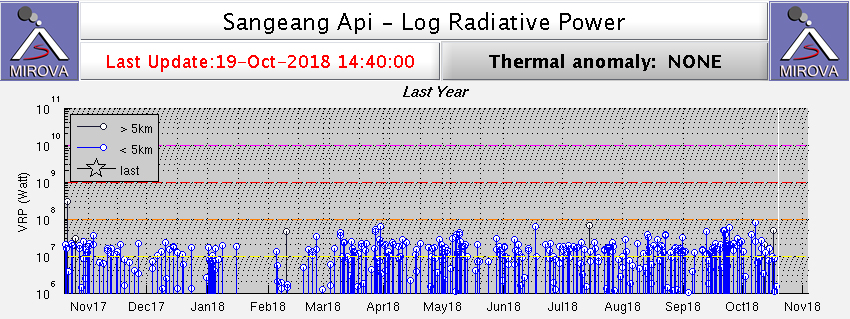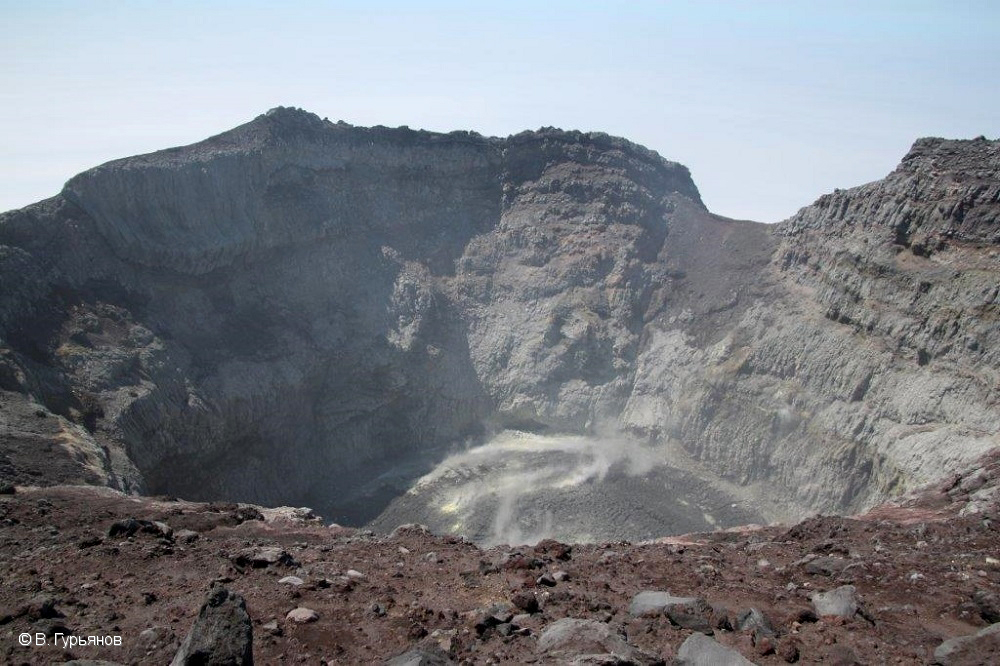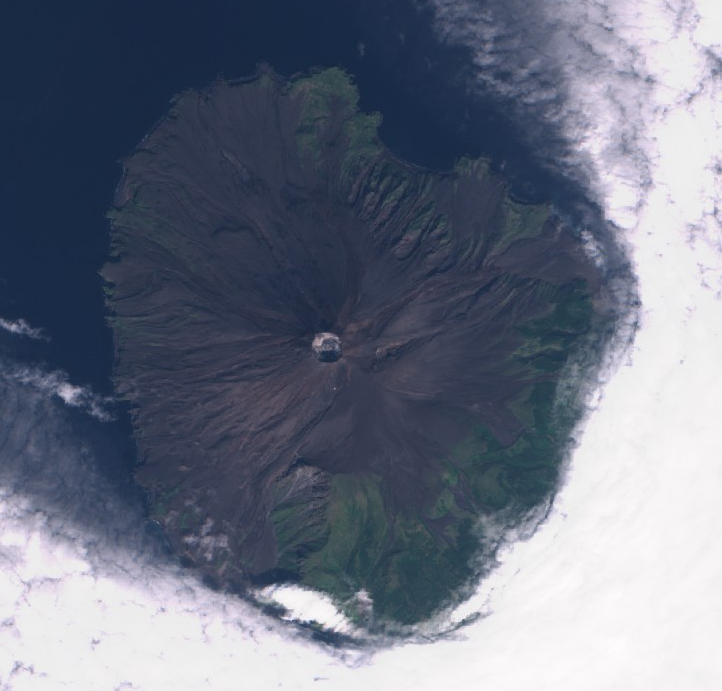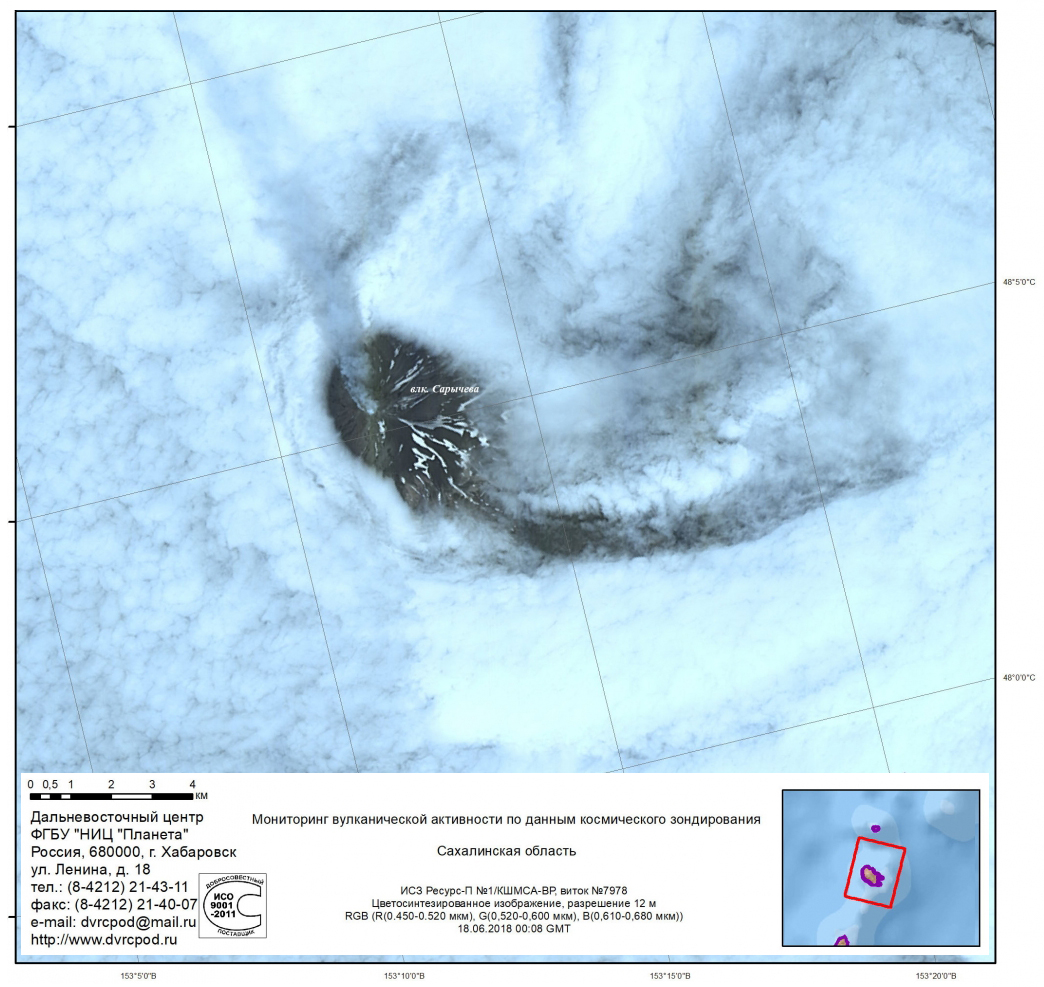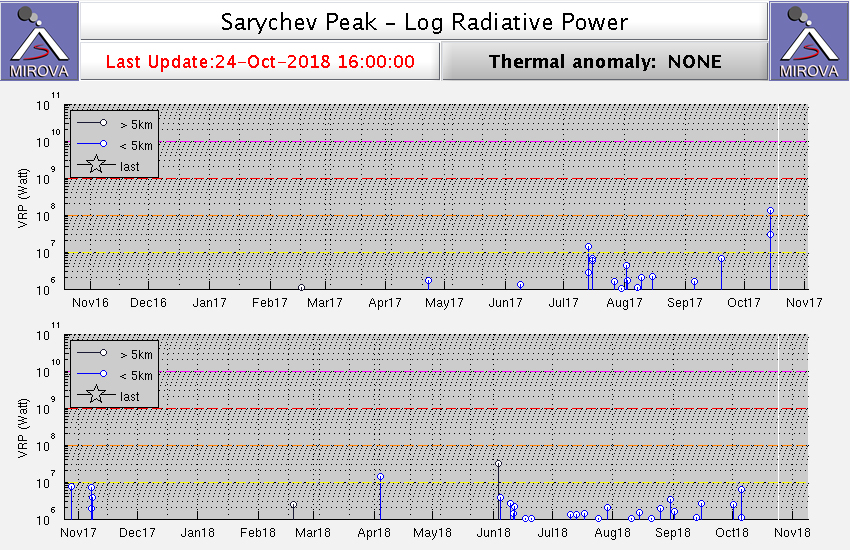Recently Published Bulletin Reports
Erebus (Antarctica) Lava lake remains active; most thermal alerts recorded since 2019
Rincon de la Vieja (Costa Rica) Frequent phreatic explosions during July-December 2023
Bezymianny (Russia) Explosion on 18 October 2023 sends ash plume 8 km high; lava flows and incandescent avalanches
Kilauea (United States) Low-level lava effusions in the lava lake at Halema’uma’u during July-December 2022
Nyamulagira (DR Congo) Lava flows and thermal activity during May-October 2023
Bagana (Papua New Guinea) Explosions, ash plumes, ashfall, and lava flows during April-September 2023
Mayon (Philippines) Lava flows, pyroclastic flows, ash emissions, and seismicity during April-September 2023
Nishinoshima (Japan) Eruption plumes and gas-and-steam plumes during May-August 2023
Krakatau (Indonesia) White gas-and-steam plumes and occasional ash plumes during May-August 2023
Villarrica (Chile) Strombolian activity, gas-and-ash emissions, and crater incandescence during April-September 2023
Merapi (Indonesia) Frequent incandescent avalanches during April-September 2023
Ebeko (Russia) Moderate explosive activity with ash plumes continued during June-November 2023
Erebus (Antarctica) — January 2024  Cite this Report
Cite this Report
Erebus
Antarctica
77.53°S, 167.17°E; summit elev. 3794 m
All times are local (unless otherwise noted)
Lava lake remains active; most thermal alerts recorded since 2019
The lava lake in the summit crater of Erebus has been active since at least 1972. Located in Antarctica overlooking the McMurdo Station on Ross Island, it is the southernmost active volcano on the planet. Because of the remote location, activity is primarily monitored by satellites. This report covers activity during 2023.
The number of thermal alerts recorded by the Hawai'i Institute of Geophysics and Planetology’s MODVOLC Thermal Alerts System increased considerably in 2023 compared to the years 2020-2022 (table 9). In contrast to previous years, the MODIS instruments aboard the Aqua and Terra satellites captured data from Erebus every month during 2023. Consistent with previous years, the lowest number of anomalous pixels were recorded in January, November, and December.
Table 9. Number of monthly MODIS-MODVOLC thermal alert pixels recorded at Erebus during 2017-2023. See BGVN 42:06 for data from 2000 through 2016. The table was compiled using data provided by the HIGP – MODVOLC Thermal Alerts System.
| Year |
Jan |
Feb |
Mar |
Apr |
May |
Jun |
Jul |
Aug |
Sep |
Oct |
Nov |
Dec |
SUM |
| 2017 |
0 |
21 |
9 |
0 |
0 |
1 |
11 |
61 |
76 |
52 |
0 |
3 |
234 |
| 2018 |
0 |
21 |
58 |
182 |
55 |
17 |
137 |
172 |
103 |
29 |
0 |
0 |
774 |
| 2019 |
2 |
21 |
162 |
151 |
55 |
56 |
75 |
53 |
29 |
19 |
1 |
0 |
624 |
| 2020 |
0 |
2 |
16 |
18 |
4 |
4 |
1 |
3 |
18 |
3 |
1 |
6 |
76 |
| 2021 |
0 |
9 |
1 |
0 |
2 |
56 |
46 |
47 |
35 |
52 |
5 |
3 |
256 |
| 2022 |
1 |
13 |
55 |
22 |
15 |
32 |
39 |
19 |
31 |
11 |
0 |
0 |
238 |
| 2023 |
2 |
33 |
49 |
82 |
41 |
32 |
70 |
64 |
42 |
17 |
5 |
11 |
448 |
Sentinel-2 infrared images showed one or two prominent heat sources within the summit crater, accompanied by adjacent smaller sources, similar to recent years (see BGVN 46:01, 47:02, and 48:01). A unique image was obtained on 25 November 2023 by the OLI-2 (Operational Land Imager-2) on Landsat 9, showing the upper part of the volcano surrounded by clouds (figure 32).
Geologic Background. Mount Erebus, the world's southernmost historically active volcano, overlooks the McMurdo research station on Ross Island. It is the largest of three major volcanoes forming the crudely triangular Ross Island. The summit of the dominantly phonolitic volcano has been modified by one or two generations of caldera formation. A summit plateau at about 3,200 m elevation marks the rim of the youngest caldera, which formed during the late-Pleistocene and within which the modern cone was constructed. An elliptical 500 x 600 m wide, 110-m-deep crater truncates the summit and contains an active lava lake within a 250-m-wide, 100-m-deep inner crater; other lava lakes are sometimes present. The glacier-covered volcano was erupting when first sighted by Captain James Ross in 1841. Continuous lava-lake activity with minor explosions, punctuated by occasional larger Strombolian explosions that eject bombs onto the crater rim, has been documented since 1972, but has probably been occurring for much of the volcano's recent history.
Information Contacts: Hawai'i Institute of Geophysics and Planetology (HIGP) - MODVOLC Thermal Alerts System, School of Ocean and Earth Science and Technology (SOEST), Univ. of Hawai'i, 2525 Correa Road, Honolulu, HI 96822, USA (URL: http://modis.higp.hawaii.edu/); Copernicus Browser, Copernicus Data Space Ecosystem, European Space Agency (URL: https://dataspace.copernicus.eu/browser/); NASA Earth Observatory, EOS Project Science Office, NASA Goddard Space Flight Center, Goddard, Maryland, USA (URL: https://earthobservatory.nasa.gov/images/152134/erebus-breaks-through).
Rincon de la Vieja (Costa Rica) — January 2024  Cite this Report
Cite this Report
Rincon de la Vieja
Costa Rica
10.83°N, 85.324°W; summit elev. 1916 m
All times are local (unless otherwise noted)
Frequent phreatic explosions during July-December 2023
Rincón de la Vieja is a volcanic complex in Costa Rica with a hot convecting acid lake that exhibits frequent weak phreatic explosions, gas-and-steam emissions, and occasional elevated sulfur dioxide levels (BGVN 45:10, 46:03, 46:11). The current eruption period began June 2021. This report covers activity during July-December 2023 and is based on weekly bulletins and occasional daily reports from the Observatorio Vulcanologico Sismologica de Costa Rica-Universidad Nacional (OVSICORI-UNA).
Numerous weak phreatic explosions continued during July-December 2023, along with gas-and-steam emissions and plumes that rose as high as 3 km above the crater rim. Many weekly OVSICORI-UNA bulletins included the previous week's number of explosions and emissions (table 9). For many explosions, the time of explosion was given (table 10). Frequent seismic activity (long-period earthquakes, volcano-tectonic earthquakes, and tremor) accompanied the phreatic activity.
Table 9. Number of reported weekly phreatic explosions and gas-and-steam emissions at Rincón de la Vieja, July-December 2023. Counts are reported for the week before the Weekly Bulletin date; not all reports included these data. Courtesy of OVSICORI-UNA.
| OVSICORI Weekly Bulletin |
Number of explosions |
Number of emissions |
| 28 Jul 2023 |
6 |
14 |
| 4 Aug 2023 |
10 |
12 |
| 1 Sep 2023 |
13 |
11 |
| 22 Sep 2023 |
12 |
13 |
| 29 Sep 2023 |
6 |
11 |
| 6 Oct 2023 |
12 |
5 |
| 13 Oct 2023 |
7 |
9 |
| 20 Oct 2023 |
1 |
15 |
| 27 Oct 2023 |
3 |
23 |
| 3 Nov 2023 |
3 |
10 |
| 17 Nov 2023 |
0 |
Some |
| 24 Nov 2023 |
0 |
14 |
| 8 Dec 2023 |
4 |
16 |
| 22 Dec 2023 |
8 |
18 |
Table 10. Summary of activity at Rincón de la Vieja during July-December 2023. Weak phreatic explosions and gas emissions are noted where the time of explosion was indicated in the weekly or daily bulletins. Height of plumes or emissions are distance above the crater rim. Courtesy of OVSICORI-UNA.
| Date |
Time |
Description of Activity |
| 1 Jul 2023 |
0156 |
Explosion. |
| 2 Jul 2023 |
0305 |
Explosion. |
| 4 Jul 2023 |
0229, 0635 |
Event at 0635 produced a gas-and-steam plume that rose 700 m and drifted W; seen by residents in Liberia (21 km SW). |
| 9 Jul 2023 |
1843 |
Explosion. |
| 21 Jul 2023 |
0705 |
Explosion. |
| 26 Jul 2023 |
1807 |
Explosion. |
| 28 Jul 2023 |
0802 |
Explosion generated a gas-and-steam plume that rose 500 m. |
| 30 Jul 2023 |
1250 |
Explosion. |
| 31 Jul 2023 |
2136 |
Explosion. |
| 11 Aug 2023 |
0828 |
Explosion. |
| 18 Aug 2023 |
1304 |
Explosion. |
| 21 Aug 2023 |
1224 |
Explosion generated gas-and-steam plumes rose 500-600 m. |
| 22 Aug 2023 |
0749 |
Explosion generated gas-and-steam plumes rose 500-600 m. |
| 24 Aug 2023 |
1900 |
Explosion. |
| 25 Aug 2023 |
0828 |
Event produced a steam-and-gas plume that rose 3 km and drifted NW. |
| 27-28 Aug 2023 |
0813 |
Four small events; the event at 0813 on 28 August lasted two minutes and generated a steam-and-gas plume that rose 2.5 km. |
| 1 Sep 2023 |
1526 |
Explosion generated plume that rose 2 km and ejected material onto the flanks. |
| 2-3 Sep 2023 |
- |
Small explosions detected in infrasound data. |
| 4 Sep 2023 |
1251 |
Gas-and-steam plume rose 1 km and drifted W. |
| 7 Nov 2023 |
1113 |
Explosion. |
| 8 Nov 2023 |
0722 |
Explosion. |
| 12 Nov 2023 |
0136 |
Small gas emissions. |
| 14 Nov 2023 |
0415 |
Small gas emissions. |
According to OVSICORI-UNA, during July-October the average weekly sulfur dioxide (SO2) flux ranged from 68 to 240 tonnes/day. However, in mid-November the flux increased to as high as 334 tonnes/day, the highest value measured in recent years. The high SO2 flux in mid-November was also detected by the TROPOMI instrument on the Sentinel-5P satellite (figure 43).
Geologic Background. Rincón de la Vieja, the largest volcano in NW Costa Rica, is a remote volcanic complex in the Guanacaste Range. The volcano consists of an elongated, arcuate NW-SE-trending ridge constructed within the 15-km-wide early Pleistocene Guachipelín caldera, whose rim is exposed on the south side. Sometimes known as the "Colossus of Guanacaste," it has an estimated volume of 130 km3 and contains at least nine major eruptive centers. Activity has migrated to the SE, where the youngest-looking craters are located. The twin cone of Santa María volcano, the highest peak of the complex, is located at the eastern end of a smaller, 5-km-wide caldera and has a 500-m-wide crater. A Plinian eruption producing the 0.25 km3 Río Blanca tephra about 3,500 years ago was the last major magmatic eruption. All subsequent eruptions, including numerous historical eruptions possibly dating back to the 16th century, have been from the prominent active crater containing a 500-m-wide acid lake located ENE of Von Seebach crater.
Information Contacts: Observatorio Vulcanológico Sismológica de Costa Rica-Universidad Nacional (OVSICORI-UNA), Apartado 86-3000, Heredia, Costa Rica (URL: http://www.ovsicori.una.ac.cr/); NASA Global Sulfur Dioxide Monitoring Page, Atmospheric Chemistry and Dynamics Laboratory, NASA Goddard Space Flight Center (NASA/GSFC), 8800 Greenbelt Road, Goddard MD 20771, USA (URL: https://so2.gsfc.nasa.gov/).
Bezymianny (Russia) — November 2023  Cite this Report
Cite this Report
Bezymianny
Russia
55.972°N, 160.595°E; summit elev. 2882 m
All times are local (unless otherwise noted)
Explosion on 18 October 2023 sends ash plume 8 km high; lava flows and incandescent avalanches
Bezymianny, located on Russia’s Kamchatka Peninsula, has had eruptions since 1955 characterized by dome growth, explosions, pyroclastic flows, ash plumes, and ashfall. Activity during November 2022-April 2023 included gas-and-steam emissions, lava dome collapses generating avalanches, and persistent thermal activity. Similar eruptive activity continued from May through October 2023, described here based on information from weekly and daily reports of the Kamchatka Volcano Eruptions Response Team (KVERT), notices from Tokyo VAAC (Volcanic Ash Advisory Center), and from satellite data.
Overall activity decreased after the strong period of activity in late March through April 2023, which included ash explosions during 29 March and 7-8 April 2023 that sent plumes as high as 10-12 km altitude, along with dome growth and lava flows (BGVN 48:05). This reduced activity can be seen in the MIROVA thermal detection system graph (figure 56), which was consistent with data from the MODVOLC thermal detection system and with Sentinel-2 satellite images that showed persistent hotspots in the summit crater when conditions allowed observations. A renewed period of strong activity began in mid-October 2023.
Activity increased significantly on 17 October 2023 when large collapses began during 0700-0830 on the E flanks of the lava dome and continued to after 0930 the next day (figure 57). Ash plumes rose to an altitude of 4.5-5 km, extending 220 km NNE by 18 October. A large explosion at 1630 on 18 October produced an ash plume that rose to an altitude of 11 km (8 km above the summit) and drifted NNE and then NW, extending 900 km NW within two days at an altitude of 8 km. Minor ashfall was noted in Kozyrevsk (45 km WNW). At 0820 on 20 October an ash plume was identified in satellite images drifting 100 km ENE at altitudes of 4-4.5 km.
Lava flows and hot avalanches from the dome down the SE flank continued over the next few days, including 23 October when clear conditions allowed good observations (figures 58 and 59). A large thermal anomaly was observed over the volcano through 24 October, and in the summit crater on 30 October (figure 60). Strong fumarolic activity continued, with numerous avalanches and occasional incandescence. By the last week of October, volcanic activity had decreased to a level consistent with that earlier in the reporting period.
Aviation warnings were frequently updated during 17-20 October. KVERT issued a Volcano Observatory Notice for Aviation (VONA) on 17 October at 1419 and 1727 (0219 and 0527 UTC) raising the Aviation Color Code (ACC) from Yellow to Orange (second highest level). The next day, KVERT issued a VONA at 1705 (0505 UTC) raising the ACC to Red (highest level) but lowered it back to Orange at 2117 (0917 UTC). After another decrease to Yellow and back to Orange, the ACC was reduced to Yellow on 20 October at 1204 (0004 UTC). In addition, the Tokyo VAAC issued a series of Volcanic Ash Advisories beginning on 16 October and continuing through 30 October.
Geologic Background. The modern Bezymianny, much smaller than its massive neighbors Kamen and Kliuchevskoi on the Kamchatka Peninsula, was formed about 4,700 years ago over a late-Pleistocene lava-dome complex and an edifice built about 11,000-7,000 years ago. Three periods of intensified activity have occurred during the past 3,000 years. The latest period, which was preceded by a 1,000-year quiescence, began with the dramatic 1955-56 eruption. This eruption, similar to that of St. Helens in 1980, produced a large open crater that was formed by collapse of the summit and an associated lateral blast. Subsequent episodic but ongoing lava-dome growth, accompanied by intermittent explosive activity and pyroclastic flows, has largely filled the 1956 crater.
Information Contacts: Kamchatka Volcanic Eruptions Response Team (KVERT), Far Eastern Branch, Russian Academy of Sciences, 9 Piip Blvd., Petropavlovsk-Kamchatsky, 683006, Russia (URL: http://www.kscnet.ru/ivs/kvert/); Kamchatka Volcanological Station, Kamchatka Branch of Geophysical Survey, (KB GS RAS), Klyuchi, Kamchatka Krai, Russia (URL: http://volkstat.ru/); Tokyo Volcanic Ash Advisory Center (VAAC), 1-3-4 Otemachi, Chiyoda-ku, Tokyo 100-8122, Japan (URL: http://ds.data.jma.go.jp/svd/vaac/data/); Hawai'i Institute of Geophysics and Planetology (HIGP) - MODVOLC Thermal Alerts System, School of Ocean and Earth Science and Technology (SOEST), Univ. of Hawai'i, 2525 Correa Road, Honolulu, HI 96822, USA (URL: http://modis.higp.hawaii.edu/); MIROVA (Middle InfraRed Observation of Volcanic Activity), a collaborative project between the Universities of Turin and Florence (Italy) supported by the Centre for Volcanic Risk of the Italian Civil Protection Department (URL: http://www.mirovaweb.it/); Copernicus Browser, Copernicus Data Space Ecosystem, European Space Agency (URL: https://dataspace.copernicus.eu/browser/).chr
Kilauea (United States) — January 2023  Cite this Report
Cite this Report
Kilauea
United States
19.421°N, 155.287°W; summit elev. 1222 m
All times are local (unless otherwise noted)
Low-level lava effusions in the lava lake at Halema’uma’u during July-December 2022
Kīlauea is the southeastern-most volcano in Hawaii and overlaps the E flank of the Mauna Loa volcano. Its East Rift Zone (ERZ) has been intermittently active for at least 2,000 years. An extended eruption period began in January 1983 and was characterized by open lava lakes and lava flows from the summit caldera and the East Rift Zone. During May 2018 magma migrated into the Lower East Rift Zone (LERZ) and opened 24 fissures along a 6-km-long NE-trending fracture zone that produced lava flows traveling in multiple directions. As lava emerged from the fissures, the lava lake at Halema'uma'u drained and explosions sent ash plumes to several kilometers altitude (BGVN 43:10).
The current eruption period started during September 2021 and has recently been characterized by lava effusions, spatter, and sulfur dioxide emissions in the active Halema’uma’u lava lake (BGVN 47:08). Lava effusions, some spatter, and sulfur dioxide emissions have continued during this reporting period of July through December 2022 using daily reports, volcanic activity notices, and abundant photo, map, and video data from the US Geological Survey's (USGS) Hawaiian Volcano Observatory (HVO).
Summary of activity during July-December 2022. Low-level effusions have continued at the western vent of the Halema’uma’u crater during July through early December 2022. Occasional weak ooze-outs (also called lava break outs) would occur along the margins of the crater floor. The overall level of the active lava lake throughout the reporting period gradually increased due to infilling, however it stagnated in mid-September (table 13). During September through November, activity began to decline, though lava effusions persisted at the western vent. By 9 December, the active part of the lava lake had completely crusted over, and incandescence was no longer visible.
Table 13. Summary of measurements taken during overflights at Kīlauea that show a gradual increase in the active lava lake level and the volume of lava effused since 29 September 2021. Lower activity was reported during September-October. Data collected during July-December 2022. Courtesy of HVO.
| Date: |
Level of the active lava lake (m): |
Cumulative volume of lava effused (million cubic meters): |
| 7 Jul 2022 |
130 |
95 |
| 19 Jul 2022 |
133 |
98 |
| 4 Aug 2022 |
136 |
102 |
| 16 Aug 2022 |
137 |
104 |
| 12 Sep 2022 |
143 |
111 |
| 5 Oct 2022 |
143 |
111 |
| 28 Oct 2022 |
143 |
111 |
Activity during July 2022. Lava effusions were reported from the western vent in the Halema’uma’u crater, along with occasional weak ooze-outs along the margins of the crater floor. The height of the lava lake was variable due to deflation-inflation tilt events; for example, the lake level dropped approximately 3-4 m during a summit deflation-inflation event reported on 1 July. Webcam images taken during the night of 6-12 July showed intermittent low-level spattering at the western vent that rose less than 10 m above the vent (figure 519). Measurements made during an overflight on 7 July indicated that the crater floor was infilled about 130 m and that 95 million cubic meters of lava had been effused since 29 September 2021. A single, relatively small lava ooze-out was active to the S of the lava lake. Around midnight on 8 July there were two brief periods of lava overflow onto the lake margins. On 9 July lava ooze-outs were reported near the SE and NE edges of the crater floor and during 10-11 July they occurred near the E, NE, and NW edges. On 16 July crater incandescence was reported, though the ooze-outs and spattering were not visible. On 18 July overnight webcam images showed incandescence in the western vent complex and two ooze-outs were reported around 0000 and 0200 on 19 July. By 0900 there were active ooze-outs along the SW edge of the crater floor. Measurements made from an overflight on 19 July indicated that the crater floor was infilled about 133 m and 98 million cubic meters of lava had erupted since 29 September 2021 (figure 520). On 20 July around 1600 active ooze-outs were visible along the N edge of the crater, which continued through the next day. Extensive ooze-outs occurred along the W margin during 24 July until 1900; on 26 July minor ooze-outs were noted along the N margin. Minor spattering was visible on 29 July along the E margin of the lake. The sulfur dioxide emission rates ranged 650-2,800 tons per day (t/d), the higher of which was measured on 8 July (figure 519).
Activity during August 2022. The eruption continued in the Halema’uma’u crater at the western vent. According to HVO the lava in the active lake remained at the level of the bounding levees. Occasional minor ooze-outs were observed along the margins of the crater floor. Strong nighttime crater incandescence was visible after midnight on 6 August over the western vent cone. During 6-7 August scattered small lava lobes were active along the crater floor and incandescence persisted above the western vent through 9 August. During 7-9 August HVO reported a single lava effusion source was active along the NW margin of the crater floor. Measurements from an overflight on 4 August indicated that the crater floor was infilled about 136 m total and that 102 million cubic meters of lava had been erupted since the start of the eruption. Lava breakouts were reported along the N, NE, E, S, and W margins of the crater during 10-16 August. Another overflight survey conducted on 16 August indicated that the crater floor infilled about 137 m and 104 million cubic meters of lava had been erupted since September 2021. Measured sulfur dioxide emissions rates ranged 1,150-2,450 t/d, the higher of which occurred on 8 August.
Activity during September 2022. During September, lava effusion continued from the western vent into the active lava lake and onto the crater floor. Intermittent minor ooze-outs were reported through the month. A small ooze-out was visible on the W crater floor margin at 0220 on 2 September, which showed decreasing surface activity throughout the day, but remained active through 3 September. On 3 September around 1900 a lava outbreak occurred along the NW margin of the crater floor but had stopped by the evening of 4 September. Field crews monitoring the summit lava lake on 9 September observed spattering on the NE margin of the lake that rose no higher than 10 m, before falling back onto the lava lake crust (figure 521). Overflight measurements on 12 September indicated that the crater floor was infilled a total of 143 m and 111 million cubic meters of lava had been erupted since September 2021. Extensive breakouts in the W and N part of the crater floor were reported at 1600 on 20 September and continued into 26 September. The active part of the lava lake dropped by 10 m while other parts of the crater floor dropped by several meters. Summit tiltmeters recorded a summit seismic swarm of more than 80 earthquakes during 1500-1800 on 21 September, which occurred about 1.5 km below Halema’uma’u; a majority of these were less than Mw 2. By 22 September the active part of the lava lake was infilled about 2 m. On 23 September the western vent areas exhibited several small spatter cones with incandescent openings, along with weak, sporadic spattering (figure 522). The sulfur dioxide emission rate ranged from 930 t/d to 2,000 t/d, the higher of which was measured on 6 September.
Activity during October 2022. Activity during October declined slightly compared to previous months, though lava effusions persisted from the western vent into the active lava lake and onto the crater floor during October (figure 523). Slight variations in the lava lake were noted throughout the month. HVO reported that around 0600 on 3 October the level of the lava lake has lowered slightly. Overflight measurements taken on 5 October indicated that the crater floor was infilled a total of about 143 m and that 111 million cubic meters of lava had been effused since September 2021. During 6-7 October the lake gradually rose 0.5 m. Sulfur dioxide measurements made on 22 October had an emission rate of 700 t/d. Another overflight taken on 28 October showed that there was little to no change in the elevation of the crater floor: the crater floor was infilled a total of 143 m and 111 million cubic meters of lava had erupted since the start of the eruption.
Activity during November 2022. Activity remained low during November, though HVO reported that lava from the western vent continued to effuse into the active lava lake and onto the crater floor throughout the month. The rate of sulfur dioxide emissions during November ranged from 300-600 t/d, the higher amount of which occurred on 9 November.
Activity during December 2022. Similar low activity was reported during December, with lava effusing from the western vent into the active lava lake and onto the crater floor. During 4-5 December the active part of the lava lake was slightly variable in elevation and fluctuated within 1 m. On 9 December HVO reported that lava was no longer erupting from the western vent in the Halema’uma’u crater and that sulfur dioxide emissions had returned to near pre-eruption background levels; during 10-11 December, the lava lake had completely crusted over, and no incandescence was visible (figure 524). Time lapse camera images covering the 4-10 December showed that the crater floor showed weak deflation and no inflation. Some passive events of crustal overturning were reported during 14-15 December, which brought fresh incandescent lava to the lake surface. The sulfur dioxide emission rate was approximately 200 t/d on 14 December. A smaller overturn event on 17 December and another that occurred around 0000 and into the morning of 20 December were also detected. A small seismic swarm was later detected on 30 December.
Geologic Background. Kilauea overlaps the E flank of the massive Mauna Loa shield volcano in the island of Hawaii. Eruptions are prominent in Polynesian legends; written documentation since 1820 records frequent summit and flank lava flow eruptions interspersed with periods of long-term lava lake activity at Halemaumau crater in the summit caldera until 1924. The 3 x 5 km caldera was formed in several stages about 1,500 years ago and during the 18th century; eruptions have also originated from the lengthy East and Southwest rift zones, which extend to the ocean in both directions. About 90% of the surface of the basaltic shield volcano is formed of lava flows less than about 1,100 years old; 70% of the surface is younger than 600 years. The long-term eruption from the East rift zone between 1983 and 2018 produced lava flows covering more than 100 km2, destroyed hundreds of houses, and added new coastline.
Information Contacts: Hawaiian Volcano Observatory (HVO), U.S. Geological Survey, PO Box 51, Hawai'i National Park, HI 96718, USA (URL: http://hvo.wr.usgs.gov/).
Nyamulagira (DR Congo) — November 2023  Cite this Report
Cite this Report
Nyamulagira
DR Congo
1.408°S, 29.2°E; summit elev. 3058 m
All times are local (unless otherwise noted)
Lava flows and thermal activity during May-October 2023
Nyamulagira (also known as Nyamuragira) is a shield volcano in the Democratic Republic of Congo with the summit truncated by a small 2 x 2.3 km caldera with walls up to about 100 m high. Documented eruptions have occurred within the summit caldera, as well as from numerous flank fissures and cinder cones. The current eruption period began in April 2018 and has more recently been characterized by summit crater lava flows and thermal activity (BGVN 48:05). This report describes lava flows and variable thermal activity during May through October 2023, based on information from the Observatoire Volcanologique de Goma (OVG) and various satellite data.
Lava lake activity continued during May. The MIROVA (Middle InfraRed Observation of Volcanic Activity) system recorded moderate-to-strong thermal activity throughout the reporting period; activity was more intense during May and October and relatively weaker from June through September (figure 95). The MODVOLC thermal algorithm, detected a total of 209 thermal alerts. There were 143 hotspots detected during May, eight during June, nine during September, and 49 during October. This activity was also reflected in infrared satellite images, where a lava flow was visible in the NW part of the crater on 7 May and strong activity was seen in the center of the crater on 4 October (figure 96). Another infrared satellite image taken on 12 May showed still active lava flows along the NW margin of the crater. According to OVG lava effusions were active during 7-29 May and moved to the N and NW parts of the crater beginning on 9 May. Strong summit crater incandescence was visible from Goma (27 km S) during the nights of 17, 19, and 20 May (figure 97). On 17 May there was an increase in eruptive activity, which peaked at 0100 on 20 May. Notable sulfur dioxide plumes drifted NW and W during 19-20 May (figure 98). Drone footage acquired in partnership with the USGS (United States Geological Survey) on 20 May captured images of narrow lava flows that traveled about 100 m down the W flank (figure 99). Data from the Rumangabo seismic station indicated a decreasing trend in activity during 17-21 May. Although weather clouds prevented clear views of the summit, a strong thermal signature on the NW flank was visible in an infrared satellite image on 22 May, based on an infrared satellite image. On 28 May the lava flows on the upper W flank began to cool and solidify. By 29 May seismicity returned to levels similar to those recorded before the 17 May increase. Lava effusion continued but was confined to the summit crater; periodic crater incandescence was observed.
Low-level activity was noted during June through October. On 1 June OVG reported that seismicity remained at lower levels and that crater incandescence had been absent for three days, though infrared satellite imagery showed continued lava effusion in the summit crater. The lava flows on the flanks covered an estimated 0.6 km2. Satellite imagery continued to show thermal activity confined to the lava lake through October (figure 96), although no lava flows or significant sulfur dioxide emissions were reported.
Geologic Background. Africa's most active volcano, Nyamulagira (also known as Nyamuragira), is a massive high-potassium basaltic shield about 25 km N of Lake Kivu and 13 km NNW of the steep-sided Nyiragongo volcano. The summit is truncated by a small 2 x 2.3 km caldera that has walls up to about 100 m high. Documented eruptions have occurred within the summit caldera, as well as from the numerous flank fissures and cinder cones. A lava lake in the summit crater, active since at least 1921, drained in 1938, at the time of a major flank eruption. Recent lava flows extend down the flanks more than 30 km from the summit as far as Lake Kivu; extensive lava flows from this volcano have covered 1,500 km2 of the western branch of the East African Rift.
Information Contacts: Observatoire Volcanologique de Goma (OVG), Departement de Geophysique, Centre de Recherche en Sciences Naturelles, Lwiro, D.S. Bukavu, DR Congo; Hawai'i Institute of Geophysics and Planetology (HIGP) - MODVOLC Thermal Alerts System, School of Ocean and Earth Science and Technology (SOEST), Univ. of Hawai'i, 2525 Correa Road, Honolulu, HI 96822, USA (URL: http://modis.higp.hawaii.edu/); MIROVA (Middle InfraRed Observation of Volcanic Activity), a collaborative project between the Universities of Turin and Florence (Italy) supported by the Centre for Volcanic Risk of the Italian Civil Protection Department (URL: http://www.mirovaweb.it/); NASA Global Sulfur Dioxide Monitoring Page, Atmospheric Chemistry and Dynamics Laboratory, NASA Goddard Space Flight Center (NASA/GSFC), 8800 Greenbelt Road, Goddard, Maryland, USA (URL: https://so2.gsfc.nasa.gov/); Copernicus Browser, Copernicus Data Space Ecosystem, European Space Agency (URL: https://dataspace.copernicus.eu/browser/); Charles Balagizi, Goma Volcano Observatory, Departement de Geophysique, Centre de Recherche en Sciences Naturelles, Lwiro, D.S. Bukavu, DR Congo.
Bagana (Papua New Guinea) — October 2023  Cite this Report
Cite this Report
Bagana
Papua New Guinea
6.137°S, 155.196°E; summit elev. 1855 m
All times are local (unless otherwise noted)
Explosions, ash plumes, ashfall, and lava flows during April-September 2023
The remote volcano of Bagana is located in central Bougainville Island, Papua New Guinea. Recorded eruptions date back to 1842 and activity has consisted of effusive activity that has built a small lava dome in the summit crater and occasional explosions that produced pyroclastic flows. The most recent eruption has been ongoing since February 2000 and has produced occasional explosions, ash plumes, and lava flows. More recently, activity has been characterized by ongoing effusive activity and ash emissions (BGVN 48:04). This report updates activity from April through September 2023 that has consisted of explosions, ash plumes, ashfall, and lava flows, using information from the Darwin Volcanic Ash Advisory Center (VAAC) and satellite data.
An explosive eruption was reported on 7 July that generated a large gas-and-ash plume to high altitudes and caused significant ashfall in local communities; the eruption plume had reached upper tropospheric (16-18 km altitude) altitudes by 2200, according to satellite images. Sulfur dioxide plumes were detected in satellite images on 8 July and indicated that the plume was likely a mixture of gas, ice, and ash. A report issued by the Autonomous Bougainville Government (ABG) (Torokina District, Education Section) on 10 July noted that significant ash began falling during 2000-2100 on 7 July and covered most areas in the Vuakovi, Gotana (9 km SW), Koromaketo, Laruma (25 km W) and Atsilima (27 km NW) villages. Pyroclastic flows also occurred, according to ground-based reports; small deposits confined to one drainage were inspected by RVO during an overflight on 17 July and were confirmed to be from the 7 July event. Ashfall continued until 10 July and covered vegetation, which destroyed bushes and gardens and contaminated rivers and streams.
RVO reported another eruption on 14 July. The Darwin VAAC stated that an explosive event started around 0830 on 15 July and produced an ash plume that rose to 16.5 km altitude by 1000 and drifted N, according to satellite images. The plume continued to drift N and remained visible through 1900, and by 2150 it had dissipated.
Ashfall likely from both the 7 and 15 July events impacted about 8,111 people in Torokina (20 km SW), including Tsito/Vuakovi, Gotana, Koromaketo, Kenaia, Longkogari, Kenbaki, Piva (13 km SW), and Atsinima, and in the Tsitovi district, according to ABG. Significant ashfall was also reported in Ruruvu (22 km N) in the Wakunai District of Central Bougainville, though the thickness of these deposits could not be confirmed. An evacuation was called for the villages in Wakunai, where heavy ashfall had contaminated water sources; the communities of Ruruvu, Togarau, Kakarapaia, Karauturi, Atao, and Kuritaturi were asked to evacuate to a disaster center at the Wakunai District Station, and communities in Torokina were asked to evacuate to the Piva District station. According to a news article, more than 7,000 people needed temporary accommodations, with about 1,000 people in evacuation shelters. Ashfall had deposited over a broad area, contaminating water supplies, affecting crops, and collapsing some roofs and houses in rural areas. Schools were temporarily shut down. Intermittent ash emissions continued through the end of July and drifted NNW, NW, and SW. Fine ashfall was reported on the coast of Torokina, and ash plumes also drifted toward Laruma and Atsilima.
A small explosive eruption occurred at 2130 on 28 July that ejected material from the crater vents, according to reports from Torokina, in addition to a lava flow that contained two lobes. A second explosion was detected at 2157. Incandescence from the lava flow was visible from Piva as it descended the W flank around 2000 on 29 July (figure 47). The Darwin VAAC reported that a strong thermal anomaly was visible in satellite images during 30-31 July and that ash emissions rose to 2.4 km altitude and drifted WSW on 30 July. A ground report from RVO described localized emissions at 0900 on 31 July.
The Darwin VAAC reported that ash plumes were identified in satellite imagery at 0800 and 1220 on 12 August and rose to 2.1 km and 3 km altitude and drifted NW and W, respectively. A news report stated that aid was sent to more than 6,300 people that were adversely affected by the eruption. Photos taken during 17-19 August showed ash emissions rising no higher than 1 km above the summit and drifting SE. A small explosion generated an ash plume during the morning of 19 August. Deposits from small pyroclastic flows were also captured in the photos. Satellite images captured lava flows and pyroclastic flow deposits. Two temporary seismic stations were installed near Bagana on 17 August at distances of 7 km WSW (Vakovi station) and 11 km SW (Kepox station). The Kepox station immediately started to record continuous, low-frequency background seismicity.
Satellite data. Little to no thermal activity was detected during April through mid-July 2023; only one anomaly was recorded during early April and one during early June, according to MIROVA (Middle InfraRed Observation of Volcanic Activity) data (figure 48). Thermal activity increased in both power and frequency during mid-July through September, although there were still some short gaps in detected activity. MODVOLC also detected increased thermal activity during August; thermal hotspots were detected a total of five times on 19, 20, and 27 August. Weak thermal anomalies were also captured in infrared satellite images on clear weather days throughout the reporting period on 7, 12, and 17 April, 27 May, 1, 6, 16, and 31 July, and 19 September (figure 48); a strong thermal anomaly was visible on 31 July. Distinct sulfur dioxide plumes that drifted generally NW were intermittently captured by the TROPOMI instrument on the Sentinel-5P satellite and sometimes exceeded two Dobson Units (DUs) (figure 49).
Geologic Background. Bagana volcano, in a remote portion of central Bougainville Island, is frequently active. This massive symmetrical cone was largely constructed by an accumulation of viscous andesitic lava flows. The entire edifice could have been constructed in about 300 years at its present rate of lava production. Eruptive activity is characterized by non-explosive effusion of viscous lava that maintains a small lava dome in the summit crater, although occasional explosive activity produces pyroclastic flows. Lava flows with tongue-shaped lobes up to 50 m thick and prominent levees descend the flanks on all sides.
Information Contacts: Rabaul Volcano Observatory (RVO), Geohazards Management Division, Department of Mineral Policy and Geohazards Management (DMPGM), PO Box 3386, Kokopo, East New Britain Province, Papua New Guinea; Darwin Volcanic Ash Advisory Centre (VAAC), Bureau of Meteorology, Northern Territory Regional Office, PO Box 40050, Casuarina, NT 0811, Australia (URL: http://www.bom.gov.au/info/vaac/); MIROVA (Middle InfraRed Observation of Volcanic Activity), a collaborative project between the Universities of Turin and Florence (Italy) supported by the Centre for Volcanic Risk of the Italian Civil Protection Department (URL: http://www.mirovaweb.it/); Hawai'i Institute of Geophysics and Planetology (HIGP) - MODVOLC Thermal Alerts System, School of Ocean and Earth Science and Technology (SOEST), Univ. of Hawai'i, 2525 Correa Road, Honolulu, HI 96822, USA (URL: http://modis.higp.hawaii.edu/); NASA Global Sulfur Dioxide Monitoring Page, Atmospheric Chemistry and Dynamics Laboratory, NASA Goddard Space Flight Center (NASA/GSFC), 8800 Greenbelt Road, Goddard, Maryland, USA (URL: https://so2.gsfc.nasa.gov/); Copernicus Browser, Copernicus Data Space Ecosystem, European Space Agency (URL: https://dataspace.copernicus.eu/browser/); Autonomous Bougainville Government, P.O Box 322, Buka, AROB, PNG (URL: https://abg.gov.pg/); Andrew Tupper (Twitter: @andrewcraigtupp); Simon Carn, Geological and Mining Engineering and Sciences, Michigan Technological University, 1400 Townsend Drive, Houghton, MI 49931, USA (URL: http://www.volcarno.com/, Twitter: @simoncarn); Radio NZ (URL: https://www.rnz.co.nz/news/pacific/494464/more-than-7-000-people-in-bougainville-need-temporary-accommodation-after-eruption); USAID, 1300 Pennsylvania Ave, NW, Washington DC 20004, USA (URL: https://www.usaid.gov/pacific-islands/press-releases/aug-08-2023-united-states-provides-immediate-emergency-assistance-support-communities-affected-mount-bagana-volcanic-eruptions).
Mayon (Philippines) — October 2023  Cite this Report
Cite this Report
Mayon
Philippines
13.257°N, 123.685°E; summit elev. 2462 m
All times are local (unless otherwise noted)
Lava flows, pyroclastic flows, ash emissions, and seismicity during April-September 2023
Mayon is located in the Philippines and has steep upper slopes capped by a small summit crater. Historical eruptions date back to 1616 CE that have been characterized by Strombolian eruptions, lava flows, pyroclastic flows, and mudflows. Eruptions mostly originated from a central conduit. Pyroclastic flows and mudflows have commonly descended many of the approximately 40 drainages that surround the volcano. The most recent eruption occurred during June through October 2022 and consisted of lava dome growth and gas-and-steam emissions (BGVN 47:12). A new eruption was reported during late April 2023 and has included lava flows, pyroclastic density currents, ash emissions, and seismicity. This report covers activity during April through September 2023 based on daily bulletins from the Philippine Institute of Volcanology and Seismology (PHIVOLCS).
During April through September 2023, PHIVOLCS reported near-daily rockfall events, frequent volcanic earthquakes, and sulfur dioxide measurements. Gas-and-steam emissions rose 100-900 m above the crater and drifted in different directions. Nighttime crater incandescence was often visible during clear weather and was accompanied by incandescent avalanches of material. Activity notably increased during June when lava flows were reported on the S, SE, and E flanks (figure 52). The MIROVA graph (Middle InfraRed Observation of Volcanic Activity) showed strong thermal activity coincident with these lava flows, which remained active through September (figure 53). According to the MODVOLC thermal algorithm, a total of 110 thermal alerts were detected during the reporting period: 17 during June, 40 during July, 27 during August, and 26 during September. During early June, pyroclastic density currents (PDCs) started to occur more frequently.
Low activity was reported during much of April and May; gas-and-steam emissions rose 100-900 m above the crater and generally drifted in different directions. A total of 52 rockfall events and 18 volcanic earthquakes were detected during April and 147 rockfall events and 13 volcanic events during May. Sulfur dioxide flux measurements ranged between 400-576 tons per day (t/d) during April, the latter of which was measured on 29 April and between 162-343 t/d during May, the latter of which was measured on 13 May.
Activity during June increased, characterized by lava flows, pyroclastic density currents (PDCs), crater incandescence and incandescent rockfall events, gas-and-steam emissions, and continued seismicity. Weather clouds often prevented clear views of the summit, but during clear days, moderate gas-and-steam emissions rose 100-2,500 m above the crater and drifted in multiple directions. A total of 6,237 rockfall events and 288 volcanic earthquakes were detected. The rockfall events often deposited material on the S and SE flanks within 700-1,500 m of the summit crater and ash from the events drifted SW, S, SE, NE, and E. Sulfur dioxide emissions ranged between 149-1,205 t/d, the latter of which was measured on 10 June. Short-term observations from EDM and electronic tiltmeter monitoring indicated that the upper slopes were inflating since February 2023. Longer-term ground deformation parameters based on EDM, precise leveling, continuous GPS, and electronic tilt monitoring indicated that the volcano remained inflated, especially on the NW and SE flanks. At 1000 on 5 June the Volcano Alert Level (VAL) was raised to 2 (on a 0-5 scale). PHIVOLCS noted that although low-level volcanic earthquakes, ground deformation, and volcanic gas emissions indicated unrest, the steep increase in rockfall frequency may indicate increased dome activity.
A total of 151 dome-collapse PDCs occurred during 8-9 and 11-30 June, traveled 500-2,000 m, and deposited material on the S flank within 2 km of the summit crater. During 8-9 June the VAL was raised to 3. At approximately 1947 on 11 June lava flow activity was reported; two lobes traveled within 500 m from the crater and deposited material on the S (Mi-isi), SE (Bonga), and E (Basud) flanks. Weak seismicity accompanied the lava flow and slight inflation on the upper flanks. This lava flow remained active through 30 June, moving down the S and SE flank as far as 2.5 km and 1.8 km, respectively and depositing material up to 3.3 km from the crater. During 15-16 June traces of ashfall from the PDCs were reported in Sitio Buga, Nabonton, City of Ligao and Purok, and San Francisco, Municipality of Guinobatan. During 28-29 June there were two PDCs generated by the collapse of the lava flow front, which generated a light-brown ash plume 1 km high. Satellite monitors detected significant concentrations of sulfur dioxide beginning on 29 June. On 30 June PDCs primarily affected the Basud Gully on the E flank, the largest of which occurred at 1301 and lasted eight minutes, based on the seismic record. Four PDCs generated between 1800 and 2000 that lasted approximately four minutes each traveled 3-4 km on the E flank and generated an ash plume that rose 1 km above the crater and drifted N and NW. Ashfall was recorded in Tabaco City.
Similar strong activity continued during July; slow lava effusion remained active on the S and SE flanks and traveled as far as 2.8 km and 2.8 km, respectively and material was deposited as far as 4 km from the crater. There was a total of 6,983 rockfall events and 189 PDCs that affected the S, SE, and E flanks. The volcano network detected a total of 2,124 volcanic earthquakes. Continuous gas-and-steam emissions rose 200-2,000 m above the crater and drifted in multiple directions. Sulfur dioxide emissions averaged 792-4,113 t/d, the latter of which was measured on 28 July. During 2-4 July three PDCs were generated from the collapse of the lava flow and resulting light brown plumes rose 200-300 m above the crater. Continuous tremor pulses were reported beginning at 1547 on 3 July through 7 July at 1200, at 2300 on 8 July and going through 0300 on 10 July, and at 2300 on 16 July, as recorded by the seismic network. During 6-9 July there were 10 lava flow-collapse-related PDCs that generated light brown plumes 300-500 m above the crater. During 10-11 July light ashfall was reported in some areas of Mabinit, Legazpi City, Budiao and Salvacion, Daraga, and Camalig, Albay. By 18 July the lava flow advanced 600 m on the E flank as well.
During 1733 on 18 July and 0434 on 19 July PHIVOLCS reported 30 “ashing” events, which are degassing events accompanied by audible thunder-like sounds and entrained ash at the crater, which produced short, dark plumes that drifted SW. These events each lasted 20-40 seconds, and plume heights ranged from 150-300 m above the crater, as recorded by seismic, infrasound, visual, and thermal monitors. Three more ashing events occurred during 19-20 July. Short-term observations from electronic tilt and GPS monitoring indicate deflation on the E lower flanks in early July and inflation on the NW middle flanks during the third week of July. Longer-term ground deformation parameters from EDM, precise leveling, continuous GPS, and electronic tilt monitoring indicated that the volcano was still generally inflated relative to baseline levels. A short-lived lava pulse lasted 28 seconds at 1956 on 21 July, which was accompanied by seismic and infrasound signals. By 22 July, the only lava flow that remained active was on the SE flank, and continued to extend 3.4 km, while those on the S and E flanks weakened markedly. One ashing event was detected during 30-31 July, whereas there were 57 detected during 31 July-1 August; according to PHIVOLCS beginning at approximately 1800 on 31 July eruptive activity was dominated by phases of intermittent ashing, as well as increased in the apparent rates of lava effusion from the summit crater. The ashing phases consisted of discrete events recorded as low-frequency volcanic earthquakes (LFVQ) typically 30 seconds in duration, based on seismic and infrasound signals. Gray ash plume rose 100 m above the crater and generally drifted NE. Shortly after these ashing events began, new lava began to effuse rapidly from the crater, feeding the established flowed on the SE, E, and E flanks and generating frequent rockfall events.
Intensified unrest persisted during August. There was a total of 4,141 rockfall events, 2,881 volcanic earthquakes, which included volcanic tremor events, 32 ashing events, and 101 PDCs detected throughout the month. On clear weather days, gas-and-steam emissions rose 300-1,500 m above the crater and drifted in different directions (figure 54). Sulfur dioxide emissions averaged 735-4,756 t/d, the higher value of which was measured on 16 August. During 1-2 August the rate of lava effusion decreased, but continued to feed the flows on the SE, S, and E flanks, maintaining their advances to 3.4 km, 2.8 km, and 1.1 km from the crater, respectively (figure 55). Rockfall and PDCs generated by collapses at the lava flow margins and from the summit dome deposited material within 4 km of the crater. During 3-4 August there were 10 tremor events detected that lasted 1-4 minutes. Short-lived lava pulse lasted 35 seconds and was accompanied by seismic and infrasound signals at 0442 on 6 August. Seven collapses were recorded at the front of the lava flow during 12-14 August.
During September, similar activity of slow lava effusion, PDCs, gas-and-steam emissions, and seismicity continued. There was a total of 4,452 rockfall events, 329 volcanic earthquakes, which included volcanic tremor events, two ashing events, and 85 PDCs recorded throughout the month. On clear weather days, gas-and-steam emissions rose 100-1,500 m above the crater and drifted in multiple directions. Sulfur dioxide emissions averaged 609-2,252 t/d, the higher average of which was measured on 6 September. Slow lava effusion continued advancing on the SE, S, and E flanks, maintaining lengths of 3.4 km, 2.8 km, and 1.1 km, respectively. Rockfall and PDC events generated by collapses along the lava flow margins and at the summit dome deposited material within 4 km of the crater.
Geologic Background. Symmetrical Mayon, which rises above the Albay Gulf NW of Legazpi City, is the most active volcano of the Philippines. The steep upper slopes are capped by a small summit crater. Recorded eruptions since 1616 CE range from Strombolian to basaltic Plinian, with cyclical activity beginning with basaltic eruptions, followed by longer periods of andesitic lava flows. Eruptions occur predominately from the central conduit and have also produced lava flows that travel far down the flanks. Pyroclastic density currents and mudflows have commonly swept down many of the approximately 40 ravines that radiate from the summit and have often damaged populated lowland areas. A violent eruption in 1814 killed more than 1,200 people and devastated several towns.
Information Contacts: Philippine Institute of Volcanology and Seismology (PHIVOLCS), Department of Science and Technology, University of the Philippines Campus, Diliman, Quezon City, Philippines (URL: http://www.phivolcs.dost.gov.ph/); MIROVA (Middle InfraRed Observation of Volcanic Activity), a collaborative project between the Universities of Turin and Florence (Italy) supported by the Centre for Volcanic Risk of the Italian Civil Protection Department (URL: http://www.mirovaweb.it/); Hawai'i Institute of Geophysics and Planetology (HIGP) - MODVOLC Thermal Alerts System, School of Ocean and Earth Science and Technology (SOEST), Univ. of Hawai'i, 2525 Correa Road, Honolulu, HI 96822, USA (URL: http://modis.higp.hawaii.edu/); Copernicus Browser, Copernicus Data Space Ecosystem, European Space Agency (URL: https://dataspace.copernicus.eu/browser/); William Rogers, Legazpi City, Albay Province, Philippines.
Nishinoshima (Japan) — October 2023  Cite this Report
Cite this Report
Nishinoshima
Japan
27.247°N, 140.874°E; summit elev. 100 m
All times are local (unless otherwise noted)
Eruption plumes and gas-and-steam plumes during May-August 2023
Nishinoshima, located about 1,000 km S of Tokyo, is a small island in the Ogasawara Arc in Japan. The island is the summit of a massive submarine volcano that has prominent submarine peaks to the S, W, and NE. Eruptions date back to 1973 and the current eruption period began in October 2022. Recent activity has consisted of small ash plumes and fumarolic activity (BGVN 48:07). This report covers activity during May through August 2023, using information from monthly reports of the Japan Meteorological Agency (JMA) monthly reports and satellite data.
Activity during May through June was relatively low. The Japan Coast Guard (JCG) did overflights on 14 and 22 June and reported white gas-and-steam emissions rising 600 m and 1,200 m from the central crater of the pyroclastic cone, respectively (figure 125). In addition, multiple white gas-and-steam emissions rose from the inner rim of the W side of the crater and from the SE flank of the pyroclastic cone. Discolored brown-to-green water was observed around almost the entire perimeter of the island; on 22 June light green discolored water was observed off the S coast of the island.
Observations from the Himawari meteorological satellite confirmed an eruption on 9 and 10 July. An eruption plume rose 1.6 km above the crater and drifted N around 1300 on 9 July. Satellite images acquired at 1420 and 2020 on 9 July and at 0220 on 10 July showed continuing emissions that rose 1.3-1.6 km above the crater and drifted NE and N. The Tokyo VAAC reported that an ash plume seen by a pilot and identified in a satellite image at 0630 on 21 July rose to 3 km altitude and drifted S.
Aerial observations conducted by JCG on 8 August showed a white-and-gray plume rising from the central crater of the pyroclastic cone, and multiple white gas-and-steam emissions were rising from the inner edge of the western crater and along the NW-SE flanks of the island (figure 126). Brown-to-green discolored water was also noted around the perimeter of the island.
Intermittent low-to-moderate power thermal anomalies were recorded in the MIROVA graph (Middle InfraRed Observation of Volcanic Activity), showing an increase in both frequency and power beginning in July (figure 127). This increase in activity coincides with eruptive activity on 9 and 10 July, characterized by eruption plumes. According to the MODVOLC thermal alert algorithm, one thermal hotspot was recorded on 20 July. Weak thermal anomalies were also detected in infrared satellite imagery, accompanied by strong gas-and-steam plumes (figure 128).
Geologic Background. The small island of Nishinoshima was enlarged when several new islands coalesced during an eruption in 1973-74. Multiple eruptions that began in 2013 completely covered the previous exposed surface and continued to enlarge the island. The island is the summit of a massive submarine volcano that has prominent peaks to the S, W, and NE. The summit of the southern cone rises to within 214 m of the ocean surface 9 km SSE.
Information Contacts: Japan Meteorological Agency (JMA), 1-3-4 Otemachi, Chiyoda-ku, Tokyo 100-8122, Japan (URL: http://www.jma.go.jp/jma/indexe.html); Tokyo Volcanic Ash Advisory Center (VAAC), 1-3-4 Otemachi, Chiyoda-ku, Tokyo 100-8122, Japan (URL: http://ds.data.jma.go.jp/svd/vaac/data/); MIROVA (Middle InfraRed Observation of Volcanic Activity), a collaborative project between the Universities of Turin and Florence (Italy) supported by the Centre for Volcanic Risk of the Italian Civil Protection Department (URL: http://www.mirovaweb.it/); Copernicus Browser, Copernicus Data Space Ecosystem, European Space Agency (URL: https://dataspace.copernicus.eu/browser/).
Krakatau (Indonesia) — October 2023  Cite this Report
Cite this Report
Krakatau
Indonesia
6.1009°S, 105.4233°E; summit elev. 285 m
All times are local (unless otherwise noted)
White gas-and-steam plumes and occasional ash plumes during May-August 2023
Krakatau is located in the Sunda Strait between Java and Sumatra, Indonesia. Caldera collapse during the catastrophic 1883 eruption destroyed Danan and Perbuwatan cones and left only a remnant of Rakata. The post-collapse cone of Anak Krakatau (Child of Krakatau) was constructed within the 1883 caldera at a point between the former Danan and Perbuwatan cones; it has been the site of frequent eruptions since 1927. The current eruption period began in May 2021 and has recently consisted of Strombolian eruptions and ash plumes (BGVN 48:07). This report describes lower levels of activity consisting of ash and white gas-and-steam plumes during May through August 2023, based on information provided by the Indonesian Center for Volcanology and Geological Hazard Mitigation, referred to as Pusat Vulkanologi dan Mitigasi Bencana Geologi (PVMBG), MAGMA Indonesia, and satellite data.
Activity was relatively low during May and June. Daily white gas-and-steam emissions rose 25-200 m above the crater and drifted in different directions. Five ash plumes were detected at 0519 on 10 May, 1241 on 11 May, 0920 on 12 May, 2320 on 12 May, and at 0710 on 13 May, and rose 1-2.5 km above the crater and drifted SW. A webcam image taken on 12 May showed ejection of incandescent material above the vent. A total of nine ash plumes were detected during 6-11 June: at 1434 and 00220 on 6 and 7 June the ash plumes rose 500 m above the crater and drifted NW, at 1537 on 8 June the ash plume rose 1 km above the crater and drifted SW, at 0746 and at 0846 on 9 June the ash plumes rose 800 m and 3 km above the crater and drifted SW, respectively, at 0423, 1431, and 1750 on 10 June the ash plumes rose 2 km, 1.5 km, and 3.5 km above the crater and drifted NW, respectively, and at 0030 on 11 June an ash plume rose 2 km above the crater and drifted NW. Webcam images taken on 10 and 11 June at 0455 and 0102, respectively, showed incandescent material ejected above the vent. On 19 June an ash plume at 0822 rose 1.5 km above the crater and drifted SE.
Similar low activity of white gas-and-steam emissions and few ash plumes were reported during July and August. Daily white gas-and-steam emissions rose 25-300 m above the crater and drifted in multiple directions. Three ash plumes were reported at 0843, 0851, and 0852 on 20 July that rose 500-2,000 m above the crater and drifted NW.
The MIROVA (Middle InfraRed Observation of Volcanic Activity) graph of MODIS thermal anomaly data showed intermittent low-to-moderate power thermal anomalies during May through August 2023 (figure 140). Although activity was often obscured by weather clouds, a thermal anomaly was visible in an infrared satellite image of the crater on 12 May, accompanied by an eruption plume that drifted SW (figure 141).
Geologic Background. The renowned Krakatau (frequently mis-named as Krakatoa) volcano lies in the Sunda Strait between Java and Sumatra. Collapse of an older edifice, perhaps in 416 or 535 CE, formed a 7-km-wide caldera. Remnants of that volcano are preserved in Verlaten and Lang Islands; subsequently the Rakata, Danan, and Perbuwatan cones were formed, coalescing to create the pre-1883 Krakatau Island. Caldera collapse during the catastrophic 1883 eruption destroyed Danan and Perbuwatan, and left only a remnant of Rakata. This eruption caused more than 36,000 fatalities, most as a result of tsunamis that swept the adjacent coastlines of Sumatra and Java. Pyroclastic surges traveled 40 km across the Sunda Strait and reached the Sumatra coast. After a quiescence of less than a half century, the post-collapse cone of Anak Krakatau (Child of Krakatau) was constructed within the 1883 caldera at a point between the former Danan and Perbuwatan cones. Anak Krakatau has been the site of frequent eruptions since 1927.
Information Contacts: Pusat Vulkanologi dan Mitigasi Bencana Geologi (PVMBG, also known as Indonesian Center for Volcanology and Geological Hazard Mitigation, CVGHM), Jalan Diponegoro 57, Bandung 40122, Indonesia (URL: http://www.vsi.esdm.go.id/); MAGMA Indonesia, Kementerian Energi dan Sumber Daya Mineral (URL: https://magma.esdm.go.id/v1); MIROVA (Middle InfraRed Observation of Volcanic Activity), a collaborative project between the Universities of Turin and Florence (Italy) supported by the Centre for Volcanic Risk of the Italian Civil Protection Department (URL: http://www.mirovaweb.it/); Copernicus Browser, Copernicus Data Space Ecosystem, European Space Agency (URL: https://dataspace.copernicus.eu/browser/).
Villarrica (Chile) — October 2023  Cite this Report
Cite this Report
Villarrica
Chile
39.42°S, 71.93°W; summit elev. 2847 m
All times are local (unless otherwise noted)
Strombolian activity, gas-and-ash emissions, and crater incandescence during April-September 2023
Villarrica, in central Chile, consists of a 2-km-wide caldera that formed about 3,500 years ago and is located at the base of the presently active cone at the NW margin of a 6-km-wide caldera. Historical eruptions eruptions date back to 1558 and have been characterized by mild-to-moderate explosive activity with occasional lava effusions. The current eruption period began in December 2014 and has recently consisted of nighttime crater incandescence, ash emissions, and seismicity (BGVN 48:04). This report covers activity during April through September 2023 and describes occasional Strombolian activity, gas-and-ash emissions, and nighttime crater incandescence. Information for this report primarily comes from the Southern Andes Volcano Observatory (Observatorio Volcanológico de Los Andes del Sur, OVDAS), part of Chile's National Service of Geology and Mining (Servicio Nacional de Geología y Minería, SERNAGEOMIN) and satellite data.
Seismicity during April consisted of long period (LP) events and tremor (TRE); a total of 9,413 LP-type events and 759 TR-type events were detected throughout the month. Nighttime crater incandescence persisted and was visible in the degassing column. Sulfur dioxide data was obtained using Differential Absorption Optical Spectroscopy Equipment (DOAS) that showed an average value of 1,450 ± 198 tons per day (t/d) during 1-15 April and 1,129 ± 201 t/d during 16-30 April, with a maximum daily value of 2,784 t/d on 9 April. Gas-and-steam emissions of variable intensities rose above the active crater as high as 1.3 km above the crater on 13 April. Strombolian explosions were not observed and there was a slight decrease in the lava lake level.
There were 14,123 LP-type events and 727 TR-type events detected during May. According to sulfur dioxide measurements taken with DOAS equipment, the active crater emitted an average value of 1,826 ± 482 t/d during 1-15 May and 912 ± 41 t/d during 16-30 May, with a daily maximum value of 5,155 t/d on 13 May. Surveillance cameras showed continuous white gas-and-steam emissions that rose as high as 430 m above the crater on 27 May. Nighttime incandescence illuminated the gas column less than 300 m above the crater rim was and no pyroclastic emissions were reported. A landslide was identified on 13 May on the E flank of the volcano 50 m from the crater rim and extending 300 m away; SERNAGEOMIN noted that this event may have occurred on 12 May. During the morning of 27 and 28 May minor Strombolian explosions characterized by incandescent ejecta were recorded at the crater rim; the last reported Strombolian explosions had occurred at the end of March.
Seismic activity during June consisted of five volcano-tectonic (VT)-type events, 21,606 LP-type events, and 2,085 TR-type events. The average value of sulfur dioxide flux obtained by DOAS equipment was 1,420 ± 217 t/d during 1-15 June and 2,562 ± 804 t/d, with a maximum daily value of 4,810 t/d on 17 June. White gas-and-steam emissions rose less than 480 m above the crater; frequent nighttime crater incandescence was reflected in the degassing plume. On 12 June an emission rose 100 m above the crater and drifted NNW. On 15 June one or several emissions resulted in ashfall to the NE as far as 5.5 km from the crater, based on a Skysat satellite image. Several Strombolian explosions occurred within the crater; activity on 15 June was higher energy and ejected blocks 200-300 m on the NE slope. Surveillance cameras showed white gas-and-steam emissions rising 480 m above the crater on 16 June. On 19 and 24 June low-intensity Strombolian activity was observed, ejecting material as far as 200 m from the center of the crater to the E.
During July, seismicity included 29,319 LP-type events, 3,736 TR-type events, and two VT-type events. DOAS equipment recorded two days of sulfur dioxide emissions of 4,220 t/d and 1,009 t/d on 1 and 13 July, respectively. Constant nighttime incandescence was also recorded and was particularly noticeable when accompanied by eruptive columns on 12 and 16 July. Minor explosive events were detected in the crater. According to Skysat satellite images taken on 12, 13, and 16 July, ashfall deposits were identified 155 m S of the crater. According to POVI, incandescence was visible from two vents on the crater floor around 0336 on 12 July. Gas-and-ash emissions rose as high as 1.2 km above the crater on 13 July and drifted E and NW. A series of gas-and-steam pulses containing some ash deposited material on the upper E flank around 1551 on 13 July. During 16-31 July, average sulfur dioxide emissions of 1,679 ± 406 t/d were recorded, with a maximum daily value of 2,343 t/d on 28 July. Fine ash emissions were also reported on 16, 17, and 23 July.
Seismicity persisted during August, characterized by 27,011 LP-type events, 3,323 TR-type events, and three VT-type events. The average value of sulfur dioxide measurements taken during 1-15 August was 1,642 ± 270 t/d and 2,207 ± 4,549 t/d during 16-31 August, with a maximum daily value of 3,294 t/d on 27 August. Nighttime crater incandescence remained visible in degassing columns. White gas-and-steam emissions rose 480 m above the crater on 6 August. According to a Skysat satellite image from 6 August, ash accumulation was observed proximal to the crater and was mainly distributed toward the E slope. White gas-and-steam emissions rose 320 m above the crater on 26 August. Nighttime incandescence and Strombolian activity that generated ash emissions were reported on 27 August.
Seismicity during September was characterized by five VT-type events, 12,057 LP-type events, and 2,058 TR-type events. Nighttime incandescence persisted. On 2 September an ash emission rose 180 m above the crater and drifted SE at 1643 (figure 125) and a white gas-and-steam plume rose 320 m above the crater. According to the Buenos Aires VAAC, periods of continuous gas-and-ash emissions were visible in webcam images from 1830 on 2 September to 0110 on 3 September. Strombolian activity was observed on 2 September and during the early morning of 3 September, the latter event of which generated an ash emission that rose 60 m above the crater and drifted 100 m from the center of the crater to the NE and SW. Ashfall was reported to the SE and S as far as 750 m from the crater. The lava lake was active during 3-4 September and lava fountaining was visible for the first time since 26 March 2023, according to POVI. Fountains captured in webcam images at 2133 on 3 September and at 0054 on 4 September rose as high as 60 m above the crater rim and ejected material onto the upper W flank. Sulfur dioxide flux of 1,730 t/d and 1,281 t/d was measured on 3 and 4 September, respectively, according to data obtained by DOAS equipment.
Strong Strombolian activity and larger gas-and-ash plumes were reported during 18-20 September. On 18 September activity was also associated with energetic LP-type events and notable sulfur dioxide fluxes (as high as 4,277 t/d). On 19 September Strombolian activity and incandescence were observed. On 20 September at 0914 ash emissions rose 50 m above the crater and drifted SSE, accompanied by Strombolian activity that ejected material less than 100 m SSE, causing fall deposits on that respective flank. SERNAGEOMIN reported that a Planet Scope satellite image taken on 20 September showed the lava lake in the crater, measuring 32 m x 35 m and an area of 0.001 km2. Several ash emissions were recorded at 0841, 0910, 1251, 1306, 1312, 1315, and 1324 on 23 September and rose less than 150 m above the crater. The sulfur dioxide flux value was 698 t/d on 23 September and 1,097 t/d on 24 September. On 24 September the Volcanic Alert Level (VAL) was raised to Orange (the third level on a four-color scale). SENAPRED maintained the Alert Level at Yellow (the middle level on a three-color scale) for the communities of Villarrica, Pucón (16 km N), Curarrehue, and Panguipulli.
During 24-25 September there was an increase in seismic energy (observed at TR-events) and acoustic signals, characterized by 1 VT-type event, 213 LP-type events, and 124 TR-type events. Mainly white gas-and-steam emissions, in addition to occasional fine ash emissions were recorded. During the early morning of 25 September Strombolian explosions were reported and ejected material 250 m in all directions, though dominantly toward the NW. On 25 September the average value of sulfur dioxide flux was 760 t/d. Seismicity during 25-30 September consisted of five VT-type events, 1,937 LP-type events, and 456 TR-type events.
During 25-29 September moderate Strombolian activity was observed and ejected material as far as the crater rim. In addition, ash pulses lasting roughly 50 minutes were observed around 0700 and dispersed ENE. During 26-27 September a TR episode lasted 6.5 hours and was accompanied by discrete acoustic signals. Satellite images from 26 September showed a spatter cone on the crater floor with one vent that measured 10 x 14 m and a smaller vent about 35 m NE of the cone. SERNAGEOMIN reported an abundant number of bomb-sized blocks up to 150 m from the crater, as well as impact marks on the snow, which indicated explosive activity. A low-altitude ash emission was observed drifting NW around 1140 on 28 September, based on webcam images. Between 0620 and 0850 on 29 September an ash emission rose 60 m above the crater and drifted NW. During an overflight taken around 1000 on 29 September scientists observed molten material in the vent, a large accumulation of pyroclasts inside the crater, and energetic degassing, some of which contained a small amount of ash. Block-sized pyroclasts were deposited on the internal walls and near the crater, and a distal ash deposit was also visible. The average sulfur dioxide flux measured on 28 September was 344 t/d. Satellite images taken on 29 September ashfall was deposited roughly 3 km WNW from the crater and nighttime crater incandescence remained visible. The average sulfur dioxide flux value from 29 September was 199 t/d. On 30 September at 0740 a pulsating ash emission rose 1.1 km above the crater and drifted NNW (figure 126). Deposits on the S flank extended as far as 4.5 km from the crater rim, based on satellite images from 30 September.
Infrared MODIS satellite data processed by MIROVA (Middle InfraRed Observation of Volcanic Activity) showed intermittent thermal activity during April through September, with slightly stronger activity detected during late September (figure 127). Small clusters of thermal activity were detected during mid-June, early July, early August, and late September. According to the MODVOLC thermal alert system, a total of four thermal hotspots were detected on 7 July and 3 and 23 September. This activity was also intermittently captured in infrared satellite imagery on clear weather days (figure 128).
Geologic Background. The glacier-covered Villarrica stratovolcano, in the northern Lakes District of central Chile, is ~15 km south of the city of Pucon. A 2-km-wide caldera that formed about 3,500 years ago is located at the base of the presently active, dominantly basaltic to basaltic andesite cone at the NW margin of a 6-km-wide Pleistocene caldera. More than 30 scoria cones and fissure vents are present on the flanks. Plinian eruptions and pyroclastic flows that have extended up to 20 km from the volcano were produced during the Holocene. Lava flows up to 18 km long have issued from summit and flank vents. Eruptions documented since 1558 CE have consisted largely of mild-to-moderate explosive activity with occasional lava effusion. Glaciers cover 40 km2 of the volcano, and lahars have damaged towns on its flanks.
Information Contacts: Servicio Nacional de Geología y Minería (SERNAGEOMIN), Observatorio Volcanológico de Los Andes del Sur (OVDAS), Avda Sta María No. 0104, Santiago, Chile (URL: http://www.sernageomin.cl/); Proyecto Observación Villarrica Internet (POVI) (URL: http://www.povi.cl/); Sistema y Servicio Nacional de Prevención y Repuesta Ante Desastres (SENAPRED), Av. Beauchef 1671, Santiago, Chile (URL: https://web.senapred.cl/); Buenos Aires Volcanic Ash Advisory Center (VAAC), Servicio Meteorológico Nacional-Fuerza Aérea Argentina, 25 de mayo 658, Buenos Aires, Argentina (URL: http://www.smn.gov.ar/vaac/buenosaires/inicio.php); MIROVA (Middle InfraRed Observation of Volcanic Activity), a collaborative project between the Universities of Turin and Florence (Italy) supported by the Centre for Volcanic Risk of the Italian Civil Protection Department (URL: http://www.mirovaweb.it/); Hawai'i Institute of Geophysics and Planetology (HIGP) - MODVOLC Thermal Alerts System, School of Ocean and Earth Science and Technology (SOEST), Univ. of Hawai'i, 2525 Correa Road, Honolulu, HI 96822, USA (URL: http://modis.higp.hawaii.edu/); Copernicus Browser, Copernicus Data Space Ecosystem, European Space Agency (URL: https://dataspace.copernicus.eu/browser/).
Merapi (Indonesia) — October 2023  Cite this Report
Cite this Report
Merapi
Indonesia
7.54°S, 110.446°E; summit elev. 2910 m
All times are local (unless otherwise noted)
Frequent incandescent avalanches during April-September 2023
Merapi, located just north of the major city of Yogyakarta in central Java, Indonesia, has had activity within the last 20 years characterized by pyroclastic flows and lahars accompanying growth and collapse of the steep-sided active summit lava dome. The current eruption period began in late December 2020 and has more recently consisted of ash plumes, intermittent incandescent avalanches of material, and pyroclastic flows (BGVN 48:04). This report covers activity during April through September 2023, based on information from Balai Penyelidikan dan Pengembangan Teknologi Kebencanaan Geologi (BPPTKG), the Center for Research and Development of Geological Disaster Technology, a branch of PVMBG which specifically monitors Merapi. Additional information comes from the Pusat Vulkanologi dan Mitigasi Bencana Geologi (PVMBG, also known as Indonesian Center for Volcanology and Geological Hazard Mitigation, CVGHM), MAGMA Indonesia, the Darwin Volcanic Ash Advisory Centre (VAAC), and various satellite data.
Activity during April through September 2023 primarily consisted of incandescent avalanches of material that mainly affected the SW and W flanks and traveled as far as 2.3 km from the summit (table 25) and white gas-and-steam emissions that rose 10-1,000 m above the crater.
Table 25. Monthly summary of avalanches and avalanche distances recorded at Merapi during April through September 2023. The number of reported avalanches does not include instances where possible avalanches were heard but could not be visually confirmed as a result of inclement weather. Data courtesy of BPPTKG (April-September 2023 daily reports).
| Month |
Average number of avalanches per day |
Distance avalanches traveled (m) |
| Apr 2023 |
19 |
1,200-2,000 |
| May 2023 |
22 |
500-2,000 |
| Jun 2023 |
18 |
1,200-2,000 |
| Jul 2023 |
30 |
300-2,000 |
| Aug 2023 |
25 |
400-2,300 |
| Sep 2023 |
23 |
600-2,000 |
BPPTKG reported that during April and May white gas-and-steam emissions rose 10-750 m above the crater, incandescent avalanches descended 500-2,000 m on the SW and W flanks (figure 135). Cloudy weather often prevented clear views of the summit, and sometimes avalanches could not be confirmed. According to a webcam image, a pyroclastic flow was visible on 17 April at 0531. During the week of 28 April and 4 May a pyroclastic flow was reported on the SW flank, traveling up to 2.5 km. According to a drone overflight taken on 17 May the SW lava dome volume was an estimated 2,372,800 cubic meters and the dome in the main crater was an estimated 2,337,300 cubic meters.
During June and July similar activity persisted with white gas-and-steam emissions rising 10-350 m above the crater and frequent incandescent avalanches that traveled 300-2,000 m down the SW, W, and S flanks (figure 136). Based on an analysis of aerial photos taken on 24 June the volume of the SW lava dome was approximately 2.5 million cubic meters. A pyroclastic flow was observed on 5 July that traveled 2.7 km on the SW flank. According to the Darwin VAAC multiple minor ash plumes were identified in satellite images on 19 July that rose to 3.7 km altitude and drifted S and SW. During 22, 25, and 26 July a total of 17 avalanches descended as far as 1.8 km on the S flank.
Frequent white gas-and-steam emissions continued during August and September, rising 10-450 m above the crater. Incandescent avalanches mainly affected the SW and W flanks and traveled 400-2,300 m from the vent (figure 137). An aerial survey conducted on 10 August was analyzed and reported that estimates of the SW dome volume was 2,764,300 cubic meters and the dome in the main crater was 2,369,800 cubic meters.
Frequent and moderate-power thermal activity continued throughout the reporting period, according to a MIROVA (Middle InfraRed Observation of Volcanic Activity) analysis of MODIS satellite data (figure 138). There was an increase in the number of detected anomalies during mid-May. The MODVOLC thermal algorithm recorded a total of 47 thermal hotspots: six during April, nine during May, eight during June, 15 during July, four during August, and five during September. Some of this activity was captured in infrared satellite imagery on clear weather days, sometimes accompanied by incandescent material on the SW flank (figure 139).
Geologic Background. Merapi, one of Indonesia's most active volcanoes, lies in one of the world's most densely populated areas and dominates the landscape immediately north of the major city of Yogyakarta. It is the youngest and southernmost of a volcanic chain extending NNW to Ungaran volcano. Growth of Old Merapi during the Pleistocene ended with major edifice collapse perhaps about 2,000 years ago, leaving a large arcuate scarp cutting the eroded older Batulawang volcano. Subsequent growth of the steep-sided Young Merapi edifice, its upper part unvegetated due to frequent activity, began SW of the earlier collapse scarp. Pyroclastic flows and lahars accompanying growth and collapse of the steep-sided active summit lava dome have devastated cultivated lands on the western-to-southern flanks and caused many fatalities.
Information Contacts: Balai Penyelidikan dan Pengembangan Teknologi Kebencanaan Geologi (BPPTKG), Center for Research and Development of Geological Disaster Technology (URL: http://merapi.bgl.esdm.go.id/, Twitter: @BPPTKG); MAGMA Indonesia, Kementerian Energi dan Sumber Daya Mineral (URL: https://magma.esdm.go.id/v1); Pusat Vulkanologi dan Mitigasi Bencana Geologi (PVMBG, also known as Indonesian Center for Volcanology and Geological Hazard Mitigation, CVGHM), Jalan Diponegoro 57, Bandung 40122, Indonesia (URL: http://www.vsi.esdm.go.id/); Darwin Volcanic Ash Advisory Centre (VAAC), Bureau of Meteorology, Northern Territory Regional Office, PO Box 40050, Casuarina, NT 0811, Australia (URL: http://www.bom.gov.au/info/vaac/); MIROVA (Middle InfraRed Observation of Volcanic Activity), a collaborative project between the Universities of Turin and Florence (Italy) supported by the Centre for Volcanic Risk of the Italian Civil Protection Department (URL: http://www.mirovaweb.it/); Hawai'i Institute of Geophysics and Planetology (HIGP) - MODVOLC Thermal Alerts System, School of Ocean and Earth Science and Technology (SOEST), Univ. of Hawai'i, 2525 Correa Road, Honolulu, HI 96822, USA (URL: http://modis.higp.hawaii.edu/); Copernicus Browser, Copernicus Data Space Ecosystem, European Space Agency (URL: https://dataspace.copernicus.eu/browser/); Øystein Lund Andersen (URL: https://www.oysteinlundandersen.com/, https://twitter.com/oysteinvolcano).
Ebeko
Russia
50.686°N, 156.014°E; summit elev. 1103 m
All times are local (unless otherwise noted)
Moderate explosive activity with ash plumes continued during June-November 2023
Ebeko, located on the N end of Paramushir Island in Russia’s Kuril Islands just S of the Kamchatka Peninsula, consists of three summit craters along a SSW-NNE line at the northern end of a complex of five volcanic cones. Observed eruptions date back to the late 18th century and have been characterized as small-to-moderate explosions from the summit crater, accompanied by intense fumarolic activity. The current eruptive period began in June 2022, consisting of frequent explosions, ash plumes, and thermal activity (BGVN 47:10, 48:06). This report covers similar activity during June-November 2023, based on information from the Kamchatka Volcanic Eruptions Response Team (KVERT) and satellite data.
Moderate explosive activity continued during June-November 2023 (figures 50 and 51). According to visual data from Severo-Kurilsk, explosions sent ash 2-3.5 km above the summit (3-4.5 km altitude) during most days during June through mid-September. Activity after mid-September was slightly weaker, with ash usually reaching less than 2 km above the summit. According to KVERT the volcano in October and November was, with a few exceptions, either quiet or obscured by clouds that prevented satellite observations. KVERT issued Volcano Observatory Notices for Aviation (VONA) on 8 and 12 June, 13 and 22 July, 3 and 21 August, and 31 October warning of potential aviation hazards from ash plumes drifting 3-15 km from the volcano. Based on satellite data, KVERT reported a persistent thermal anomaly whenever weather clouds permitted viewing.
Geologic Background. The flat-topped summit of the central cone of Ebeko volcano, one of the most active in the Kuril Islands, occupies the northern end of Paramushir Island. Three summit craters located along a SSW-NNE line form Ebeko volcano proper, at the northern end of a complex of five volcanic cones. Blocky lava flows extend west from Ebeko and SE from the neighboring Nezametnyi cone. The eastern part of the southern crater contains strong solfataras and a large boiling spring. The central crater is filled by a lake about 20 m deep whose shores are lined with steaming solfataras; the northern crater lies across a narrow, low barrier from the central crater and contains a small, cold crescentic lake. Historical activity, recorded since the late-18th century, has been restricted to small-to-moderate explosive eruptions from the summit craters. Intense fumarolic activity occurs in the summit craters, on the outer flanks of the cone, and in lateral explosion craters.
Information Contacts: Kamchatka Volcanic Eruptions Response Team (KVERT), Far Eastern Branch, Russian Academy of Sciences, 9 Piip Blvd., Petropavlovsk-Kamchatsky, 683006, Russia (URL: http://www.kscnet.ru/ivs/kvert/).
Search Bulletin Archive by Publication Date
Select a month and year from the drop-downs and click "Show Issue" to have that issue displayed in this tab.
The default month and year is the latest issue available.
Bulletin of the Global Volcanism Network - Volume 43, Number 11 (November 2018)
Managing Editor: Edward Venzke
Gamalama (Indonesia)
Weak explosion on 4 October 2018
Langila (Papua New Guinea)
Several weak ash plumes during June, September, and October 2018
Masaya (Nicaragua)
Lava lake activity continued from May through October 2018; lava lake lower than recent months
Pacaya (Guatemala)
Frequent lava flows and Strombolian activity from April through September 2018
Popocatepetl (Mexico)
Gas, steam, and ash plumes continue through August 2018 with occasional explosions ejecting incandescent blocks onto the slopes
Reventador (Ecuador)
Ash plumes and explosions with ballistic ejecta continue during April-September 2018 with several lava flows and pyroclastic flows; five new vents after partial flank collapse
Sangeang Api (Indonesia)
Ongoing crater activity and thermal anomalies during September 2017-October 2018
Sarychev Peak (Russia)
Thermal anomalies, surface activity, and ash explosions during October-November 2017 and September-October 2018
Sheveluch (Russia)
Thermal anomalies along with minor gas and steam emissions continue through October 2018
Ulawun (Papua New Guinea)
Ash plumes on 8 June, 21 September, and 5 October 2018
Gamalama (Indonesia) — November 2018  Cite this Report
Cite this Report
Gamalama
Indonesia
0.81°N, 127.3322°E; summit elev. 1714 m
All times are local (unless otherwise noted)
Weak explosion on 4 October 2018
The most recent of the previous intermittent weak explosions on Gamalama was on 3 August 2016, which produced an ash plume and ashfall that closed a nearby airport for a day (BGVN 42:03). This report discusses eruptive activity in October 2018. The volcano is monitored by the Pusat Vulkanologi dan Mitigasi Bencana Geologi (PVMBG, also known as Indonesian Center for Volcanology and Geological Hazard Mitigation, CVGHM).
PVMBG reported that an explosion at 1152 on 4 October 2018, likely phreatic, generated an ash plume that rose about 250 m above the summit and drifted NW. Eight volcanic earthquakes were recorded about an hour before the event. Based on satellite data and information from PVMBG, the Darwin Volcanic Ash Advisory Centre (VAAC) reported that during 5-6 October ash plumes rose to an altitude of 2.1 km and drifted W and NW. The Alert Level remained at 2 (on a scale of 1-4); visitors and residents were warned not to approach the crater within a 1.5-km radius. On 10 October PVMBG reported only gas emissions (mostly water vapor), and the Aviation Color Code was lowered from Orange to Yellow.
No significant SO2 levels near the volcano were recorded by NASA's satellite-borne ozone instruments (Suomi NPP/OMPS and Aura/OMI) during early October. However, Simon Carn reported that the newer TropOMI instrument aboard the Copernicus Sentinel-5P satellite showed significant SO2 levels as high as 12 TRM/DU (levels in middle troposphere layer, as measured in Dobson Units) on 4 October 2018 (figure 7).
Geologic Background. Gamalama is a near-conical stratovolcano that comprises the entire island of Ternate off the western coast of Halmahera, and is one of Indonesia's most active volcanoes. The island was a major regional center in the Portuguese and Dutch spice trade for several centuries, which contributed to the extensive documentation of activity. Three cones, progressively younger to the north, form the summit. Several maars and vents define a rift zone, parallel to the Halmahera island arc, that cuts the volcano; the S-flank Ngade maar formed after about 14,500–13,000 cal. BP (Faral et al., 2022). Eruptions, recorded frequently since the 16th century, typically originated from the summit craters, although flank eruptions have occurred in 1763, 1770, 1775, and 1962-63.
Information Contacts: Pusat Vulkanologi dan Mitigasi Bencana Geologi (PVMBG, also known as Center of Volcanology and Geological Hazard Mitigation (CVGHM), Jalan Diponegoro 5+7, Bandung 40122, Indonesia (URL: http://www.vsi.esdm.go.id/); Darwin Volcanic Ash Advisory Centre (VAAC), Bureau of Meteorology, Northern Territory Regional Office, PO Box 40050, Casuarina, NT 0811, Australia (URL:http://www.bom.gov.au/info/vaac/); Simon Carn, Geological and Mining Engineering and Sciences, Michigan Technological University, 1400 Townsend Drive, Houghton, MI 49931, USA (URL: http://www.volcarno.com/, Twitter: @simoncarn).
Langila (Papua New Guinea) — November 2018  Cite this Report
Cite this Report
Langila
Papua New Guinea
5.525°S, 148.42°E; summit elev. 1330 m
All times are local (unless otherwise noted)
Several weak ash plumes during June, September, and October 2018
After Vulcanian activity in the latter part of 2009, activity at Langila subsided, with infrequent activity until 2016, when activity increased somewhat through May 2018 (BGVN 34:11, 35:02, 42:01, and 42:09). This pattern of intermittent activity continued through October 2018. No reports were available from the Rabaul Volcano Observatory during the current reporting period (June-October 2018), but volcanic ash warnings were issued by the Darwin Volcanic Ash Advisory Centre (VAAC).
Four explosions were reported by the Darwin VAAC in June 2018, generating ash plumes that rose 2.1-3.4 km (table 6). There were no reports of an explosion in July or August 2018. Additional ash plumes were detected on 29 September and 30 October 2018
Table 6. Reports of ash plumes from Langila during 1 June-30 October 2018 based on analyses of satellite imagery and wind model data. Courtesy of the Darwin VAAC.
| Date |
Ash plume altitude (km) |
Ash plume drift |
Observations |
| 07 Jun 2018 |
3.4 |
SW |
Detached from the summit. |
| 10 Jun 2018 |
2.1 |
-- |
Dissipated. |
| 17 Jun 2018 |
2.4 |
W |
-- |
| 20-21 Jun 2018 |
2.4 |
W, NW |
-- |
| 29 Sep 2018 |
2.4 |
NE |
-- |
| 30 Oct 2018 |
2.7 |
SE |
-- |
Geologic Background. Langila, one of the most active volcanoes of New Britain, consists of a group of four small overlapping composite basaltic-andesitic cones on the lower E flank of the extinct Talawe volcano in the Cape Gloucester area of NW New Britain. A rectangular, 2.5-km-long crater is breached widely to the SE; Langila was constructed NE of the breached crater of Talawe. An extensive lava field reaches the coast on the N and NE sides of Langila. Frequent mild-to-moderate explosive eruptions, sometimes accompanied by lava flows, have been recorded since the 19th century from three active craters at the summit. The youngest and smallest crater (no. 3 crater) was formed in 1960 and has a diameter of 150 m.
Information Contacts: Darwin Volcanic Ash Advisory Centre (VAAC), Bureau of Meteorology, Northern Territory Regional Office, PO Box 40050, Casuarina, NT 0811, Australia (URL:http://www.bom.gov.au/info/vaac/).
Masaya (Nicaragua) — November 2018  Cite this Report
Cite this Report
Masaya
Nicaragua
11.9844°N, 86.1688°W; summit elev. 594 m
All times are local (unless otherwise noted)
Lava lake activity continued from May through October 2018; lava lake lower than recent months
Masaya is one of the most active volcanoes in Nicaragua and one of the few volcanoes on Earth to contain an active lava lake. The edifice has a caldera that contains the Masaya (also known as San Fernando), Nindirí, San Pedro, San Juan, and Santiago (currently active) craters. In recent years, activity has largely consisted of lava lake activity along with dilute plumes of gas with little ash. In 2012 an explosive event ejected ash and blocks. This report summarizes activity during May through October 2018 and is based on Instituto Nicaragüense de Estudios Territoriales (INETER) reports and satellite data.
Reports issued from May through July 2018 noted that Masaya remained relatively calm. Sentinel-2 thermal satellite images show consistently high temperatures in the Santiago crater with the active lava lake present (figure 65).
Reports from August through October 2018 indicated relatively low levels of activity. On 28 September the lava lake within the Santiago crater was observed with a lower surface than previous months. Fumarole temperatures up to 340°C were recorded (figure 66). Sentinel-2 thermal images show the large amount of heat consistently emanating from the active lava lake (figure 67). Sulfur dioxide was measured on 28 and 30 August with an average of 1,462 tons per day, a higher value than the average of 858 tons per day detected in February. Sulfur dioxide levels ranged from 967 to 1,708 tons per day on 11 September.
Overall, activity from May through October 2018 was relatively quiet with continued lava lake activity. The thermal energy detected by the MIROVA algorithm showed fluctuations but were consistent (figure 68). The MODVOLC algorithm for near-real-time thermal monitoring of global hotspots detected 4-8 anomalies per month for this period, which is lower than previous years (figure 69).
Geologic Background. Masaya volcano in Nicaragua has erupted frequently since the time of the Spanish Conquistadors, when an active lava lake prompted attempts to extract the volcano's molten "gold" until it was found to be basalt rock upon cooling. It lies within the massive Pleistocene Las Sierras caldera and is itself a broad, 6 x 11 km basaltic caldera with steep-sided walls up to 300 m high. The caldera is filled on its NW end by more than a dozen vents that erupted along a circular, 4-km-diameter fracture system. The Nindirí and Masaya cones, the source of observed eruptions, were constructed at the southern end of the fracture system and contain multiple summit craters, including the currently active Santiago crater. A major basaltic Plinian tephra erupted from Masaya about 6,500 years ago. Recent lava flows cover much of the caldera floor and there is a lake at the far eastern end. A lava flow from the 1670 eruption overtopped the north caldera rim. Periods of long-term vigorous gas emission at roughly quarter-century intervals have caused health hazards and crop damage.
Information Contacts: Instituto Nicaragüense de Estudios Territoriales (INETER), Apartado Postal 2110, Managua, Nicaragua (URL: http://webserver2.ineter.gob.ni/vol/dep-vol.html); Sentinel Hub Playground (URL: https://www.sentinel-hub.com/explore/sentinel-playground); Hawai'i Institute of Geophysics and Planetology (HIGP) - MODVOLC Thermal Alerts System, School of Ocean and Earth Science and Technology (SOEST), Univ. of Hawai'i, 2525 Correa Road, Honolulu, HI 96822, USA (URL: http://modis.higp.hawaii.edu/); MIROVA (Middle InfraRed Observation of Volcanic Activity), a collaborative project between the Universities of Turin and Florence (Italy) supported by the Centre for Volcanic Risk of the Italian Civil Protection Department (URL: http://www.mirovaweb.it/).
Pacaya (Guatemala) — November 2018  Cite this Report
Cite this Report
Pacaya
Guatemala
14.382°N, 90.601°W; summit elev. 2569 m
All times are local (unless otherwise noted)
Frequent lava flows and Strombolian activity from April through September 2018
Pacaya is one of the most active volcanoes in Guatemala and is located 30 km south of the capital city. It has produced nearly continuous Strombolian eruptions, lava flows, and ash plumes for decades. The current activity is centered at the Mackenney cone and is largely directed towards the N due to the trough that developed during increased activity in 2010.
This report summarizes activity from April through September 2018, and is based on reports by Instituto Nacional de Sismología, Vulcanologia, Meteorología E Hidrologia (INSIVUMEH), Sistema de la Coordinadora Nacional para la Reducción de Desastres (CONRED), and satellite data. During this period, activity was dominated by gas plumes, Strombolian explosions, and numerous short lava flows that traveled mainly to the N to NW (see details below, table 6).
Activity remained constant through April (figure 94), with a significant increase at the end of the month. White and blue-white gas-and-steam plumes were frequently observed up to 800 m above the Mackenney crater with the dispersal depending on wind direction. There was a partial collapse of the cone within the Mackenney crater during the week of 7-13 April. Strombolian activity was constant, with explosions ejecting material up to 50 m above the crater, until 21 April when activity decreased due to a small collapse that occurred in the cone and temporarily sealed the conduit. After elevated seismicity that was the highest since 2014, activity increased again on 26 April when Strombolian explosions ejected material up to 150 m above the crater. On 28 April there were 25-50 explosions recorded per hour, reaching 200 m above the cone and generating shock waves observed by communities 4 km away. A lava flow reached 600 m in length, the longest lava flow since the 2010 eruption. This lava flow continued through to the end of the month. Throughout the month, between one and four lava flows were frequently active, with lengths varying from 50 to 500 m from the vent. Lava flows were distributed to the NW, W, SW, and S, and were sometimes accompanied by avalanches with blocks reaching 1 m in diameter.
Two new lava flows were seen moving down the NW flank on 3 May (figure 95). Activity in the first few days of May also included white and bluish white gas-and-steam plumes rising up to 900 m above the crater and frequent Strombolian explosions ejecting material to a maximum of 100 m above the crater. Increased weak-to-moderate explosions on 4 May ejected material 50-80 m above the crater and fed the NW-flank lava flows (figures 96 and 97). A slight increase in activity was noted 15-16 May, when constant explosions ejected material up to 50-70 m above the crater that were occasionally heard out to 3 km away. On 20 May approximately 50 explosions per hour were recorded, with material reaching 50-100 m above the crater. Elevated activity on 16 May produced a lava flow towards the W. Lava flows were observed on 1-3, 6, 12, and 16 May, with recorded lengths reaching 200-600 m on the NE, NW, and W flanks.
White, blue-white, and gray-white plumes were frequently noted throughout June with heights above the crater ranging from 15 to 800 m. Strombolian activity continued, ejecting material up to maximum heights of 150 m, but more commonly 15-50 m above the crater. During 12-14 June ejecta reached 100-150 m above the crater, with explosions heard up to 10 km away on the 12th. An ash plume on the 13th reached 3.5 km above sea level and dispersed 10 km N and NW. A new lava flow was observed on 6-7 June accompanied by Strombolian explosions ejecting material up to 50 m above the crater (figure 98). No additional lava flows were reported this month.
Throughout July activity consisted of gas-and-steam plumes, Strombolian activity, and lava flows. White and blue-white plumes were low earlier in the month, but reached 300-450 m above the crater from 25 July to the end of the month. Strombolian explosions continued, ejecting material up to 5 to 50 m above the crater. Lava flows were frequently produced through July, with lengths ranging from 40-500 m from the vent, towards the SE, N, NW, and W. A decrease in activity was recorded on 4 July, which then increased again on 7 July. This increase produced a lava flow down to 400 m on the N flank, with an average width of 40 m.
Similar activity continued through August. White and blue-white plumes rose 50-600 m above the crater throughout the month. Strombolian activity continued, with explosions ejecting material 10-30 m above the crater, often reported as reaching low levels throughout August. One to two active lava flows were frequently described in daily reports, with lengths ranging from 75 to 500 m and traveling towards the NE, N, NW, and W. A slight increase in Strombolian activity occurred on the 27 August, generating 3-5 explosions per hour with some explosions heard up to 10 km away.
Frequent lava flows continued through September, with one to four active flows noted in daily reports (figure 99). Lava flow lengths ranged from 150 to 300 m and moved towards the N, NW, and W. White and blue-white plumes were observed reaching up to 800 m above the crater. Strombolian activity continued, ejecting material up to 10-30 m above the crater.
Overall, Pacaya produced numerous short (up to 600 m long) lava flows from April through September 2018 (figure 100), along with frequent degassing and fumarolic plumes, and Strombolian activity. Lava emissions and Strombolian activity were centered at the active Mackenney cone and vents on the NW flank. There was a significant reduction in lava flow extrusion in June, evident by the lack of MODVOLC thermal alerts (figure 101) and the reduction in MIROVA thermal energy detected (figure 102). Activity then remained frequent from July through September.
Table 6. Summary of activity at Pacaya during April-September 2018. Information compiled from INSIVUMEH and CONRED reports.
| Date |
Summary of Observations (all heights are above the crater unless specified) |
| 01 Apr 2018 |
Moderate white/blue plume dispersed to the S. Strombolian explosions ejected material up to 5-25 m. Two lava flows to the W and NW to 200 m. |
| 02 Apr 2018 |
White/blue plume towards the S. Strombolian explosions ejected material up to 35 m. A lava flow continues on the NW flank to 250 m. |
| 04 Apr 2018 |
White/blue plume up to 50 m, towards the N. Strombolian explosions ejected material up to 5-15 m. Two lava flows towards the NW to 150 m, and SW to 150 m. |
| 05 Apr 2018 |
Moderate white/blue plume dispersed to the S. Strombolian explosions ejected material up to 5-25 m. Two lava flows to the W and NW to 200 m. |
| 06 Apr 2018 |
White/blue plume towards the S. Strombolian explosions ejected material up to 40 m. Two lava flows to the S and SW to 200 m. |
| 08 Apr 2018 |
White/blue plume up to 250 m towards the S. Strombolian explosions ejected material up to 5-15 m. Three lava flows to the NW, W, and SW, to 250, 200, and 150 m. |
| 09 Apr 2018 |
Moderate white/blue plume up to 50 m, towards the S. Strombolian explosions ejected material up to 5-25 m. Two lava flows to the NW and SW to 150 and 50 m. |
| 07-13 Apr 2018 |
Partial collapse of the cone forming in the Mackenney crater. |
| 10 Apr 2018 |
Fumarole plume towards the S. Weak Strombolian explosions ejected material to 40 m. One lava flow to the SW and S to 250 m. |
| 11 Apr 2018 |
Moderate steam plume. Strombolian explosions ejected material up to 30 m. Two lava flows to the SW and S to 200 and 350 m, with accompanied avalanches. |
| 13 Apr 2018 |
Two Lava flows to the S and SW to 250 and 200 m. |
| 14 Apr 2018 |
White plume to 400 m, dispersed to the NE. Strombolian explosions continue. Two lava flows to the NW to 200 and 250 m. |
| 15 Apr 2018 |
White/blue plume towards the SE. One lava flow to the NW to 250 m. |
| 16 Apr 2018 |
White plume dispersed towards the S. Strombolian explosions continue. Two lava flows to the NW and W to 150 and 200 m. |
| 17 Apr 2018 |
White/blue plume to the S. Two lava flows to the NW and SW to ~250 m. Strombolian explosions eject incandescent material up to 40 m. |
| 18 Apr 2018 |
White plume up to 200 m, dispersed towards the N. Strombolian explosions continue. Four lava flows, two to the NW to 100 and 150 m, and two to the W to 50 and 150 m. |
| 19 Apr 2018 |
Increased lava effusion in recent days. Since 18 April, four new lava flows on the SW, W, and NW flanks to 200-500 m, accompanied by constant avalanches. Strombolian explosions ejected material up to 40-50 m. |
| 20 Apr 2018 |
Incandescence from lava flows observed at night. |
| 21 Apr 2018 |
White plume up to 50 m, dispersed towards the S. Strombolian explosions continue. The four lava flows have ceased. |
| 22 Apr 2018 |
Degassing plume up to 50 m, towards the N. Some Strombolian explosions. |
| 23 Apr 2018 |
Some Strombolian explosions. |
| 24 Apr 2018 |
White/blue plume up to 50 m. Some Strombolian explosions. |
| 25 Apr 2018 |
White/blue plume up to 25 m, dispersed to the S. Strombolian explosions eject material up to 5-50 m. |
| 26 Apr 2018 |
White/blue plume up to ~800 m. Strombolian explosions eject material up to 25-50 m. |
| 27 Apr 2018 |
Low white/blue plume to the S. Strombolian explosions eject material up to 5-50 m. |
| 28 Apr 2018 |
Lava flow 500 m to the NW. Two to four weak Strombolian explosions per day with incandescent material reaching 50 m. |
| 29 Apr 2018 |
White/blue degassing to low altitude. Lava flow 500 m to the NW. |
| 01 May 2018 |
Over the past few days a new eruptive phase began. White/blue plume up to 150-200 m. Strombolian explosions ejected material up to 20 m. One lava flow towards Cerro Chino to 200-300 m. |
| 02 May 2018 |
White/blue plume from the NW flank. Lava flow 500 m to the NW. |
| 03 May 2018 |
Moderate white/blue plume up to 150-200 m. Strombolian explosions ejected material up to 20 m. One lava flow towards Cerro Chino to ~500 m. Incandescence observed. |
| 04 May 2018 |
Change in eruptive behavior, generating constant weak-moderate explosions ejecting material up to 50-80 m above the Mackenney cone. |
| 06 May 2018 |
Weak-moderate white/blue plume up to 100 m. Strombolian explosions ejected material up to 15 m. One 600 m lava flow to the NE. |
| 07 May 2018 |
Strombolian explosions continue. |
| 09 May 2018 |
White/blue plume up to 300 m, dispersed to the S. Strombolian explosions ejected material up to 50 m. Incandescence observed. |
| 10 May 2018 |
Moderate white/blue plume up to 700 m. Strombolian explosions ejected material up to 25-100 m. |
| 11 May 2018 |
White/blue plume up to 600 m. Strombolian explosions ejected material up to 15-50 m. |
| 12 May 2018 |
Strombolian explosions sent material up to 50-75 m. Lava flow to the W. |
| 13 May 2018 |
White/blue plume up to ~200 m, dispersed to the SW. Strombolian explosions eject material up to 25 m. Incandescence observed. |
| 14 May 2018 |
Moderate white/blue plume to ~800 m, dispersed to the W. Strombolian explosions ejected material to 7-50 m. |
| 15 May 2018 |
White plume to 600-700 m, dispersed towards the W. Strombolian explosions ejected material up to 10-50 m. |
| 16 May 2018 |
Constant Strombolian explosions ejected material up to 50-70 m, explosions occasionally heard 3 km away. Activity increased and produced a lava flow on the W flank. |
| 17 May 2018 |
White/blue plume up to 300-400 m, dispersed to the S. Strombolian explosions ejected material up to 25 m. Incandescence observed. |
| 18 May 2018 |
White/blue plume up to 400 m, dispersed to the W. Strombolian explosions ejected material up to 5-15 m. |
| 19 May 2018 |
White/blue plume up to 200 m, dispersed to the N. Strombolian explosions ejected material up to 10-50 m. |
| 20 May 2018 |
Strombolian explosions at Mackenney crater ejected material up to 50 m. Small avalanches on W flank. |
| 21 May 2018 |
White/blue degassing plume up to 100 m, dispersed towards the S. Strombolian explosions ejected material up to 25 m. Incandescence observed in the evening. |
| 22 May 2018 |
Moderate white/blue degassing plume up to 900 m, dispersed towards the S. Strombolian explosions ejected material up to 5-10 m. |
| 23 May 2018 |
White plume up to ~50 m, dispersed towards the S. Strombolian explosions ejected material up to 25 m. Incandescence observed. |
| 24 May 2018 |
Moderate white/blue plume up to 500-600 m, dispersed towards the W. Strombolian explosions ejected material up to 5-10 m. Incandescence observed. |
| 25 May 2018 |
White/blue plume up to 300 m, dispersed towards the N. Strombolian explosions ejected material up to 25 m. Incandescence observed. |
| 26 May 2018 |
White plume up to 800 m, dispersed towards the E. Strombolian explosions ejected material up to 10-50 m. |
| 28 May 2018 |
White/blue degassing plume up to 50 m, dispersed towards the S. Strombolian explosions ejected material up to 50-100 m. Incandescence observed. |
| 29 May 2018 |
White/blue degassing plume up to 200 m, dispersed towards the S. Strombolian explosions ejected material up to 50-100 m, with ~50 explosions per hour. Incandescence observed. |
| 31 May 2018 |
White/blue degassing plume up to 250 m, dispersed towards the S. |
| 01 Jun 2018 |
White plume up to 500 m towards the N and NE. Strombolian explosions ejected material up to 15-50 m. |
| 02 Jun 2018 |
White plume up to 200 m, dispersed towards the W. Strombolian explosions ejected material up to 15-50 m. |
| 03 Jun 2018 |
White plume towards the W. Strombolian explosions ejected material up to 25-50 m. |
| 05 Jun 2018 |
White/blue plume up to 400-600 m towards the W. Occasional weak explosions. |
| 06 Jun 2018 |
New lava flow 50 m long by 20 m wide. Strombolian explosions eject material up to 50 m. White plume up to 200 m. |
| 07 Jun 2018 |
White plume to up 200-300 m towards the N. The lava flow continues. |
| 08 Jun 2018 |
Low white/blue plume towards the W. Strombolian explosions ejected material up to 15-50 m. |
| 09 Jun 2018 |
White/blue degassing plume up to 400 m, dispersed towards the W. |
| 10 Jun 2018 |
White/blue plume up to 300-400 m towards the SW. Strombolian explosions ejected material up to 15-50 m. |
| 11 Jun 2018 |
White plume towards the W. Strombolian explosions increased and ejected material up to 20-40 m. |
| 12 June 2018 |
Strombolian explosions eject material up to 150 m, generating sounds heard ~10 km away. |
| 13 June 2018 |
White/blue degassing plume up to 150-300 m, dispersed towards the N. Strombolian explosions eject material up to 15-100 m. Ash plume up to 3.5 km above sea level, dispersed to the N and NE to 10 km. |
| 14 Jun 2018 |
Gray/white plume up to 600-800 m, dispersed to the NE. Strombolian explosions eject material up to 15-100 m. |
| 16 Jun 2018 |
Abundant white/blue plume up to 50 m, dispersed to the N and NW. Increased Strombolian explosions eject material up to 25-40 m. |
| 17 Jun 2018 |
Some Strombolian explosions at the Mackenney crater. |
| 18 Jun 2018 |
Abundant white/blue plumes up to 25 m towards the W. Increased Strombolian explosions ejected material up to 25-50 m. |
| 19 Jun 2018 |
White plume up to 15 m towards the N. Strombolian explosions ejected material up to 5-25 m above the Mackenney crater. |
| 20 Jun 2018 |
White/blue degassing plume up to 25 m, dispersed towards the N. Strombolian explosions ejected material up to 5-30 m. |
| 21 Jun 2018 |
Moderate white/blue degassing plume up to 15 m, dispersed towards the N. Strombolian explosions ejected material up to 5-25 m. |
| 22 Jun 2018 |
White/blue plume up to 25 m towards the S. Strombolian explosions ejected material up to 25-50 m. |
| 23 Jun 2018 |
White/blue degassing plume up to 150 m, dispersed towards the W. Strombolian explosions ejected material up to 15, 50, and 70 m. |
| 24 Jun 2018 |
Low white/blue degassing plume, dispersed towards the W. Strombolian explosions ejected material up to 25 m. |
| 25 Jun 2018 |
Degassing plume from Mackenney crater up to 30 m towards the W. Small Strombolian explosions occurred. |
| 26 Jun 2018 |
Strombolian explosions ejected material up to 15-30 m. |
| 27 Jun 2018 |
Low white/blue degassing plume, dispersed towards the S. Strombolian explosions ejected material up to 5-25 m. |
| 28 Jun 2018 |
Low white/blue degassing plume, dispersed towards the S. Strombolian explosions ejected material up to 5-25 m. |
| 29 Jun 2018 |
White/blue plume up to 50 m. Strombolian explosions ejected material up to 25 m. |
| 30 Jun 2018 |
Low white/blue degassing plume, dispersed towards the S. Strombolian explosions ejected material up to 15-25 m. |
| 01 Jul 2018 |
White/blue plume up to 200 m towards the SW. Strombolian explosions ejected material up to 15-50 m. |
| 02 Jul 2018 |
Low white/blue plume, dispersed towards the S. Strombolian explosions ejected material up to 15-25 m. |
| 03 Jul 2018 |
Low white/blue plume, dispersed towards the S. Strombolian explosions ejected material up to 5-30 m. Increase in activity generated two lava flows, one 5 x 40 m flow towards the N, one 30 x 50 m towards the SE. |
| 04 Jul 2018 |
Activity and lava flows decreasing. |
| 05 Jul 2018 |
Strombolian explosions eject material up to 25 m. A lava flow 60 x 400 m continues. |
| 06 Jul 2018 |
Strombolian explosions eject material up to 5-25 m. |
| 07 Jul 2018 |
Lava flow from the Mackenney crater, 400 m long with an average width of 30 m, moving towards the N. |
| 08 Jul 2018 |
Lava flow continues, now 500 m long. Strombolian explosions ejected material up to 30 m. Degassing plume to 30 m towards the SW. |
| 09 Jul 2018 |
Strombolian explosions ejected material up to 5-25 m. Incandescence observed. |
| 10 Jul 2018 |
Strombolian explosions ejected material up to 5-25 m. Incandescence observed. Lava flow continues towards the N. |
| 11 Jul 2018 |
Strombolian explosions ejected material up to 25-50 m. Incandescence observed. Lava flow continues towards the N to ~350 m. |
| 12 Jul 2018 |
Small Strombolian explosions continue. Lava flow continues towards the N to ~100 m. |
| 13 Jul 2018 |
Small white plume dispersed to the S. Strombolian explosions ejected material up to 5-25 m. A Lava flow continues towards the N to 200 m. |
| 14 Jul 2018 |
Incandescence observed. Strombolian explosions ejected material up to 15-40 m. A ~150 m lava flow moved towards the N. |
| 15 Jul 2018 |
Lava flow on the N to NW flank down to ~400 m, accompanied by small avalanches. Strombolian explosions ejected material up to 15-75 m. |
| 16 Jul 2018 |
Strombolian explosions ejected material up to 5-25 m. Incandescence observed. A lava flow descended towards the NW to ~400 m. |
| 17 Jul 2018 |
Incandescence observed. Strombolian explosions eject material up to 25-50 m. A new lava flow moved towards the N. |
| 18 Jul 2018 |
Degassing and Strombolian explosions produced material up to 25-30 m. A 500 m lava flow continued towards the N. |
| 19 Jul 2018 |
Strombolian explosions ejected material to a low level. A 300 m lava flow descended towards the N. |
| 20 Jul 2018 |
Low white/blue plume towards the S. Incandescence observed during the night/morning. Strombolian explosions ejected material up to 5-25 m. A 200 m lava flow moving towards Cerro Chino. |
| 21 Jul 2018 |
White/blue plume displaced towards the W. Lava flow continues 300 m towards the N. |
| 22 Jul 2018 |
White/blue plume dispersed towards the S. Strombolian explosions ejected material to a low level. A lava flow moved towards the NW to ~500 m. |
| 23 Jul 2018 |
Strombolian explosions ejected material to a low level. A lava flow moved towards the NW to ~250 m. |
| 24 Jul 2018 |
Low white/blue plume towards the S. Strombolian explosions ejected material up to 10-30 m. Lava flow to ~200 m towards Cerro Chino. |
| 25 Jul 2018 |
White/blue plume up to 450 m, dispersed towards the S. Strombolian explosions ejected material to a low level. A 75 x 250 m lava flow moved towards the NW. |
| 26 Jul 2018 |
White/blue plume up to 300 m, dispersed towards the W. Strombolian explosions ejected material to a low level. A lava flow moved towards the NW to 200 m. |
| 27 Jul 2018 |
White plume up to 300 m, dispersed towards the W. Strombolian explosions ejected material to a low level. A lava flow moved towards the NW to 200 m. |
| 28 Jul 2018 |
Moderate white/blue degassing plume dispersed towards the S. Strombolian explosions ejected material to a low level. A lava flow moved towards Cerro Chino to 150 m. |
| 29 Jul 2018 |
White plume up to 300 m, dispersed towards the S. Strombolian explosions ejected material to a low level. Two lava flows moved towards the W to 50 and 150 m. |
| 30 Jul 2018 |
Moderate white/blue degassing plume dispersed towards the S. Strombolian explosions ejected material to a low level. A lava flow moved towards Cerro Chino to 200 m. |
| 31 Jul 2018 |
White plume up to 200 m, dispersed towards the S. Strombolian explosions ejected material to a low level. A lava flow moved 150 m towards the NW. |
| 01 Aug 2018 |
White/blue plume up to 600 m, dispersed towards the W. Strombolian explosions ejected material to a low level. A lava flow moved towards Cerro Chino to 500 m. |
| 02 Aug 2018 |
White/blue plume dispersed towards the N. Strombolian explosions ejected material to a low level. A lava flow moved towards Cerro Chino to 300 m. |
| 03 Aug 2018 |
White/blue plume up to 50 m, dispersed towards the SW. Strombolian explosions ejected material to a low level. A lava flow moved towards Cerro Chino to 150 m. |
| 04 Aug 2018 |
White plume dispersed towards the SE. Strombolian explosions ejected material up to 30 m. A lava flow moved towards the N to 300 m. |
| 05 Aug 2018 |
Moderate white plume up to 100 m, dispersed towards the S. Strombolian explosions ejected material to a low level. A lava flow moved towards Cerro Chino to 300 m. |
| 06 Aug 2018 |
White plume dispersed towards the SE. Strombolian explosions ejected material up to 30 m. Lava flow continues 300 m towards the N. |
| 07 Aug 2018 |
Low white/blue plume dispersed towards the S. Strombolian explosions ejected material up to 10-50 m. Two lava flows to the NE to 200 and 400 m. |
| 08 Aug 2018 |
Moderate white plume dispersed towards the S. Strombolian explosions ejected material to a low level. A lava flow moved towards Cerro Chino to 150 m. |
| 09 Aug 2018 |
Moderate white/blue plume up to 250 m, dispersed towards the W. Strombolian explosions ejected material to a low level. A lava flow moved towards the W to 150 m. |
| 10 Aug 2018 |
Moderate white/blue plume dispersed towards the S. Strombolian explosions ejected material to a low level. Two lava flows moved towards Cerro Chino to 75 and 300 m. |
| 11 Aug 2018 |
Low white/blue plume, dispersed towards the S. Strombolian explosions ejected material up to 10-25 m. A lava flow moved towards Cerro Chino to 250 m. |
| 12 Aug 2018 |
Moderate white/blue plume up to 500 m, dispersed towards the NW. Strombolian explosions ejected material to a low level. A lava flow moved towards Cerro Chino to 300 m. |
| 13 Aug 2018 |
Small Strombolian explosions. Weak white/blue plume up to ~100 m. Lava flow ~300 m towards Cerro Chino. |
| 14 Aug 2018 |
Strombolian explosions ejected material up to 25-30 m. Lava flow on the NW flank continues down to 300 m. |
| 15 Aug 2018 |
Moderate white plume up to ~100 m, dispersed to the S. Strombolian explosions ejected material up to 5-20 m. Two lava flows moved towards Cerro Chino to 75 and 300 m. |
| 16 Aug 2018 |
Low white/blue plume dispersed towards the S. Strombolian explosions ejected material low above the crater. 200 m lava flow on the N flank. |
| 17 Aug 2018 |
Moderate white plume reached ~50 m and dispersed to the S. Two lava flows traveled towards Cerro Chino to ~75 to 300 m. |
| 18 Aug 2018 |
Faint white/blue plume up to 300-400 m and dispersed to the SW. Strombolian explosions ejected material to a low height. One lava flow to the N to ~300 m. |
| 19 Aug 2018 |
Moderate white/blue plume up to ~100 and 150 m and dispersed to the NW. Two lava flows active on the NW flank towards Cerro Chino to ~75 and 300 m. |
| 20 Aug 2018 |
White plume up to 600 m, dispersed to the SW. Strombolian explosions ejected material up to 5-25 m. One lava flow to the N to ~300 m. |
| 21 Aug 2018 |
White plume up to 600 m, dispersed to the W. One lava flow continues towards the N to ~300 m. |
| 22 Aug 2018 |
Strombolian explosions ejected material to 25-30 m. The lava flow continues to 400 m on the N flank. |
| 23 Aug 2018 |
White/blue moderate plume towards the S. Two lava flows traveled towards Cerro Chino to the NW. |
| 24 Aug 2018 |
Strombolian explosions ejected material to a low height. Two lava flows traveled towards Cerro Chino to 200 and 300 m. |
| 25 Aug 2018 |
Abundant degassing and explosions ejected material up to 30 m and deposited in the same crater. One 400 m lava flow on the N flank. |
| 26 Aug 2018 |
Low white plume dispersing towards the S. Strombolian explosions ejected material to 5-30 m. One lava flow 350 m to the N. |
| 27 Aug 2018 |
Slight increase of explosive activity, generating 3-5 explosions per hour. |
| 31 Aug 2018 |
Degassing plume up to ~200 m, dispersed to the S. Strombolian explosions ejected material to a little above the crater. A lava flow moved towards the N to NW. |
| 01 Sep 2018 |
White plume up to 800 m, dispersed towards the W. Strombolian explosions continue. A lava flow moved towards the N to 200 m. |
| 02 Sep 2018 |
A 200-300 m lava flow was observed. |
| 03 Sep 2018 |
Moderate white/blue plume up to 600 m, dispersed towards the NW. Incandescence was observed. A lava flow moved towards the NW to 200 m. |
| 04 Sep 2018 |
White/blue plume up to 100 m, dispersed towards the W. Incandescence was observed. Two lava flows moved towards Cerro Chino. |
| 05 Sep 2018 |
White/blue plume up to 800 m, dispersed towards the SW. Incandescence was observed. Two lava flows moved towards the NW to 100-200 m. |
| 06 Sep 2018 |
Moderate white/blue plume dispersed towards the SW. Incandescence observed. Two lava flows moved towards the NW to 100-200 m. |
| 07 Sep 2018 |
Moderate white/blue plume up to 50 m, dispersed towards the S. Incandescence observed. Two lava flows moved towards the NW to 200 m. |
| 08 Sep 2018 |
Two lava flows observed from San Vicente. |
| 09 Sep 2018 |
White/blue plume up to ~600 m towards the SW. Three lava flows 50, 150 and 300 m long. |
| 10 Sep 2018 |
White/blue plume up to ~100 m, towards the N. Lava flow 300 m towards the NW. |
| 11 Sep 2018 |
White/blue plume up to ~600 m, towards the N. Two lava flows ~150 and 200 m long towards Cerro Chino. |
| 12 Sep 2018 |
White/blue plume up to ~300 m towards the S. Lava flow ~300 m towards Cerro Chino. Strombolian explosions ejected material up to 10-40 m. |
| 13 Sep 2018 |
White/blue plume up to 50 m towards the N. During night/early morning incandescence was observed. Lava flow 200-300 m towards the NW-W. |
| 14 Sep 2018 |
Strombolian explosions ejected material up to 5-25 m. Three lava flows to 150, 250, and 300 m towards Cerro Chino. |
| 15 Sep 2018 |
Fumarole gases up to 500 m due to low winds. Three lava flows to 150, 250, and 300 m on the W flank. Strombolian explosions ejected material to 25 m. |
| 16 Sep 2018 |
Fumarole degassing up to 300-400 m. Lava flow in the direction of Cerro Chino, 200 m in length. |
| 17 Sep 2018 |
White/blue fumarole plume towards the S. Incandescence observed at night. Lava flow to 200 m towards the NW. |
| 18 Sep 2018 |
Moderate blue/white degassing plume to low altitude. Strombolian explosions ejected material up to 5-25 m. Lava flow 200 m towards Cerro Chino. |
| 19 Sep 2018 |
Moderate white/blue plume up to 50 m, dispersed towards the SW. Strombolian explosions ejected material up to 10-25 m. A lava flow moved towards the W. |
| 20 Sep 2018 |
Degassing plume up to 500-600 m towards the W. Two lava flows towards Cerro Chino on NW flank down to 150 and 300 m. Strombolian explosions ejected material up to 15-30 m. |
| 21 Sep 2018 |
Incandescence observed at the crater at night/early morning. Four lava flows down to 40, 150, and 200 m to the NW. |
| 22 Sep 2018 |
Strombolian explosions ejected material up to 25-25 m. A lava flow moved towards Cerro Chino. |
| 23 Sep 2018 |
Strombolian explosions ejected material up to 25-30 m. A lava flow moved towards Cerro Chino to 250-300 m. |
| 24 Sep 2018 |
White/blue plume up to 100 m, dispersed towards the S. Two lava flows moved towards Cerro Chino to 75 and 150 m. |
| 25 Sep 2018 |
Strombolian explosions ejected material up to 5-25 m. A lava flow moved 100-200 m to the NW. |
| 26 Sep 2018 |
White plume dispersed towards the S. Incandescence observed. A lava flow moved towards Cerro Chino. |
| 27 Sep 2018 |
Strombolian explosions ejected material up to 20 m. Two lava flows moved towards Cerro Chino to 250 and 300 m. |
| 28 Sep 2018 |
A lava flow continued towards Cerro Chino. Incandescence was observed. |
| 28 Sep 2018 |
Incandescence was observed. Strombolian activity continued. A lava flow moved towards Cerro Chino. |
Geologic Background. Eruptions from Pacaya are frequently visible from Guatemala City, the nation's capital. This complex basaltic volcano was constructed just outside the southern topographic rim of the 14 x 16 km Pleistocene Amatitlán caldera. A cluster of dacitic lava domes occupies the southern caldera floor. The post-caldera Pacaya massif includes the older Pacaya Viejo and Cerro Grande stratovolcanoes and the currently active Mackenney stratovolcano. Collapse of Pacaya Viejo between 600 and 1,500 years ago produced a debris-avalanche deposit that extends 25 km onto the Pacific coastal plain and left an arcuate scarp inside which the modern Pacaya volcano (Mackenney cone) grew. The NW-flank Cerro Chino crater was last active in the 19th century. During the past several decades, activity has consisted of frequent Strombolian eruptions with intermittent lava flow extrusion that has partially filled in the caldera moat and covered the flanks of Mackenney cone, punctuated by occasional larger explosive eruptions that partially destroy the summit.
Information Contacts: Instituto Nacional de Sismologia, Vulcanologia, Meteorologia e Hydrologia (INSIVUMEH), Unit of Volcanology, Geologic Department of Investigation and Services, 7a Av. 14-57, Zona 13, Guatemala City, Guatemala (URL: http://www.insivumeh.gob.gt/); Coordinadora Nacional para la Reducción de Desastres (CONRED), Av. Hincapié 21-72, Zona 13, Guatemala City, Guatemala (URL: http://conred.gob.gt/www/index.php); Hawai'i Institute of Geophysics and Planetology (HIGP) - MODVOLC Thermal Alerts System, School of Ocean and Earth Science and Technology (SOEST), Univ. of Hawai'i, 2525 Correa Road, Honolulu, HI 96822, USA (URL: http://modis.higp.hawaii.edu/); Sentinel Hub Playground (URL: https://www.sentinel-hub.com/explore/sentinel-playground); MIROVA (Middle InfraRed Observation of Volcanic Activity), a collaborative project between the Universities of Turin and Florence (Italy) supported by the Centre for Volcanic Risk of the Italian Civil Protection Department (URL: http://www.mirovaweb.it/).
Popocatepetl (Mexico) — November 2018  Cite this Report
Cite this Report
Popocatepetl
Mexico
19.023°N, 98.622°W; summit elev. 5393 m
All times are local (unless otherwise noted)
Gas, steam, and ash plumes continue through August 2018 with occasional explosions ejecting incandescent blocks onto the slopes
Popocatépetl volcano is one of Mexico's most active volcanoes, located near the capitol Mexico City. It has been persistently active since 2005 and frequently active for centuries before that. Activity frequently consists of gas-and-steam and ash plumes, incandescent blocks that scatter across the flanks, and frequent growth of domes in the summit crater. This report summarizes activity from March through August 2018 using information issued by CENAPRED (Centro Nacional de Prevención de Desastres) along with various satellite and webcam data.
Throughout the reporting period, typical activity continued, consisting of frequent low-intensity activity and larger explosive events (figure 106), visible incandescence on cloud-free nights, elevated thermal energy in the crater, and sulfur dioxide measurements.
Activity during March 2018. Activity through March involved intermittent to continuous gas-and-steam emissions. For the entire month, there were 2,812 low-intensity gas-and-steam events reported, sometimes with minor ash content; 36 explosive events also occurred. Explosions produced ash plumes up to a maximum height of 1.5 km above the crater. Incandescence was frequently observed at nighttime and showed greater intensity during periods of increased emissions from the crater. Emissions were directed towards the N, NE, SE, SSW, and NW. Volcano-tectonic (VT) earthquakes were common, with the largest being a magnitude 3 under the SE flank on 24 March, and a magnitude 3.2 located 18 km NE of the volcano on 31 March. On 16 March an overflight of the summit by CENAPRED and the Federal Police determined that the internal summit crater was 320 m in diameter and about 100 m deep (figure 107). A small 30 x 50 m dome (number 78 since March 1996) was present in the crater and producing gas emissions. On the walls of the crater the remnants of older domes could be seen.
Activity during April 2018. Throughout April the frequency of gas-and-steam emissions was variable. Over the month, 1,986 low-intensity plumes and minor ash rose up to 1 km above the crater, and 53 larger explosive events that produced ash plumes up to 1 km (figure 108). On 10 and 11 April explosive events generated ash plumes to 1 km above the crater and ejected incandescent blocks out to 500 m from the crater. Another explosive event on 27 April produced an ash plume to 1 km above the crater. Harmonic tremor and frequent incandescence indicated that dome growth continued. Plumes were largely directed towards the NE, SE, or SSW. On 23 April three events ejected incandescent blocks to the E and SE of the crater. VT events were common with the largest reaching M 3.2 on 11 April.
Activity during May 2018. Throughout May, intermittent to continuous gas-and-steam emissions continued with the plumes reaching 1.2 km above the crater (figure 109). A total of 2,029 low-intensity events and 19 explosive events were produced. An explosive event on 3 May generated an ash plume up to 2 km above the crater, dispersing towards the NNE, and was followed by continuous emissions of gas-and-steam up to 1.2 km. On 17 and 18 May three explosions produced ash plumes up to 2.5 km above the crater. On 25 May an explosion launched incandescent blocks up to 400 m above the crater, most of which landed back into the crater, and produced an ash plume up to 3 km that then drifted towards the S. Wind directions largely directed plumes towards the S, SE, and SW. A second explosion that day ejected incandescent blocks up to 300 m above the crater. Incandescence was frequently noted above the crater at nighttime throughout the month. VT events were common, with the largest event being a M 3.4 on 24 May.
Activity during June 2018. During the month of June a total of 1,425 low-intensity and 45 explosive events occurred (figure 110). Gas-and-steam emissions were variable, reaching less than 1 km above the crater. Explosive events generated ash plumes up to 2 km on 1-2 June (figure 111), 2.5 km on 15 June, 2 km on 16 June, and 1 km on 23 June. Ash plumes were largely directed towards the SSW, NE, and W. Volcano-tectonic (VT) events were common, with the largest event being a M 3.4 on 24 June. Incandescence was common at nighttime when clouds did not obscure the summit.
Activity during July 2018. Through the month of July, Popocatépetl produced 959 low-intensity events, sometimes with dilute ash, and 55 larger explosive events (figure 112). A series of events on 19-20 June produced a small amount of ashfall on the town of Amecameca to the west and explosive events ejected incandescent blocks out to 600 m from the crater. An increase in activity on 31 July ejected incandescent material onto the flanks and a 2-km-high ash plume that resulted in ashfall in the municipalities of Tetela del Volcán, Yecapixtla, Tlalnepantla, Totolapan, Cuernavaca, Tepoztlan, Huitzilac, and Tlayacapan in the state of Morelos, as well as in Amecameca, Acuautla, Ecatzingo , Ozumba, and Tepetlixpa, in the state of Mexico. VT events were common, with the largest being a M 3 event on 4 July. Incandescence was commonly visible above the crater.
Activity during August 2018. Throughout August there was a total of 2,262 low-intensity events and 70 larger explosive events at Popocatépetl. Gas-and-steam and some ash emissions reached 1 km above the crater (figure 113). Incandescence was common throughout the month when the crater was visible at night. VT events continued with the largest on 14 August with a magnitude of 3.
Satellite data. In agreement with frequent visible incandescence at the summit, elevated thermal energy was detected by satellites (figure 114). The MIROVA (Middle InfraRed Observation of Volcanic Activity) algorithm also detected frequent elevated thermal activity at the summit. Sulfur dioxide emissions were sporadically large enough throughout the reporting period to be measured by the satellite Ozone Monitoring Instrument (OMI) (figure 115).
Geologic Background. Volcán Popocatépetl, whose name is the Aztec word for smoking mountain, rises 70 km SE of Mexico City to form North America's 2nd-highest volcano. The glacier-clad stratovolcano contains a steep-walled, 400 x 600 m wide crater. The generally symmetrical volcano is modified by the sharp-peaked Ventorrillo on the NW, a remnant of an earlier volcano. At least three previous major cones were destroyed by gravitational failure during the Pleistocene, producing massive debris-avalanche deposits covering broad areas to the south. The modern volcano was constructed south of the late-Pleistocene to Holocene El Fraile cone. Three major Plinian eruptions, the most recent of which took place about 800 CE, have occurred since the mid-Holocene, accompanied by pyroclastic flows and voluminous lahars that swept basins below the volcano. Frequent historical eruptions, first recorded in Aztec codices, have occurred since Pre-Columbian time.
Information Contacts: Centro Nacional de Prevención de Desastres (CENAPRED), Av. Delfín Madrigal No.665. Coyoacan, México D.F. 04360, México (URL: http://www.cenapred.unam.mx/), Daily Report Archive http://www.cenapred.unam.mx:8080/reportesVolcanGobMX/BuscarReportesVolcan); Sentinel Hub Playground (URL: https://www.sentinel-hub.com/explore/sentinel-playground); MIROVA (Middle InfraRed Observation of Volcanic Activity), a collaborative project between the Universities of Turin and Florence (Italy) supported by the Centre for Volcanic Risk of the Italian Civil Protection Department (URL: http://www.mirovaweb.it/); NASA Goddard Space Flight Center (NASA/GSFC), Global Sulfur Dioxide Monitoring Page, Atmospheric Chemistry and Dynamics Laboratory, 8800 Greenbelt Road, Goddard, Maryland, USA (URL: https://so2.gsfc.nasa.gov/); Webcams de Mexico (URL: http://www.webcamsdemexico.com/); Luis Felipe Puente, Protección Civil del Estado de México, Lic. Adolfo López Mateos s/n, Primer Piso, Las Culturas, 51355 San Miguel Zinacantepec, Méx., Mexico (URL: http://cgproteccioncivil.edomex.gob.mx/, Twitter: https://twitter.com/LUISFELIPE_P, Twitter: @LUISFELIPE_P).
Reventador (Ecuador) — November 2018  Cite this Report
Cite this Report
Reventador
Ecuador
0.077°S, 77.656°W; summit elev. 3562 m
All times are local (unless otherwise noted)
Ash plumes and explosions with ballistic ejecta continue during April-September 2018 with several lava flows and pyroclastic flows; five new vents after partial flank collapse
Reventador is one of the most active volcanoes in Ecuador. The active cone is situated in a horseshoe-shaped collapse crater that opens to the E. Typical activity consists of explosions that eject blocks onto the slopes and ash plumes, as well as occasional lava flows and pyroclastic flows. Activity has been elevated since 2002, with several breaks between eruptions during this time. Since 2002 there have been 637 volcanic ash activity reports indicating ash plumes, and 36 ash plumes have exceeded 3.1 km above the crater. This report summarizes eruptive activity for April through September 2018 and is based on Instituto Geofisico (IG-EPN) reports, Washington Volcano Ash Advisory Center (VAAC) reports, and various satellite data.
The activity at Reventador has had several broad levels of activity during this time: 'very explosive' during January to 21 April with up to 45 explosions per day; a period of reduced explosive activity from 22 April to 16 August with fewer than five explosive events per day; and 'very explosive' activity continued after 17 August. The activity produced frequent plumes, several lava flows out to 3 km from the vent, and pyroclastic flows. Incandescence was frequently observed at the crater throughout this period. A partial flank collapse occurred in April, resulting in five new vents within the new scarp on the W side. Incandescent blocks were frequently observed on the flanks, reaching down to 1 km from the crater and ash plumes were frequently observed with maximum heights of 1-3 km (table 10). The area was often concealed by cloud cover but incandescence was frequently noted when the summit was visible. Near-continuous activity was reported when the volcano was visible (figure 89).
Table 10. High levels of activity at Reventador during April-September 2018 were evident from the numbers of MODVOLC thermal alerts, days with reported ash emissions, and block avalanches. Clouds covering the volcano impacted observations of activity during most months. Compiled from IG-EPN daily reports, VAAC reports, and MODVOLC data.
| Date |
MODVOLC alerts |
Cloudy days |
Days with ash emissions |
Plume heights above summit (m) |
Days with block avalanches |
Block avalanche runout distances (m) |
| Apr 2018 |
0 |
14 |
18 |
Less than 200 - over 1,000 |
10 |
200 - 800 |
| May 2018 |
4 |
21 |
22 |
300 - 3,100 |
1 |
800 |
| Jun 2018 |
0 |
21 |
22 |
300 - over 1,000 |
5 |
300 - 800 |
| Jul 2018 |
0 |
30 |
20 |
200 - 2,500 |
7 |
100 - 1,000 |
| Aug 2018 |
2 |
28 |
14 |
100 - over 1,000 |
4 |
600 - 1,000 |
| Sep 2018 |
1 |
26 |
27 |
400 - over 1,000 |
4 |
300 - 600 |
Near-continuous activity continued through April, with ash or gas-and-steam plumes observed on most days when weather permitted (figure 90). On 6 April a 600-m-high ash plume was accompanied by pyroclastic flows that traveled down multiple flanks (figure 91). Light ashfall was reported to the NE of Reventador on the night of 9 April after a 600-m-high ash plume and incandescent blocks were ejected. An overflight on 12 April observed short ash plumes up to 1.5 km above the crater accompanied by "cannon-shot" booms (figure 92), a pyroclastic flow, and hot avalanche deposits radiating from the crater out to 1.6 km (figures 93 and 94). Temperatures in the vent reached 355°C and the maximum detected pyroclastic flow deposit temperature was 150°C.
Continuous explosive activity in the second and third weeks of April caused a partial collapse of the western flank, including part of the summit (figure 95). The length and width of the resulting scarp was 400 x 200 m, and the maximum depth was 200 m. Within this collapse scarp, five vents had formed that were producing both effusive and explosive activity. A lava flow and pyroclastic flow deposits were observed below the collapse area. On 26 April an active lava flow was observed descending the W flank that was redirected towards the E once it reached the older collapse scarp wall (figure 96). The lava flow was active for around one month and had ceased by the time the flow was observed again during an overflight on 20 June. A thermal survey on 20 June detected temperatures within the vents ranging from 60-155°C. At the time of the survey, three out of five vents were active with either effusive or explosive activity.
Ash and gas-and-steam plumes continued through May with plumes reaching 3.1 km above the crater, accompanied by ballistic projectiles and hot avalanches that reached 800 m away from the crater on the flanks of the volcano. There were 12 reports of ashfall on 27 May in the provinces of Imbabura, Napo and Pichincha. On 27 May there were 12 reports of ashfall in the provinces of Imbabura (Antonio Ante, Otavalo), Napo (Quijos), and Pichincha (Cayambe, Pedro Moncayo, Quito), originating from a 3.1-km-high ash plume (figure 97).
Detected thermal anomalies were less frequent from June through September (figure 98). Ash and gas-and-steam plumes continued through June, reaching over 1 km above the crater (figure 99). Light ashfall was reported in Azcásubi on 28 June. Five avalanches of incandescent blocks were recorded, extending 800 m from the crater. Through July, ash and gas-and-steam plumes reached a maximum height above the crater of 2.5 km. Four incandescent block avalanches were observed down to 1 km below the crater. Ashfall was reported on 2 July in the Cayambe sector and in the town of Juan Montalvo (figure 100). Light ashfall was also reported in Tababela and Puembo on 19 July.
Similar activity continued through August and September, with ash and gas-and-steam plumes reaching over 1 km from the crater (figures 101 and 102). Four avalanches were noted in both August and September, with material reaching 1 km and 600 m, respectively. A Sentinel-2 thermal satellite image acquired on 25 August showed the new morphology of the crater after the April collapse, with two active vents at that time (figure 103).
Geologic Background. Volcán El Reventador is the most frequently active of a chain of Ecuadorian volcanoes in the Cordillera Real, well east of the principal volcanic axis. The forested, dominantly andesitic stratovolcano has 4-km-wide avalanche scarp open to the E formed by edifice collapse. A young, unvegetated, cone rises from the amphitheater floor to a height comparable to the rim. It has been the source of numerous lava flows as well as explosive eruptions visible from Quito, about 90 km ESE. Frequent lahars in this region of heavy rainfall have left extensive deposits on the scarp slope. The largest recorded eruption took place in 2002, producing a 17-km-high eruption column, pyroclastic flows that traveled up to 8 km, and lava flows from summit and flank vents.
Information Contacts: Instituto Geofísico (IG-EPN), Escuela Politécnica Nacional, Casilla 17-01-2759, Quito, Ecuador (URL: http://www.igepn.edu.ec ); Washington Volcanic Ash Advisory Center (VAAC), Satellite Analysis Branch (SAB), NOAA/NESDIS OSPO, NOAA Science Center Room 401, 5200 Auth Rd, Camp Springs, MD 20746, USA (URL: www.ospo.noaa.gov/Products/atmosphere/vaac, archive at: http://www.ssd.noaa.gov/VAAC/archive.html); MIROVA (Middle InfraRed Observation of Volcanic Activity), a collaborative project between the Universities of Turin and Florence (Italy) supported by the Centre for Volcanic Risk of the Italian Civil Protection Department (URL: http://www.mirovaweb.it/); Hawai'i Institute of Geophysics and Planetology (HIGP) - MODVOLC Thermal Alerts System, School of Ocean and Earth Science and Technology (SOEST), Univ. of Hawai'i, 2525 Correa Road, Honolulu, HI 96822, USA (URL: http://modis.higp.hawaii.edu/); Sentinel Hub Playground (URL: https://www.sentinel-hub.com/explore/sentinel-playground).
Sangeang Api (Indonesia) — November 2018  Cite this Report
Cite this Report
Sangeang Api
Indonesia
8.2°S, 119.07°E; summit elev. 1912 m
All times are local (unless otherwise noted)
Ongoing crater activity and thermal anomalies during September 2017-October 2018
A significant increase in the number of thermal anomalies at Sangeang Api was recorded during February and June through mid-August 2017, along with a small Strombolian eruption in mid-July that generated an ash plume (BGVN 42:09). The high number of thermal anomalies continued through at least 20 October 2018. The current report summarizes activity between 1 September 2017 and 20 October 2018. The volcano is monitored by the Pusat Vulkanologi dan Mitigasi Bencana Geologi (PVMBG) and Darwin Volcanic Ash Advisory Centre (VAAC).
Based on a Volcano Observatory Notice for Aviation (VONA) from PVMBG, on 9 May 2018 a gas emission was observed at 1807 that rose to an altitude of 4,150 m and drifted W. Consequently, the Aviation Color Code was raised from unassigned to Yellow. Clear thermal satellite imagery the next day showed hot material traveling about 500 m SE out of the summit crater and continuing another 500 m down the E flank (figure 18).
Based on another VONA from PVMBG, an ash emission at 1338 on 15 October 2018 rose 250 m above the summit and drifted SW, W, and NW. The VONA noted that the ash emission possibly rose higher than what a ground observer had estimated. Seismic data was dominated by signals indicating emissions as well as local tectonic earthquakes. The Aviation Color Code was raised from Yellow to Orange.
During the reporting period, MODIS satellite instruments using the MODVOLC algorithm recorded thermal anomalies between 3 and 12 days per month, many of which had multiple pixels. October 2017 had the greatest number of days with hotspots (12), while the lowest number was recorded during December 2017 through February 2018 (3-4 days per month). The vast majority of anomalies issued from the summit; a few were along the E flanks. The MIROVA (Middle InfraRed Observation of Volcanic Activity) volcano hotspot detection system, also based on analysis of MODIS data, recorded numerous hotspots during the previous 12 months through mid-October 2018, except for the second half of January 2018 (figure 19). Almost all recorded MIROVA anomalies were within 5 km of the volcano and of low to moderate radiative power.
Geologic Background. Sangeang Api volcano, one of the most active in the Lesser Sunda Islands, forms a small 13-km-wide island off the NE coast of Sumbawa Island. Two large trachybasaltic-to-tranchyandesitic volcanic cones, Doro Api and Doro Mantoi, were constructed in the center and on the eastern rim, respectively, of an older, largely obscured caldera. Flank vents occur on the south side of Doro Mantoi and near the northern coast. Intermittent eruptions have been recorded since 1512, most of them during in the 20th century.
Information Contacts: Pusat Vulkanologi dan Mitigasi Bencana Geologi (PVMBG, also known as Indonesian Center for Volcanology and Geological Hazard Mitigation, CVGHM), Jalan Diponegoro 57, Bandung 40122, Indonesia (URL: http://www.vsi.esdm.go.id/); Darwin Volcanic Ash Advisory Centre (VAAC), Bureau of Meteorology, Northern Territory Regional Office, PO Box 40050, Casuarina, NT 0811, Australia (URL: http://www.bom.gov.au/info/vaac/); Hawai'i Institute of Geophysics and Planetology (HIGP) - MODVOLC Thermal Alerts System, School of Ocean and Earth Science and Technology (SOEST), Univ. of Hawai'i, 2525 Correa Road, Honolulu, HI 96822, USA (URL: http://modis.higp.hawaii.edu/); MIROVA (Middle InfraRed Observation of Volcanic Activity), a collaborative project between the Universities of Turin and Florence (Italy) supported by the Centre for Volcanic Risk of the Italian Civil Protection Department (URL: http://www.mirovaweb.it/); Sentinel Hub Playground (URL: https://www.sentinel-hub.com/explore/sentinel-playground).
Sarychev Peak (Russia) — November 2018  Cite this Report
Cite this Report
Sarychev Peak
Russia
48.092°N, 153.2°E; summit elev. 1496 m
All times are local (unless otherwise noted)
Thermal anomalies, surface activity, and ash explosions during October-November 2017 and September-October 2018
Located on Matua Island in the central Kurile Islands, Russia, Sarychev Peak (figures 19 and 20) had a significant eruption in June-July 2009 (BGVN 34:06, 35:09). Prior to this, a 1946 eruption resulted in the crater with a diameter and depth of approximately 250 m, with steep, sometimes overhanging crater walls. The N crater wall may have collapsed after a 1960 eruption, based on eyewitness accounts. A 1976 eruption included strong emissions and lava flows which resulted in a crater diameter of approximately 200 m and a floor 50-70 m below the rim. The eruption on 11-16 June 2009 encompassed more than ten large explosions, resulting in pyroclastic flows and ash plumes. The area of island covered by the June 2009 pyroclastic flows was more than 8 km2 (BGVN 34:06). Monitoring reports come from the Kamchatkan Volcanic Eruption Response Team (KVERT) and the Sakhalin Island Volcanic Eruption Response Team (SVERT).
Thermal anomalies were noted by the NOAA Cooperative Institute for Meteorological Satellite Studies over a period of five hours on 14 October 2017 in satellite data from Terra MODIS, S-NPP VIIRS, and Himawari-8; a plume of unknown composition accompanied the anomaly. A smaller thermal anomaly was present on 12 October, but not seen the following day during favorable viewing conditions. Another thermal anomaly was reported by SVERT on 21 October; views on other days that week of 17-23 October were obscured by clouds. On 7 November gas emissions and an elongated area of snow melt and potential thermal signature was visible on the N flank of the volcano (figure 21). On 8 and 13 November steam emissions were reported by SVERT and cloud cover prevented additional observations.
The volcano was usually cloud-covered after mid-November 2017 through mid-February 2018. A small white plume seen in Sentinel-2 imagery on 20 February 2018 was not accompanied by a noticeable thermal anomaly, and the island appeared completely snow-covered. No activity of any kind was seen on the next cloud-free images taken on 4 and 11 May 2018, when the summit crater was filled with snow.
KVERT noted in a September report that there had been a thermal anomaly periodically observed after 7 May 2018. Fumarolic plumes were visible on 5 and 18 June 2018 (figure 22). Thermal anomalies were present on 8 and 11-12 September. Moderate explosions were reported during 11-15 September 2018, with ash emissions rising 3-4 km. On 14 September ash plumes drifted as far as 120 km NNE and the Aviation Color Code was raised to Orange. Explosions on 17 September generated ash plumes that rose as high as 4.5 km and drifted 21 km NE. Additional ash plumes identified in satellite images drifted 265 km E during 17-18 September. The eruption continued through 21 September, and a thermal anomaly was again visible on 22 September.
Based on Tokyo VAAC data and satellite images, KVERT reported that at 1330 on 10 October 2018 an ash plume reached 1.7-2 km altitude and drifted 95 km E. SVERT reported that on 15 October an ash plume rose to 2.1 km altitude and drifted 65-70 km E. KVERT reported that a thermal anomaly was also identified in satellite images on 15 October. No further activity was seen through the end of October.
Thermal anomalies identified in MODIS data by the MIROVA system during October 2016-October 2018 occurred intermittently during the summer months each year (figure 23). However, most of those events were low-power and located several kilometers from the crater, so the heat source is unclear.
Geologic Background. Sarychev Peak, one of the most active volcanoes of the Kuril Islands, occupies the NW end of Matua Island in the central Kuriles. The andesitic central cone was constructed within a 3-3.5-km-wide caldera, whose rim is exposed only on the SW side. A dramatic 250-m-wide, very steep-walled crater with a jagged rim caps the volcano. The substantially higher SE rim forms the 1496 m high point of the island. Fresh-looking lava flows, prior to activity in 2009, had descended in all directions, often forming capes along the coast. Much of the lower-angle outer flanks of the volcano are overlain by pyroclastic-flow deposits. Eruptions have been recorded since the 1760s and include both quiet lava effusion and violent explosions. Large eruptions in 1946 and 2009 produced pyroclastic flows that reached the sea.
Information Contacts: Sakhalin Volcanic Eruptions Response Team (SVERT), Institute of Marine Geology and Geophysics (IMG&G) Far East Division Russian Academy of Sciences (FED RAS), 1B Science St., Yuzhno-Sakhalinsk, 693022, Russia (URL: http://www.imgg.ru/); Kamchatka Volcanic Eruptions Response Team (KVERT), Far Eastern Branch, Russian Academy of Sciences, 9 Piip Blvd., Petropavlovsk-Kamchatsky, 683006, Russia (URL: http://www.kscnet.ru/ivs/kvert/); NOAA, Cooperative Institute for Meteorological Satellite Studies (CIMSS), Space Science and Engineering Center (SSEC), University of Wisconsin-Madison, 1225 W. Dayton St. Madison, WI 53706, (URL: http://cimss.ssec.wisc.edu/); MIROVA (Middle InfraRed Observation of Volcanic Activity), a collaborative project between the Universities of Turin and Florence (Italy) supported by the Centre for Volcanic Risk of the Italian Civil Protection Department (URL: http://www.mirovaweb.it/); Sentinel Hub Playground (URL: https://www.sentinel-hub.com/explore/sentinel-playground).
Sheveluch (Russia) — November 2018  Cite this Report
Cite this Report
Sheveluch
Russia
56.653°N, 161.36°E; summit elev. 3283 m
All times are local (unless otherwise noted)
Thermal anomalies along with minor gas and steam emissions continue through October 2018
Volcanic activity at Sheveluch declined during the period of May through October 2018. This decline followed a lengthy cycle of eruptive activities which began in 1999, including pyroclastic flows, explosions, and lava dome growth, as previously reported through April 2018 (BGVN 43:05). According to the Kamchatka Volcanic Eruption Response Team (KVERT), during this time a thermal anomaly was detected in satellite imagery and two gas-and-steam events were reported in July and October 2018. The Aviation Color Code remained at Orange (the second highest level on a four-color scale).
KVERT reported that satellite data showed a plume of re-suspended ash up to 62 km to the SE of the volcano on 18 July 2018. Moderate gas and steam emissions rose from the volcano on 19-26 October 2018. Thermal anomalies were frequently reported by KVERT during May through October 2018. The MIROVA system detected intermittent low-power thermal anomalies during this time.
Geologic Background. The high, isolated massif of Sheveluch volcano (also spelled Shiveluch) rises above the lowlands NNE of the Kliuchevskaya volcano group. The 1,300 km3 andesitic volcano is one of Kamchatka's largest and most active volcanic structures, with at least 60 large eruptions during the Holocene. The summit of roughly 65,000-year-old Stary Shiveluch is truncated by a broad 9-km-wide late-Pleistocene caldera breached to the south. Many lava domes occur on its outer flanks. The Molodoy Shiveluch lava dome complex was constructed during the Holocene within the large open caldera; Holocene lava dome extrusion also took place on the flanks of Stary Shiveluch. Widespread tephra layers from these eruptions have provided valuable time markers for dating volcanic events in Kamchatka. Frequent collapses of dome complexes, most recently in 1964, have produced debris avalanches whose deposits cover much of the floor of the breached caldera.
Information Contacts: Kamchatka Volcanic Eruptions Response Team (KVERT), Far East Division, Russian Academy of Sciences, 9 Piip Blvd., Petropavlovsk-Kamchatsky, 683006, Russia (URL: http://www.kscnet.ru/ivs/kvert/); MIROVA (Middle InfraRed Observation of Volcanic Activity), a collaborative project between the Universities of Turin and Florence (Italy) supported by the Centre for Volcanic Risk of the Italian Civil Protection Department (URL: http://www.mirovaweb.it/).
Ulawun (Papua New Guinea) — November 2018  Cite this Report
Cite this Report
Ulawun
Papua New Guinea
5.05°S, 151.33°E; summit elev. 2334 m
All times are local (unless otherwise noted)
Ash plumes on 8 June, 21 September, and 5 October 2018
Typical activity at Ulawun consists of sporadic explosions with weak ash plumes. During 2017, sporadic explosions occurred between late June through early November with ash plumes rising no more than 3 km in altitude (BGVN 42:12). This report describes activity between January and September 2018.
According to the Darwin Volcanic Ash Advisory Centre (VAAC), a NOTAM (Notice to Airmen) stated that on 8 June 2018 an ash plume rose to an altitude of 2.1 km and drifted W. The Darwin VAAC also reported that a pilot observed an ash plume on 21 September 2018 rising to an altitude of 3.7 km and drifting W. Ash was not confirmed in satellite images, though weather clouds obscured views.
On 5 October 2018 the Darwin VAAC identified a steam-and-ash emission in satellite images rising to an altitude of 4.6 km and drifting WSW. It was also reported by ground observers. The Rabaul Volcano Observatory reported that during 1-12 October white, and sometimes light gray, emissions rose from the summit crater; seismicity was low.
Geologic Background. The symmetrical basaltic-to-andesitic Ulawun stratovolcano is the highest volcano of the Bismarck arc, and one of Papua New Guinea's most frequently active. The volcano, also known as the Father, rises above the N coast of the island of New Britain across a low saddle NE of Bamus volcano, the South Son. The upper 1,000 m is unvegetated. A prominent E-W escarpment on the south may be the result of large-scale slumping. Satellitic cones occupy the NW and E flanks. A steep-walled valley cuts the NW side, and a flank lava-flow complex lies to the south of this valley. Historical eruptions date back to the beginning of the 18th century. Twentieth-century eruptions were mildly explosive until 1967, but after 1970 several larger eruptions produced lava flows and basaltic pyroclastic flows, greatly modifying the summit crater.
Information Contacts: Darwin Volcanic Ash Advisory Centre (VAAC), Bureau of Meteorology, Northern Territory Regional Office, PO Box 40050, Casuarina, NT 0811, Australia (URL: http://www.bom.gov.au/info/vaac/); Rabaul Volcano Observatory (RVO), Geohazards Management Division, Department of Mineral Policy and Geohazards Management (DMPGM), PO Box 3386, Kokopo, East New Britain Province, Papua New Guinea.











































